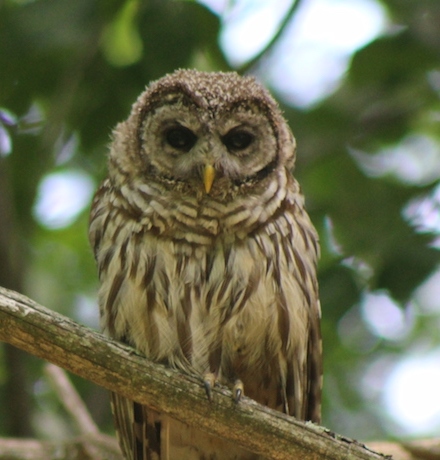2023’s Easter trip saw us near the main road that leads to Mallaig and the ferry to the Isle of Skye. Phil’s invitation can be seen here http://www.phil-broughton.co.uk/Easter/Easter2023/invite.html
We flew to Manchester, rented a car and stayed with Phil Broughton for two nights. As always, Phil was an excellent host. We had dinner at the King Bill (I. E. King William) on one night and the other night Phil cooked sea bass. We followed our normal routine when in the Greater Manchester area i. e. to visit Shaw, where Gordon grew up, to clean up the family grave, then visit long time friends Chris and Heather Beddows in Luddenden where we were entertained royally.
The drive up the M6 on Good Friday was slow because of traffic around the Lake District, but we made it to the Scottish border in reasonable time. However we abandoned plans to visit Wigtown because of traffic near Dumfries. It was far worse for Bob – he spent nearly all day in stop-start driving on the M6. The message is definitely to avoid this route just before Easter. Maybe next year we will leave our time in Manchester to after the Scotland week and fly to Inverness or Edinburgh as we have done in the past.
On our way north we spent a night in Helensburgh for a look at the work that the National Trust for Scotland is doing to restore the Charles Rennie Macintosh masterpiece of Hill House that was built for the publishing magnate Walter Blackie.
That night we stayed at the County Hotel. About 1 mile out of the town centre and run by a Sikh gentleman. It was very nice, modern, and very clean. We liked the vegetarian breakfast. That evening we met up with Bob Ingram and had a first class Indian meal in the town. Helensburgh had thrived as a retreat for Glasgow businessmen in the nineteenth century. It seems to be surviving OK now, but is probably not as wealthy as it was in Victorian times.
On Saturday 8 April the three of us went to Hill House after first stocking up with food for our contribution to the evening meal on Monday. The building is being seriously damaged by the Scottish weather so saving it from moisture is a high priority, a structure has been constructed to give protection and allow the house to dry out before using modern materials to replace the outside coating from the late nineteenth century. The project is expected to take of the order of 15 years.
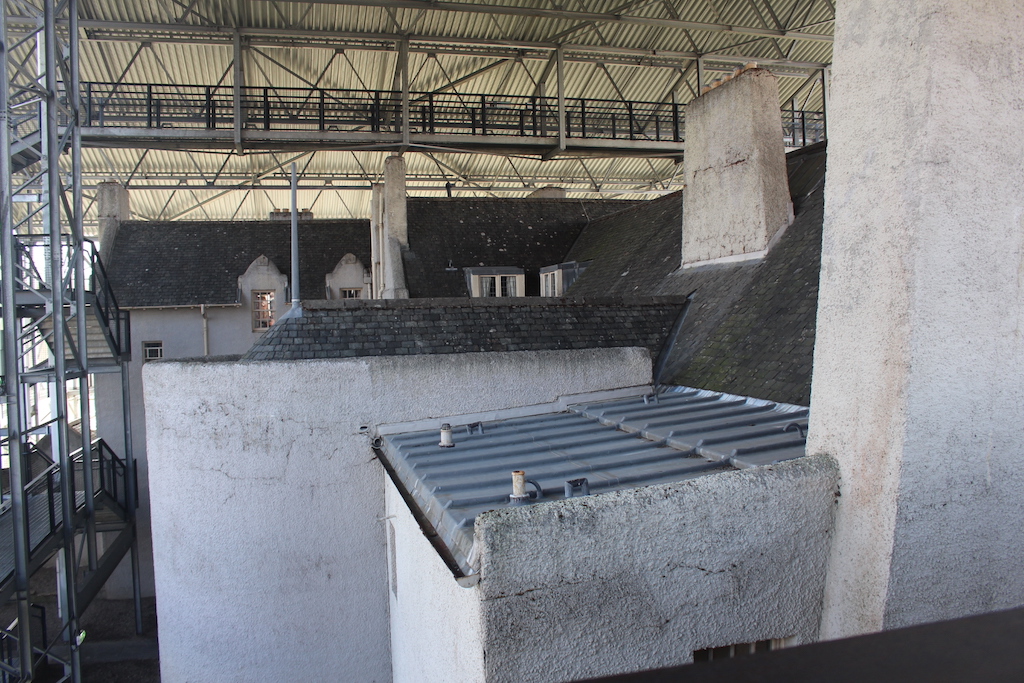
There are walkways that allow visitors to see the building from above.
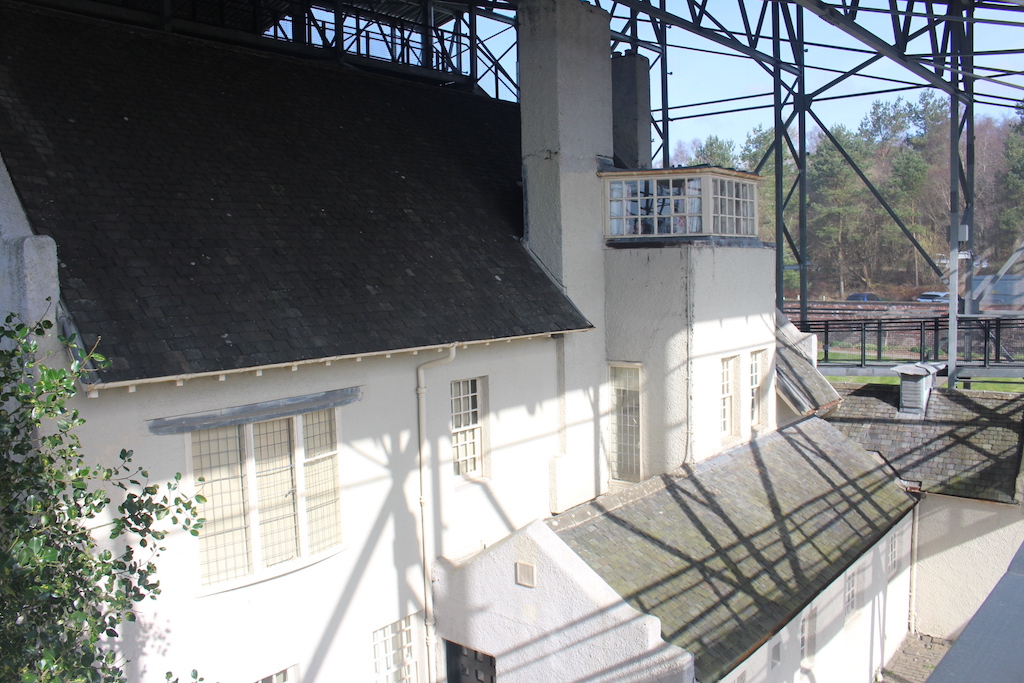
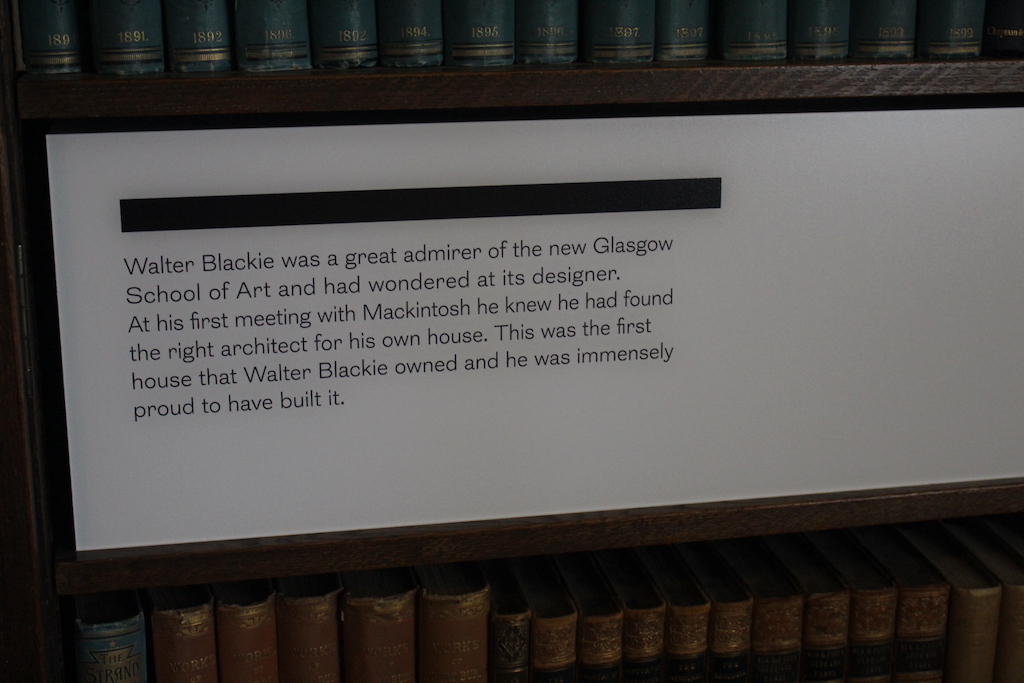
Mackintosh design is everywhere.
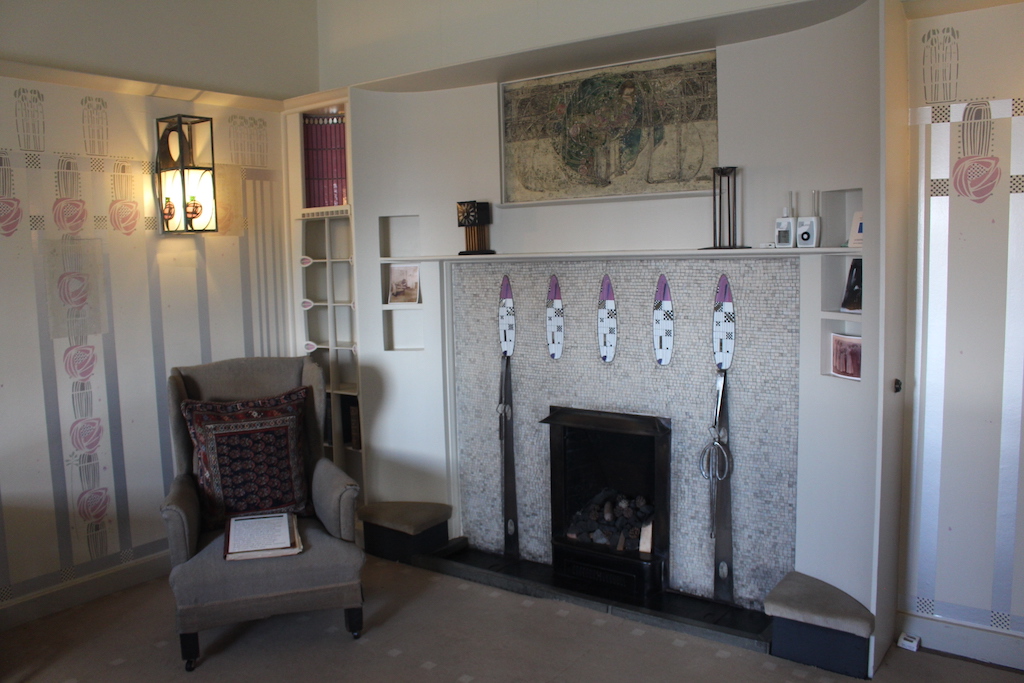
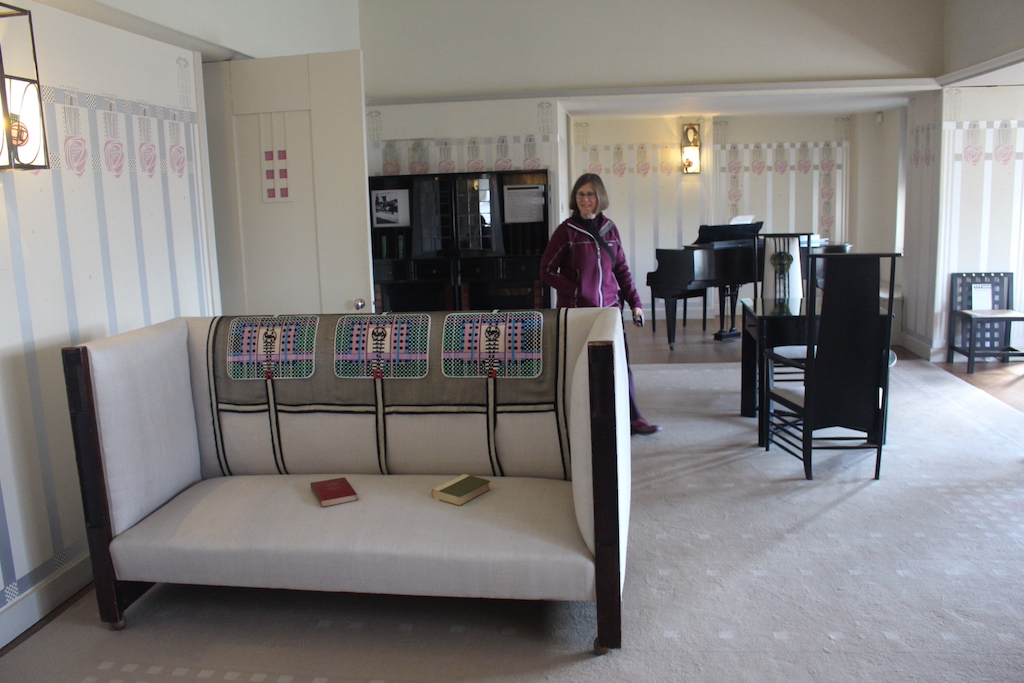
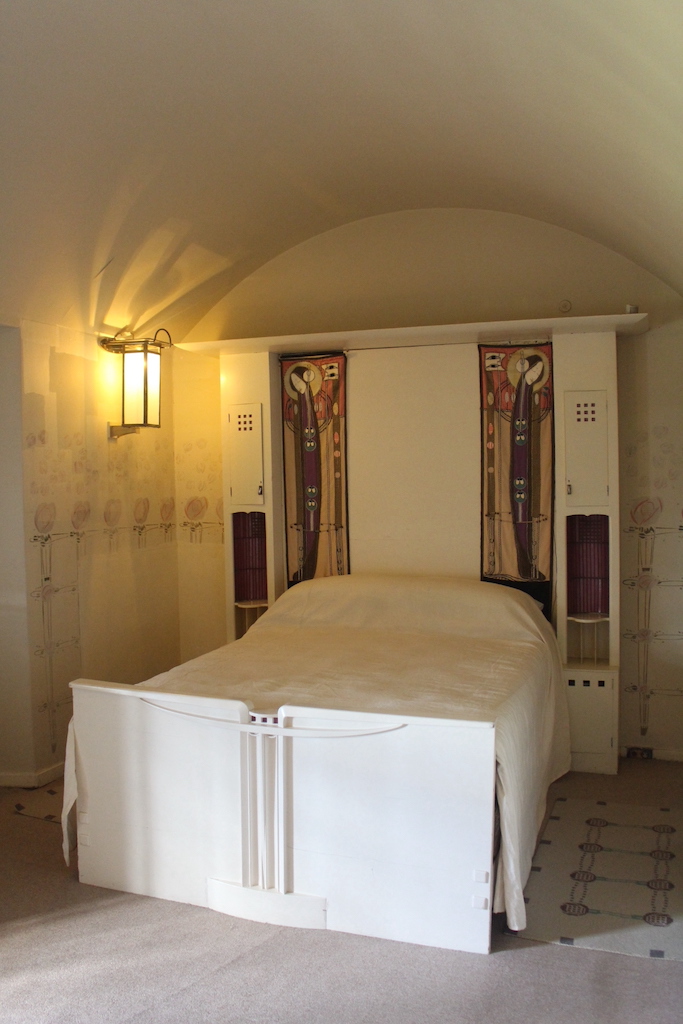
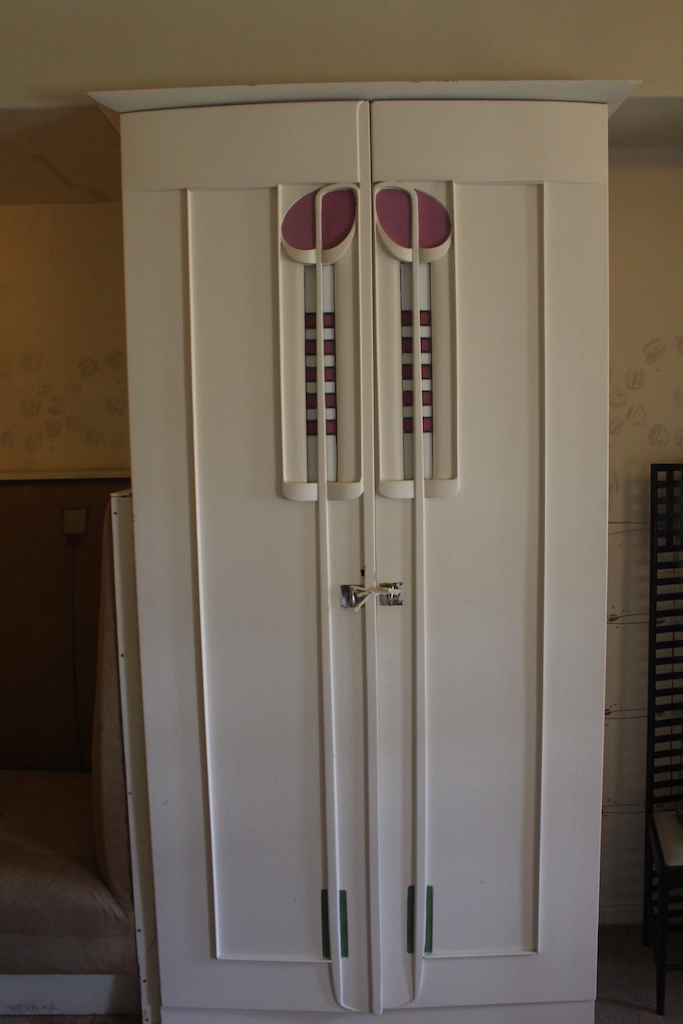
The old plumbing is still in place.
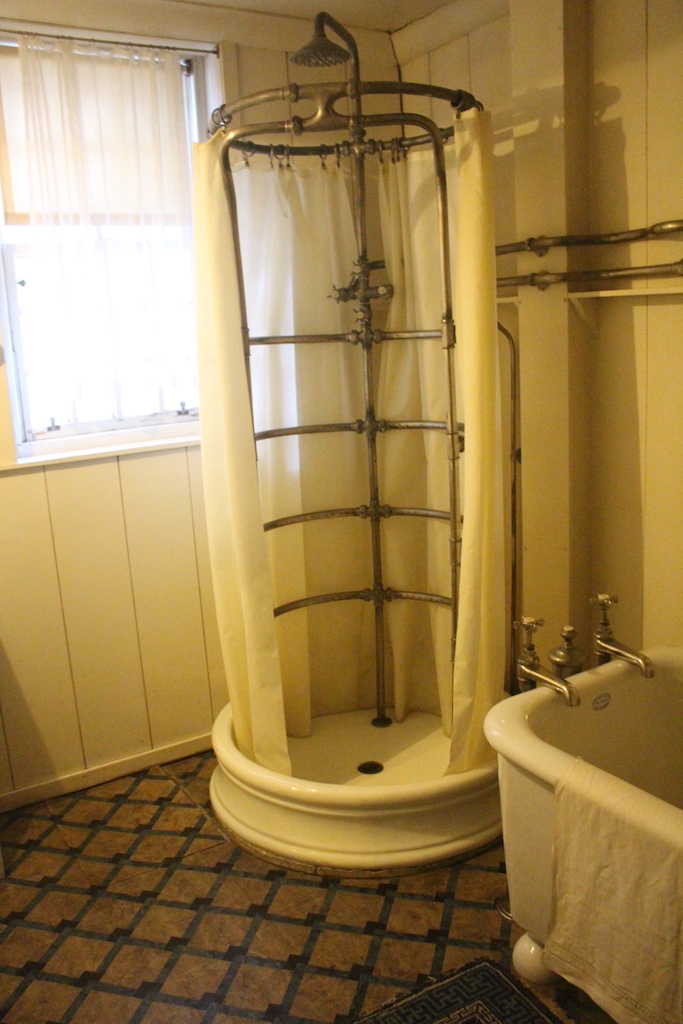
Our accommodation in Arisaig was within walking distance of the village hall where we had our “base” and our evening meals. On the first evening this stag was watching us from a parking area. It had no fear of us.
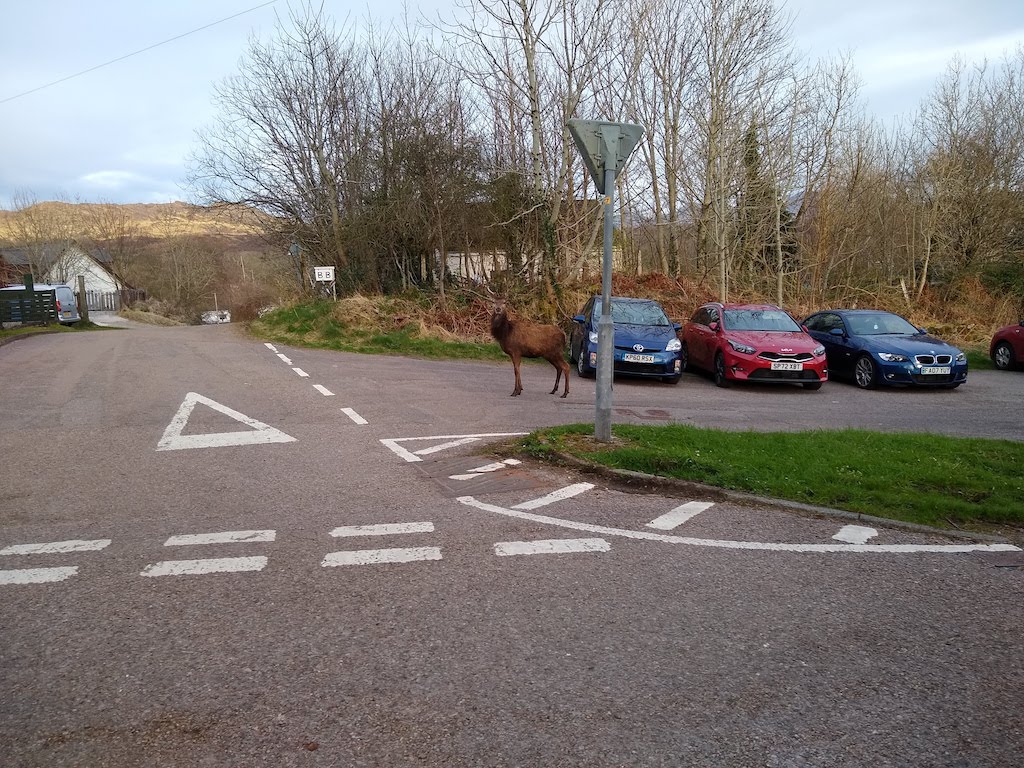
There are no pictures from the disastrous attempt on Gulvain in Sunday 9 April. Gordon was absolutely done in and as usual extremely slow in descent. He should have learned by now that 1300 metre climbs on the first day are not a good idea for him, especially with a long walk in (and out) with a 45 mph wind on the summit ridge.
On Monday 10 April, we were preparing dessert. We stayed in bed, had a cooked breakfast and did some shopping, spent time washing berries, etc. The day seemed to vanish. At the end of the afternoon, Bob joined us for assembly of our version of Eton Mess for dessert that evening.
On the next day, Tuesday 11 April, we stayed near Arisiag and had a very nice walk out to some nearby gardens called Larachmhor. First, however, we looked in at the visitor centre and watched a video about the island of Eigg. Preparation for the following day when we hoped to take the ferry for a 5-hour visit to the Island.
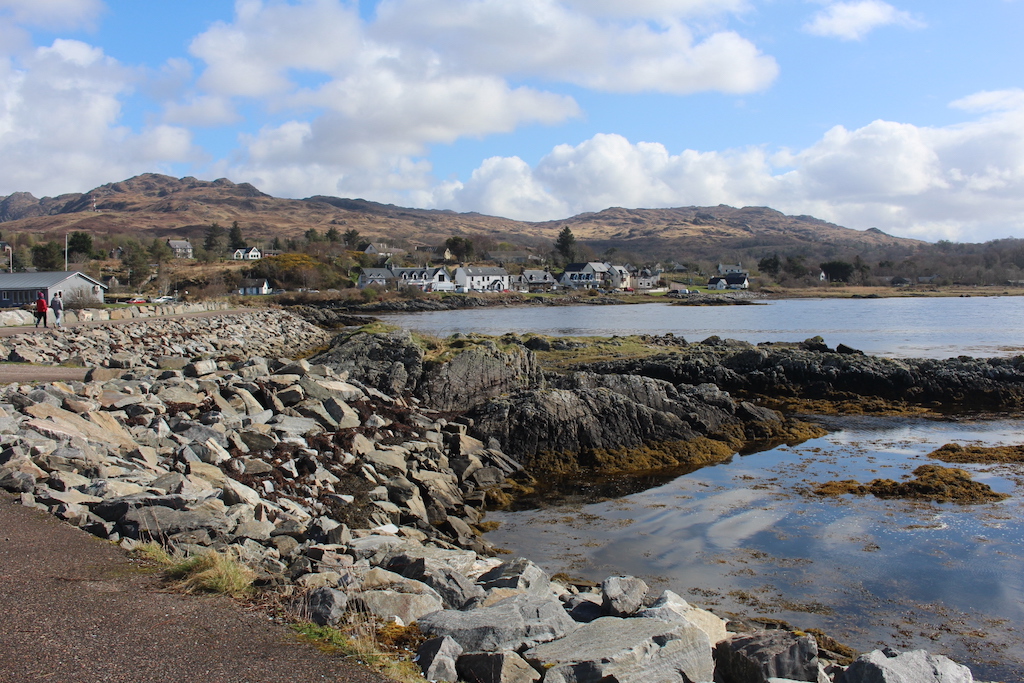
The sea loch at Arisaig.
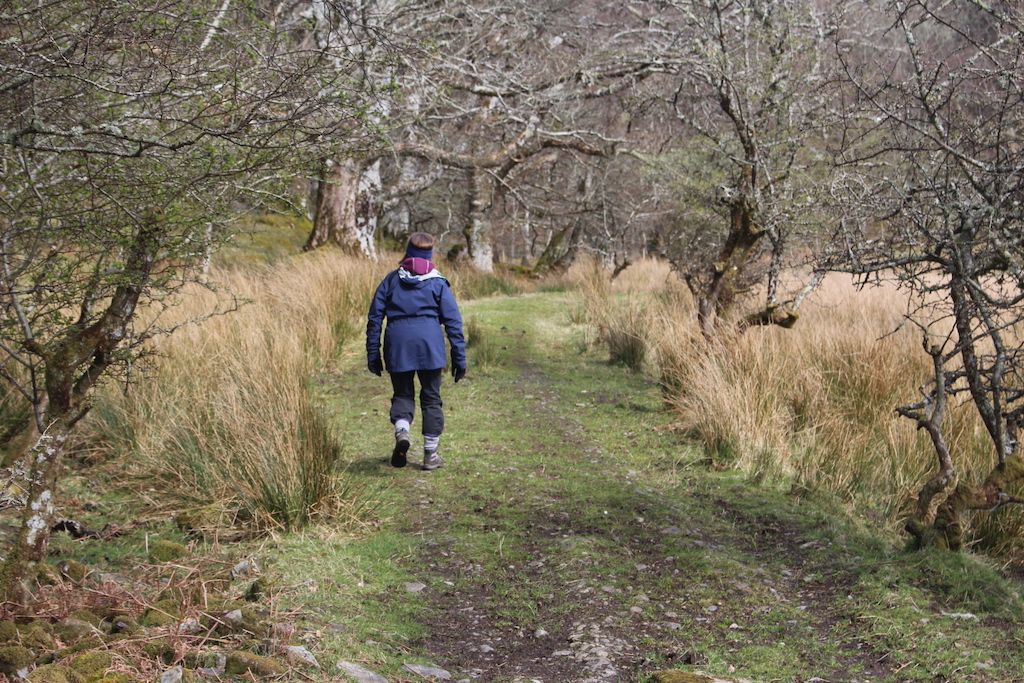
A walk out from the harbour along a farm track through some fields.
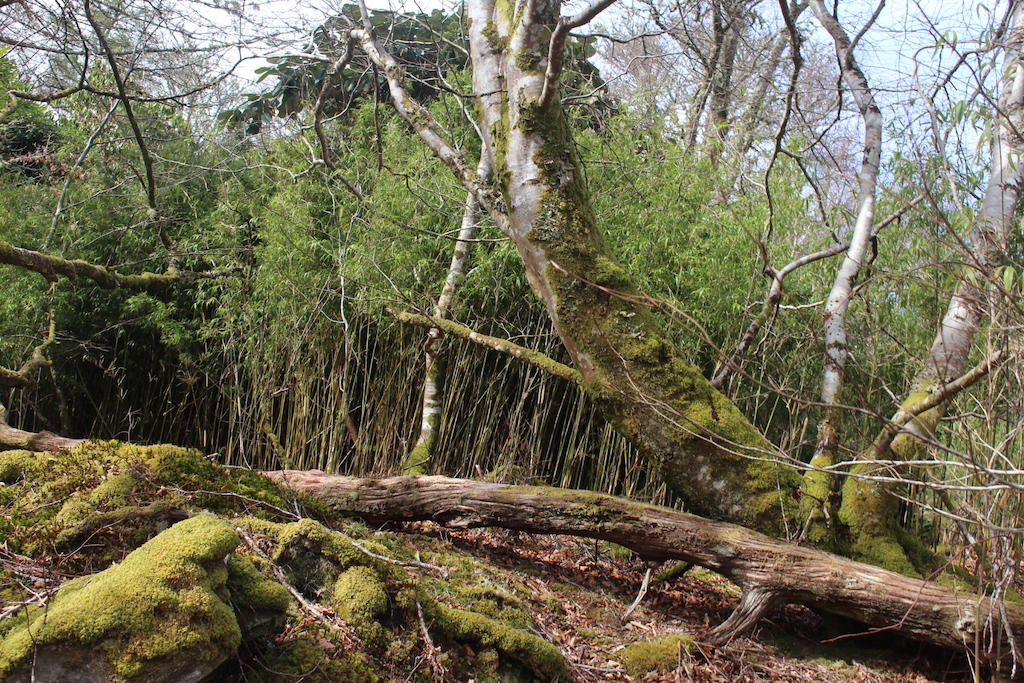
Bamboo spreading from the gardens. The place is maintained by volunteers and they plan to get this under control.
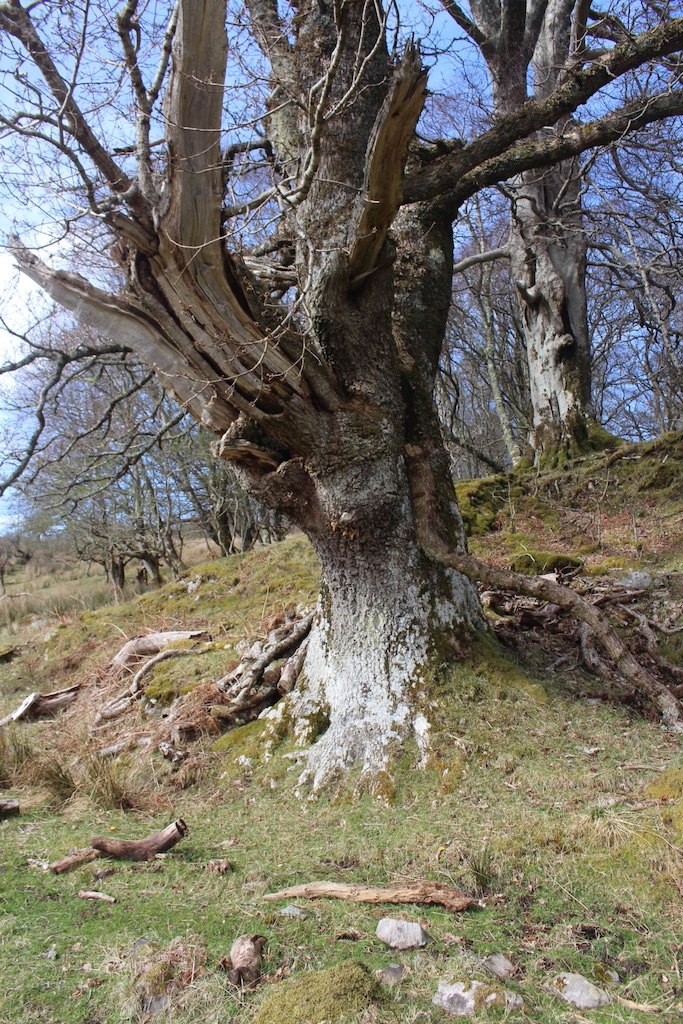
Nice trees next to the track.
We took what turned out to be an unofficial route, because what seemed to be a track into the gardens on the OS map turned out to be blocked by a fence and if there had been a pathway it was heavily overgrown on the inside of the barrier. In the end we came across a place where a tree had fallen and broken the fence. We crossed at that point – it involved walking along the trunk of the tree.
The main route through the gardens was just beyond some bushes – no problem and we didn’t disturb anything.
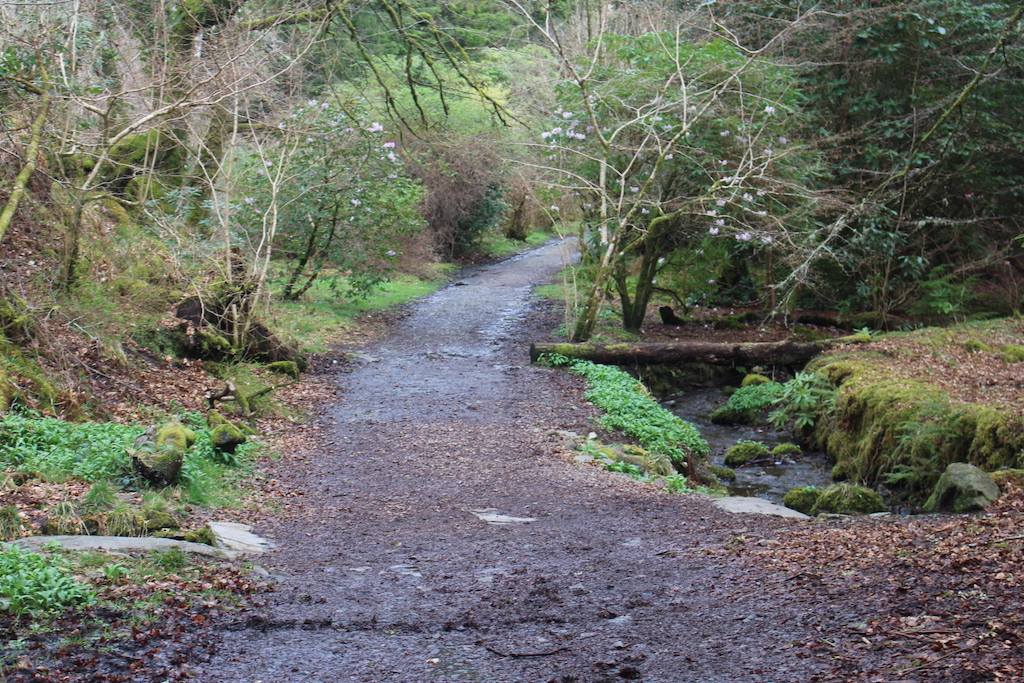
There is a central track through the gardens.
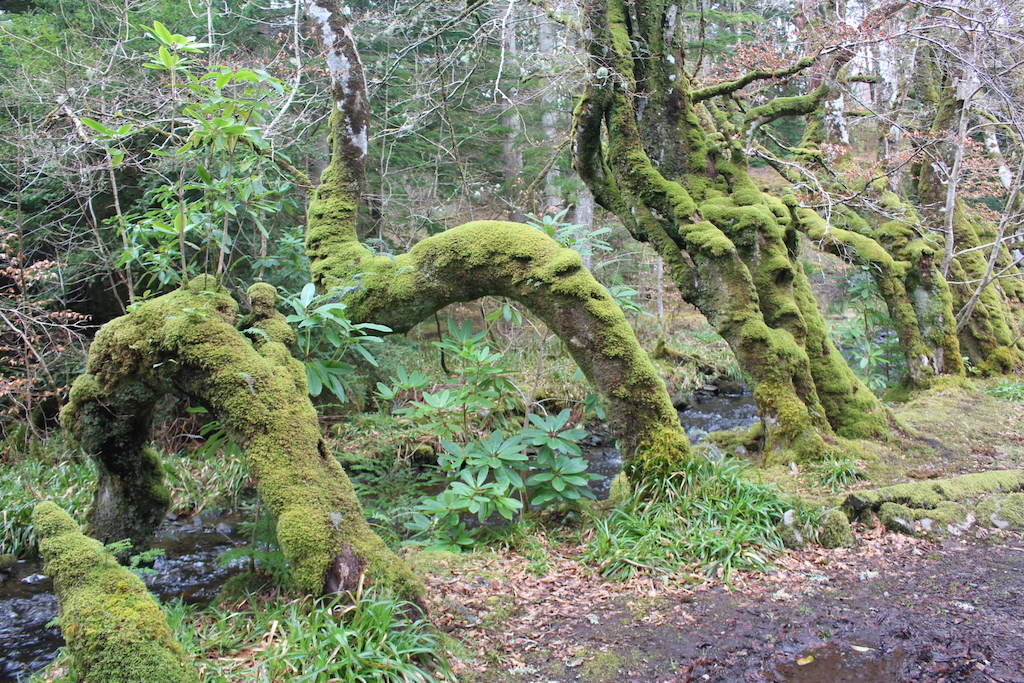
Many interesting shapes.
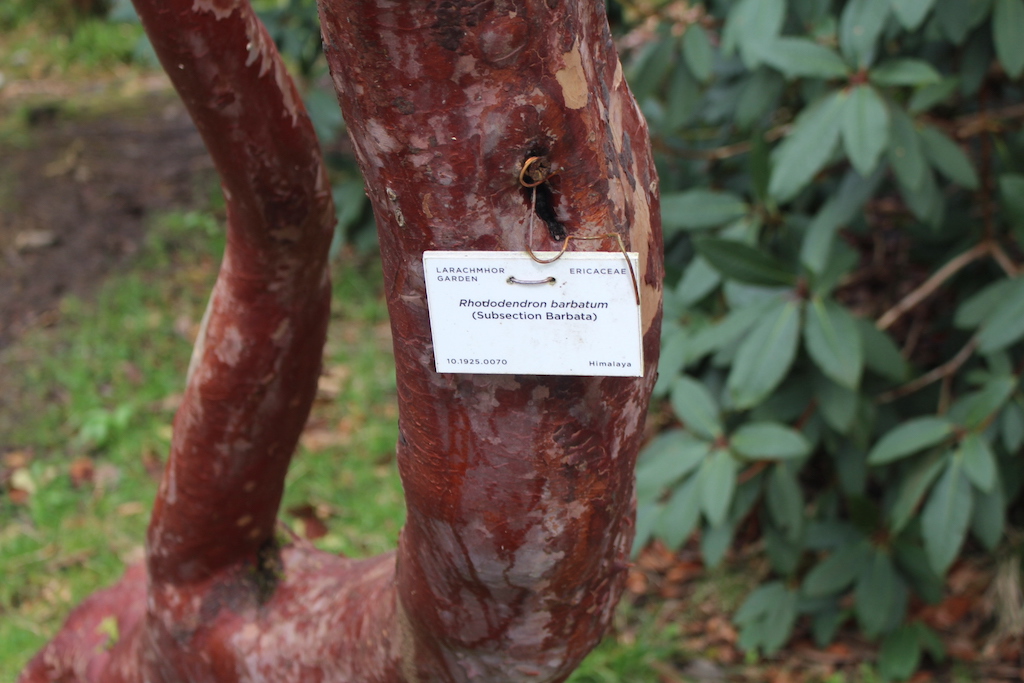
This red rhododendron was impressive.
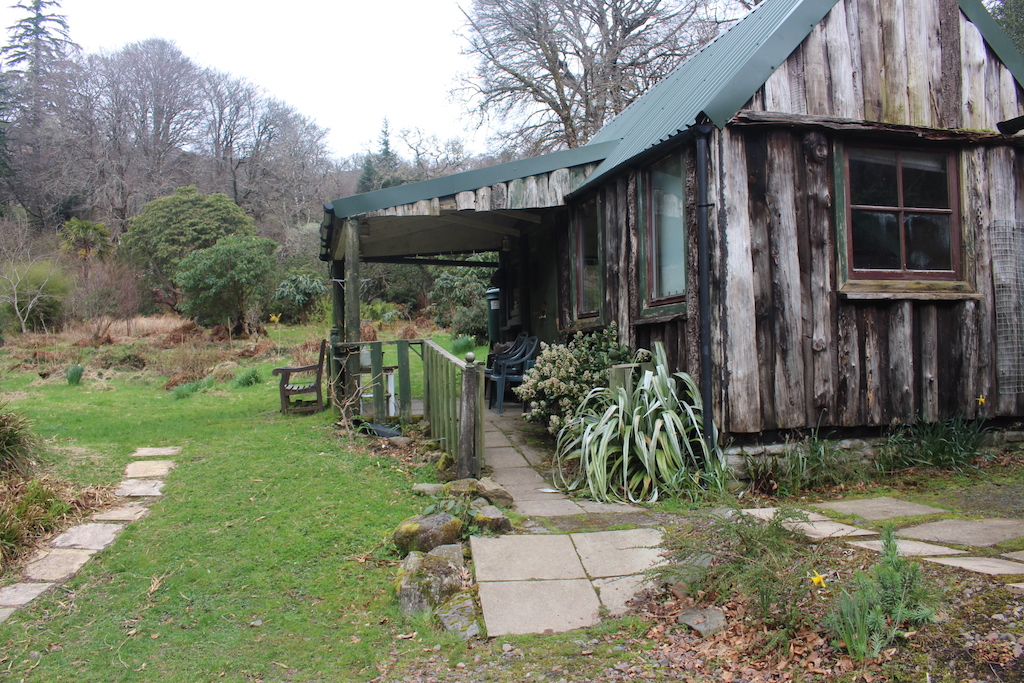
We followed much of the track which eventually led to a loop path and an indistinct, but mapped route along a burn dropping down to the main track.
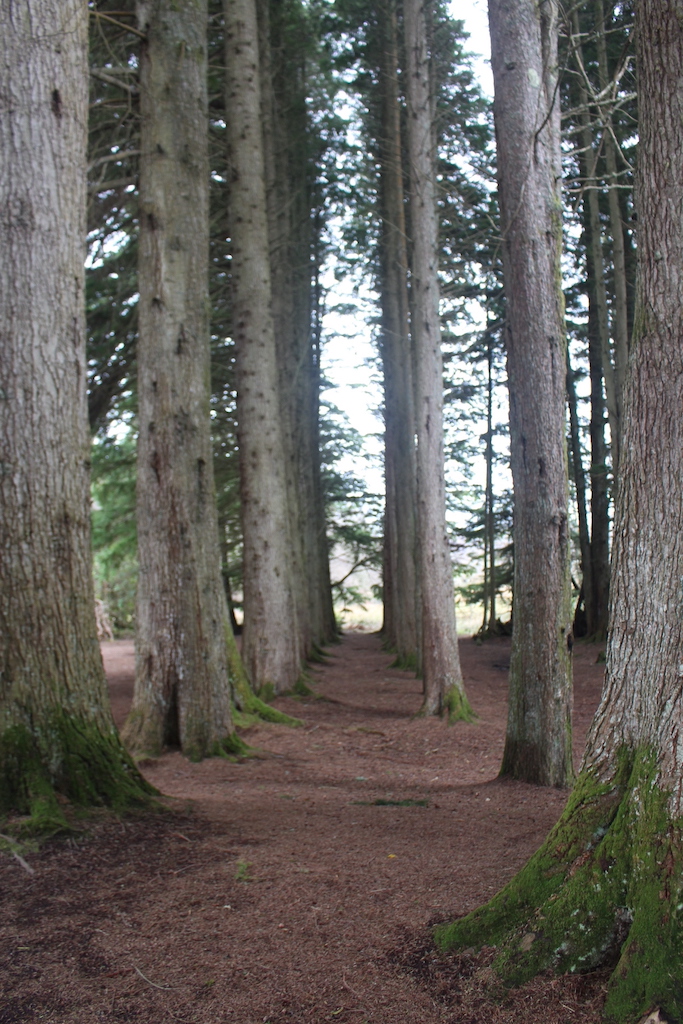
We liked this grove of conifers that we passed on the way out. Not sure of the variety.
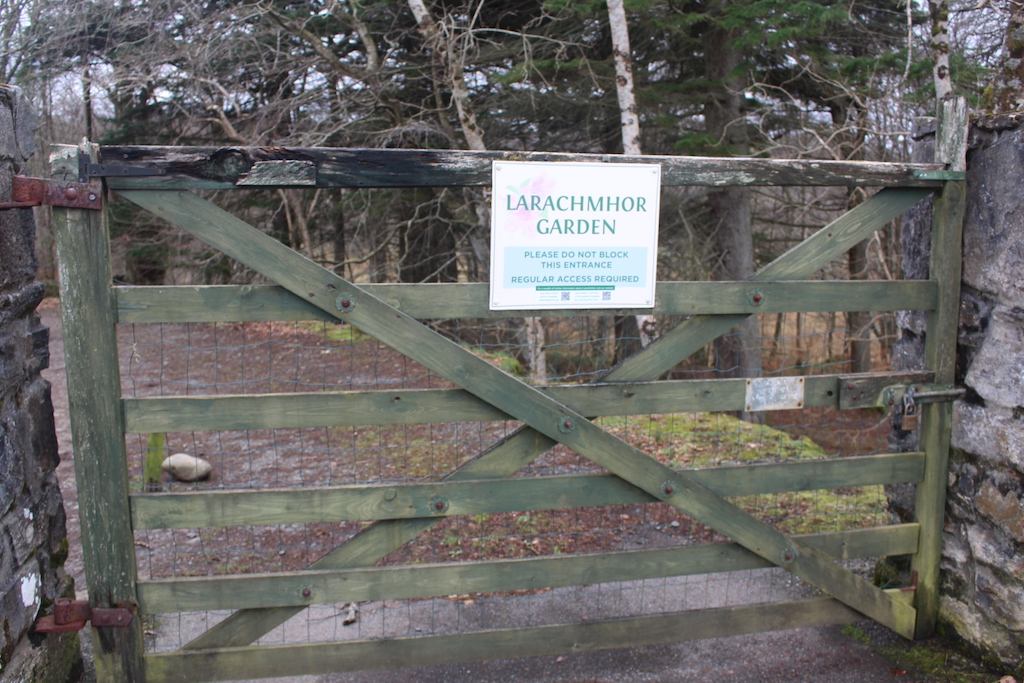
The gardens were build by a prominent Victorian family. Their house has been demolished, but there are remnants of it on a side path.
After dinner, we decided to join the party that was intending to take the ferry to Eigg on the following day. We half-expected that the boat would not sail because the weather forecast was not good. It turned out to be an adventure to say the least. All I can say is that many people were seasick and buffeted all over the boat. The dogs that joined us were scared and one of our number burst into tears. The 1-hour trip to the island was OK if somewhat choppy, but the return was extremely rough. I suspect that if the ferryman had not had the responsibility of possibly marooning us on Eigg and/or probably loosing a lot of money with the cancellation the trip would have been not have gone ahead.
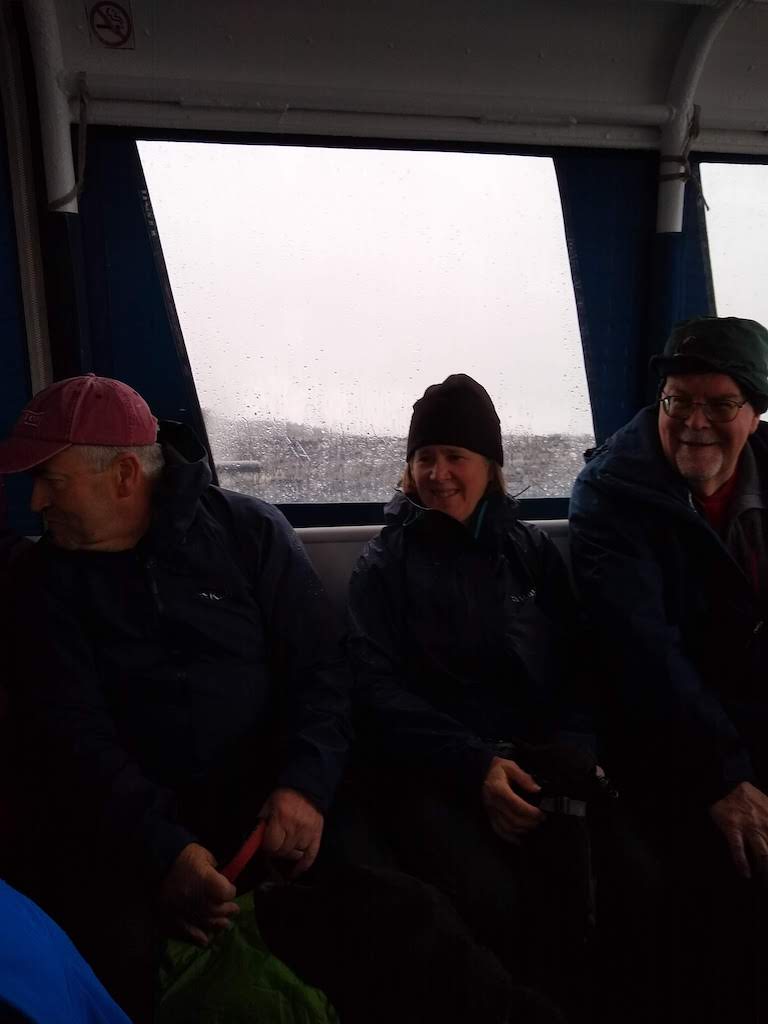
On the island, it rained, and rained and the wind blew. All of us stopped for tea and snacks in the cafe at the ferry pier then some brave souls set out to climb the prominent “Sgurr”, but Betsy and Gordon walked across the island and stopped at the brewery where they bought some beer (of course).
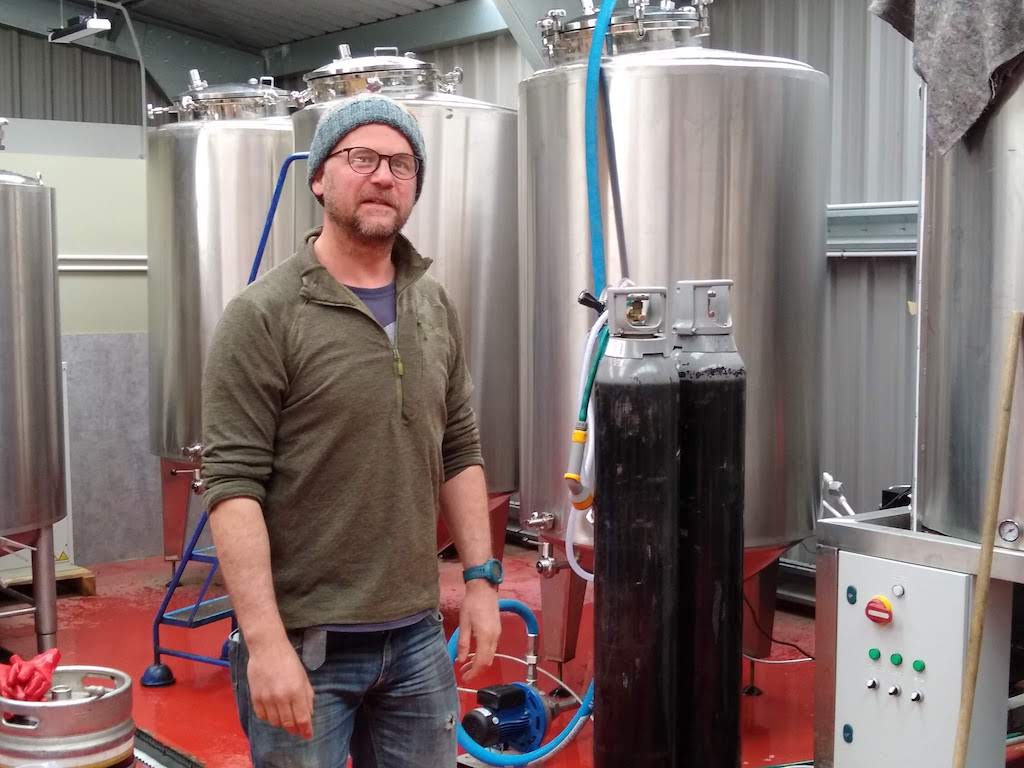
The brewers were happy to have their photo taken, and happy for us to take a couple of beer mats. Technically they were shut, but because the weather was so bad they allowed us some respite indoors before we set off for the wet and miserable walk back to the ferry. There was an hour or so to wait in the shelter of the building so we ate our sandwiches and drank tea.
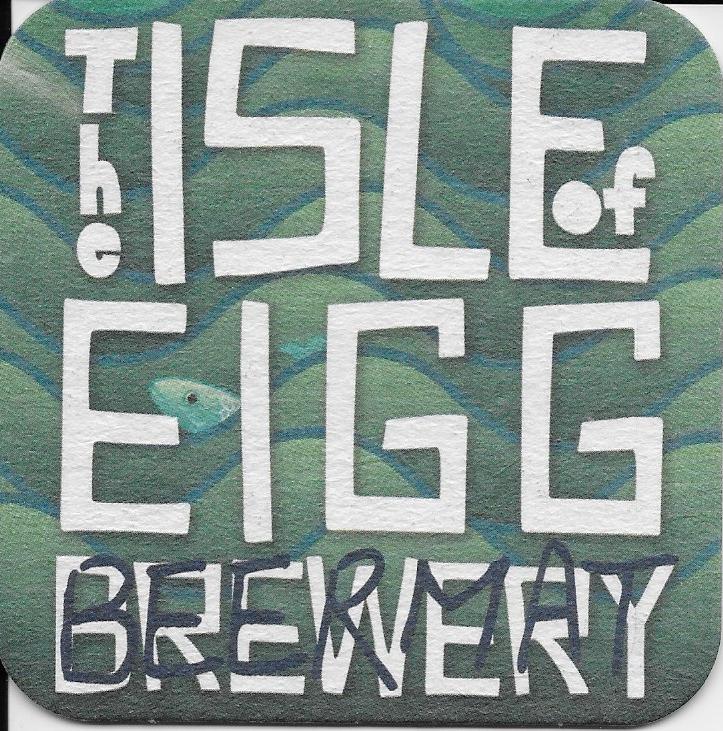
On the day after another adventurous and exciting outing, we chose to make a simple trip to Mallaig for some easy walking and sightseeing on Thursday 13 April.
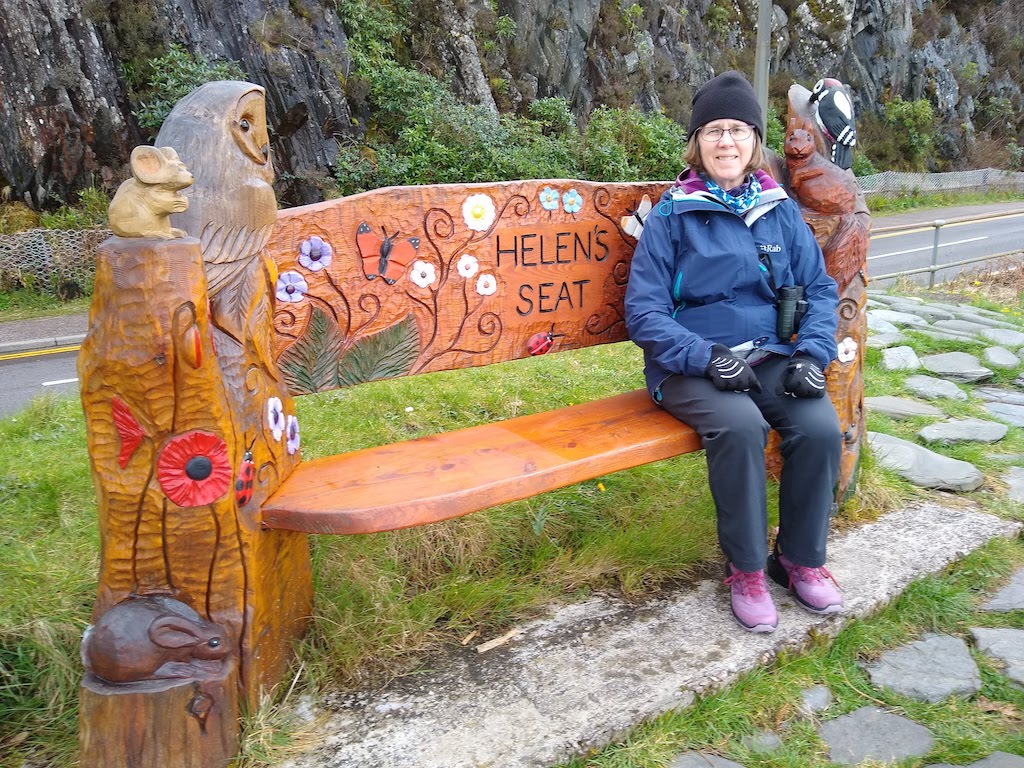
We followed a walk recommended by Walkhighlands.co.uk out of town for a circuit of some nearby hills. As we approached the start of the route we came across this bench with a view out towards the Isle of Skye. We have no idea who Helen was, but it reminded us of wood sculptures that we had seen on Skye a few years previously.
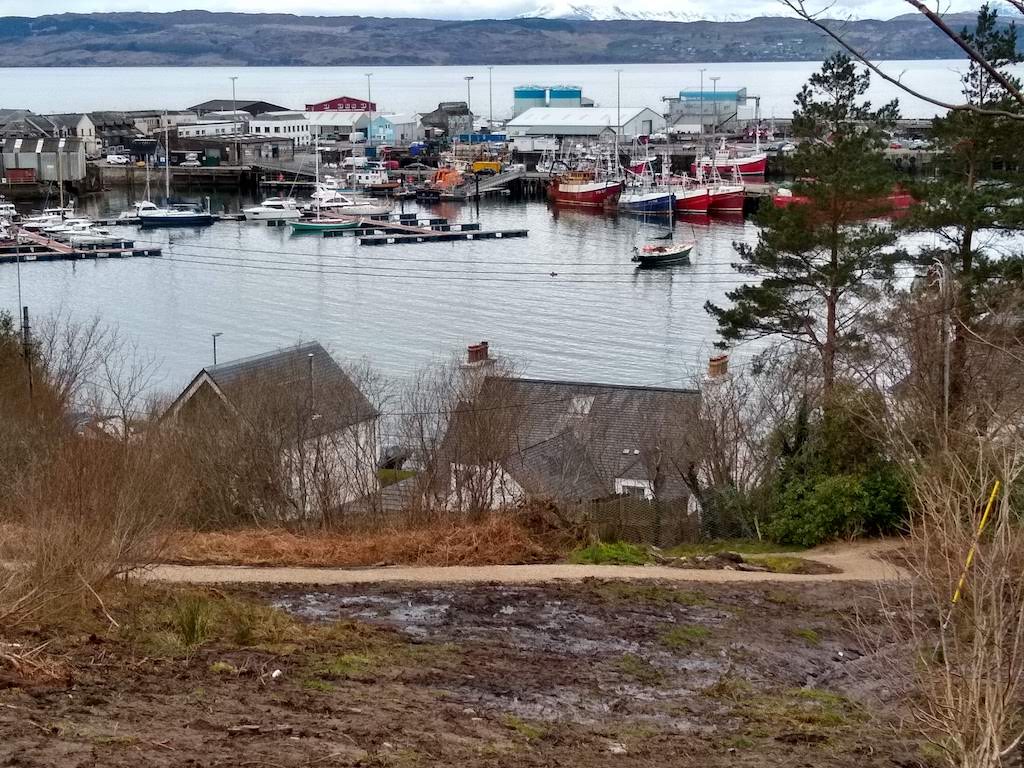
As we looked back there was a view towards the harbour and the CalMac ferry terminal.
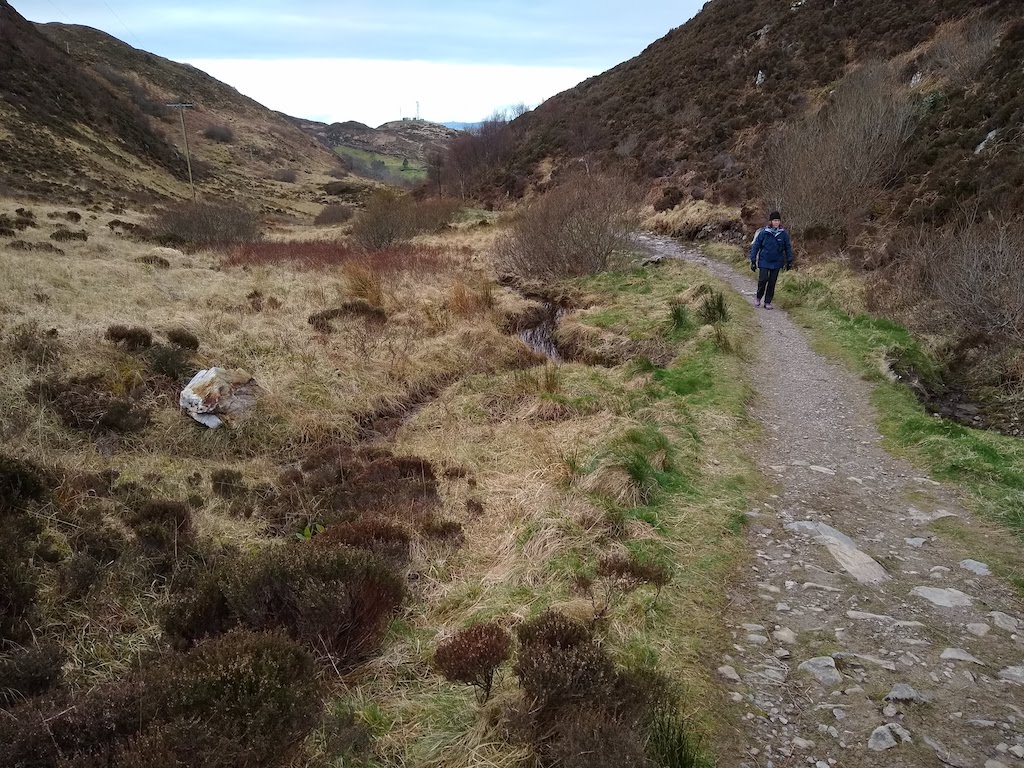
Soon the path climbed into a glen with several connections to longer paths into the nearby hills.
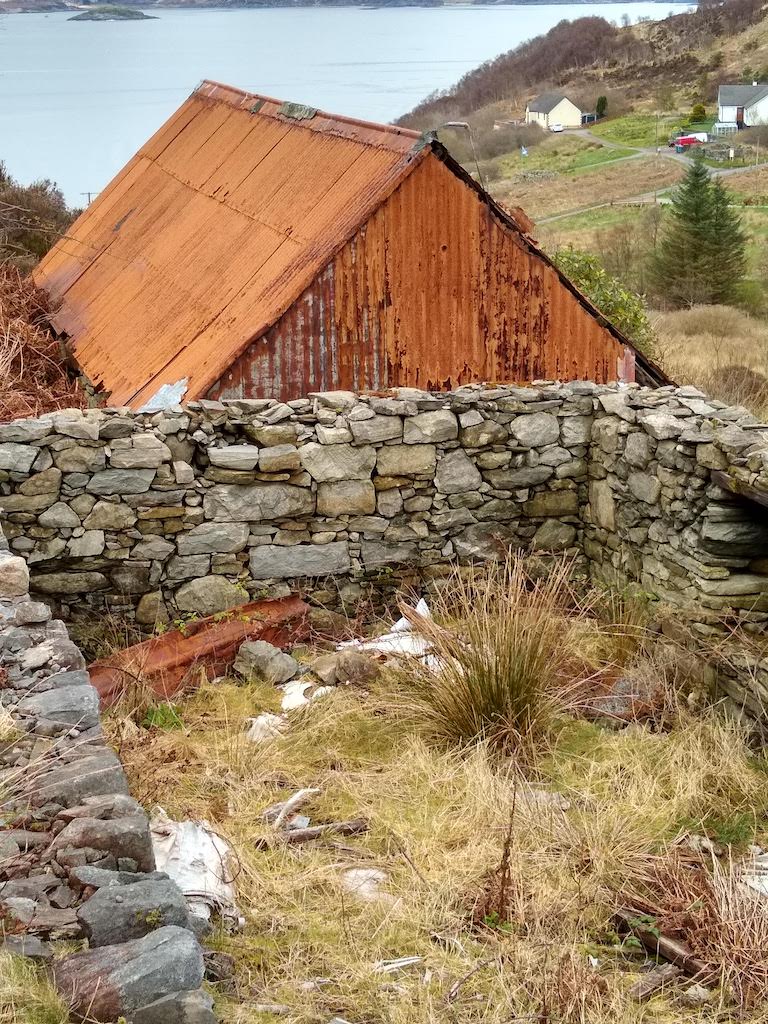
Eventually we descended back toward the loch passing some ruined crofts.
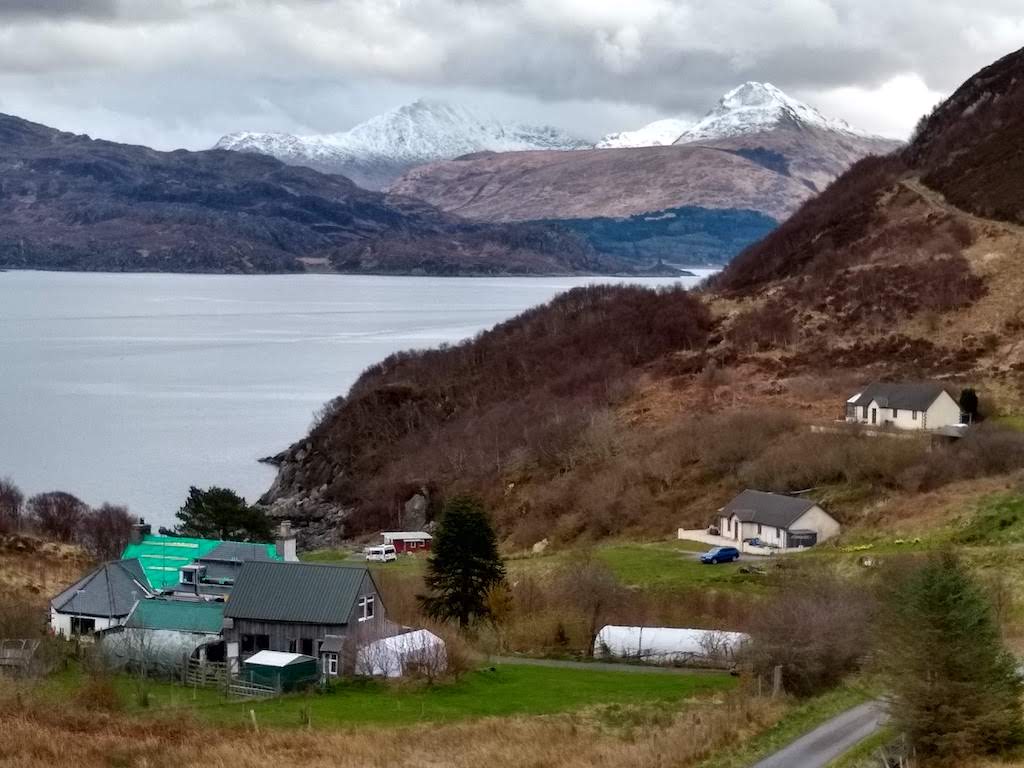
A spectacular view towards the remote village of Inverie and the Munro in that area. The The most convenient way to get to Inverie is by a ferry from Mallaig that runs several times a day, but it can be a challenge to climb the Munro on a day trip. The alternative to the ferry is a long walk requiring an overnight stay – camping or at the hotel/B&B there.
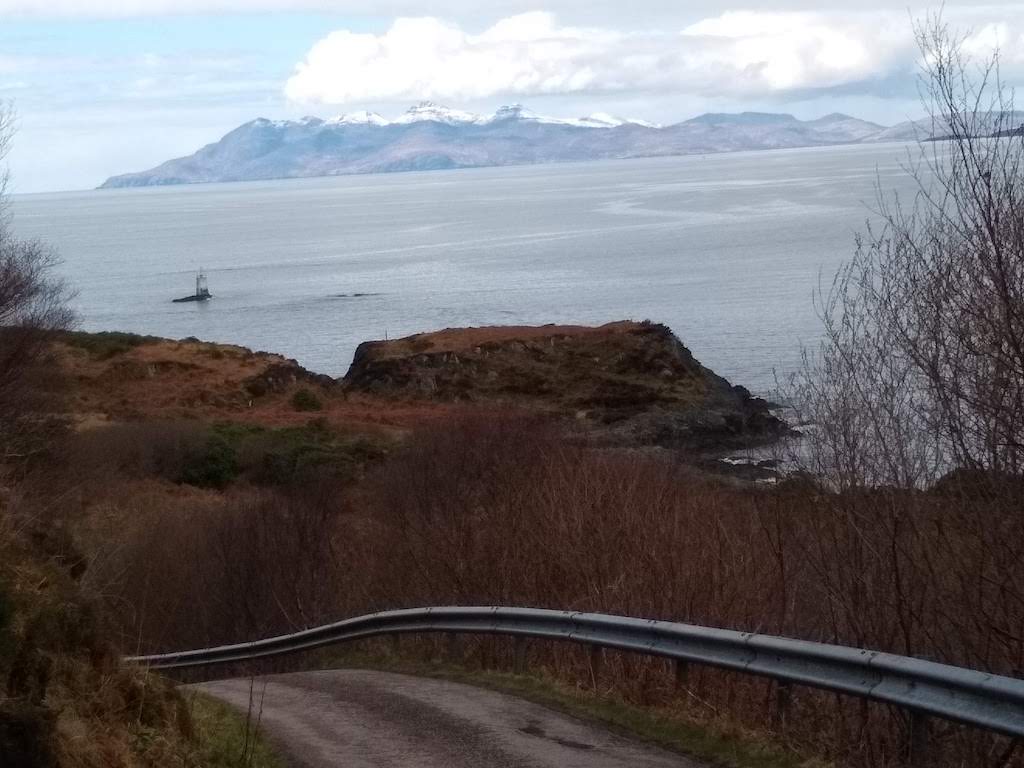
Then there’s the view out to Skye and the Cuillins.
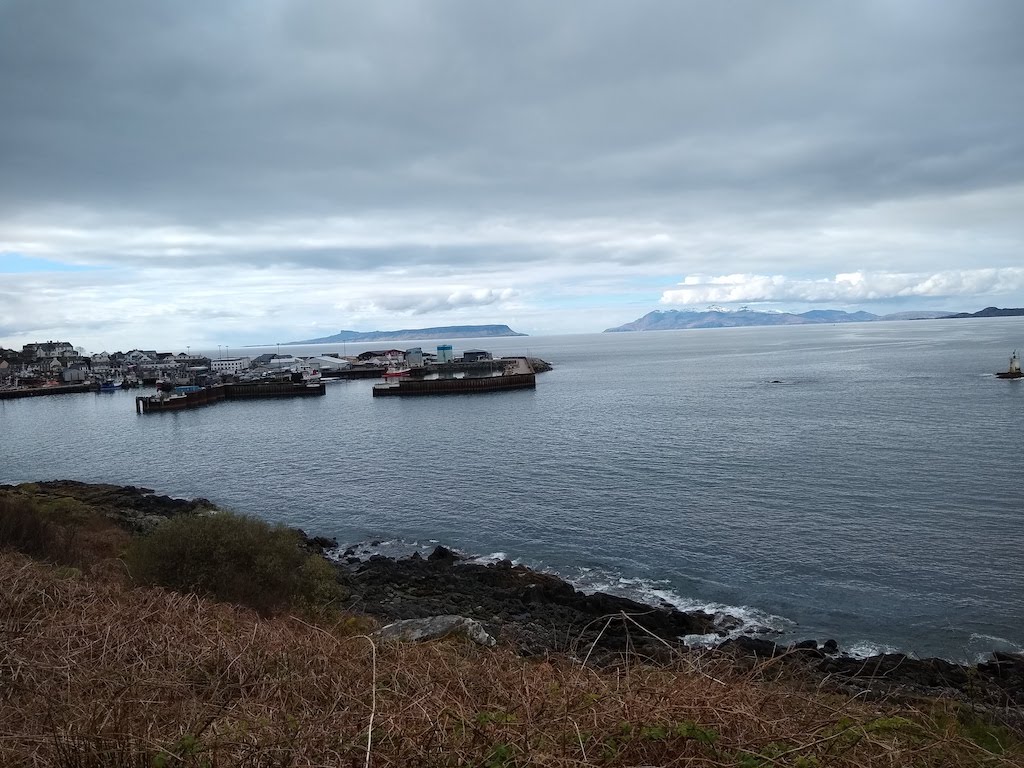
The islands of Eigg (on the left) and Rum are easy to see. We visited Rum on our trip in 2009.
While we were on the walk, the Jacobite steam train had arrived from Fort William carrying its load of tourists, rail enthusiasts and Harry Potter fans. The town was full of them. Of course, we had to wait for it to set off on its return journey, and take a video…
After Mallaig, we took a side trip to look at one of the houses that had been rented for our group – Traigh House. This was the largest and accommodated about 17 people.
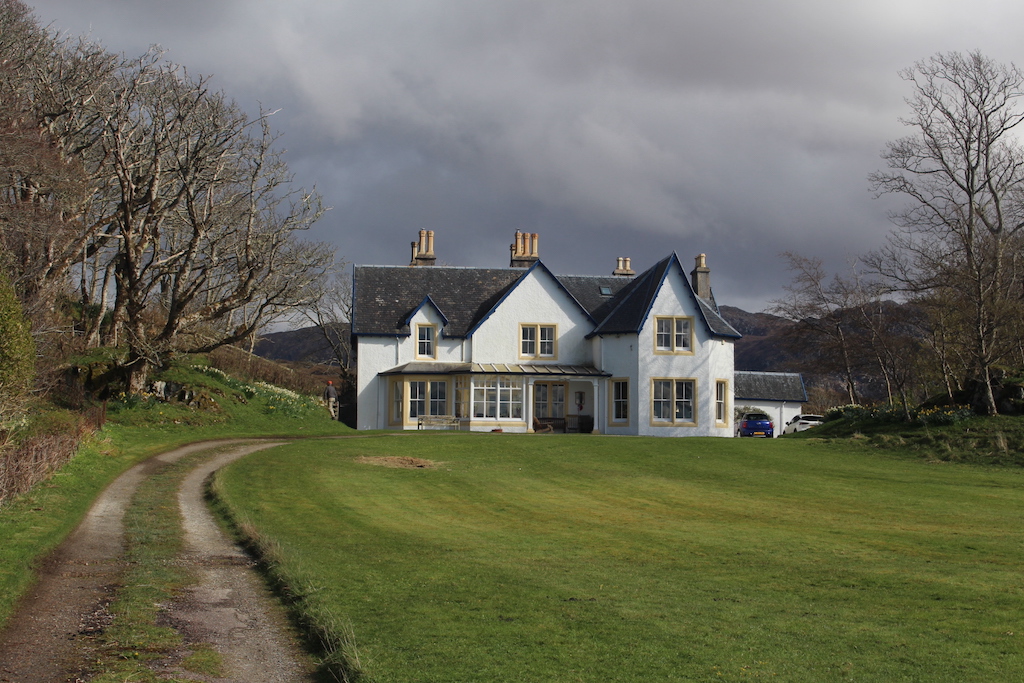
We looked around the house and were impressed by the size and the facilities, and by the location, just a few yards from the beach across the road. The view over the water to the islands was outstanding. Eigg, Rum and Skye were clearly visible.
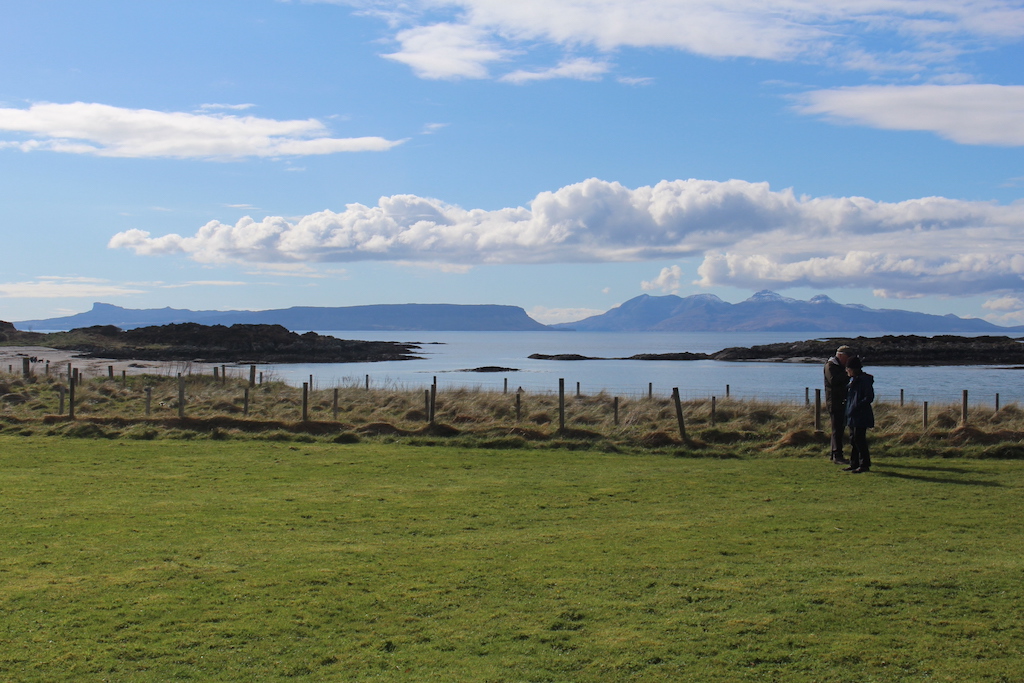
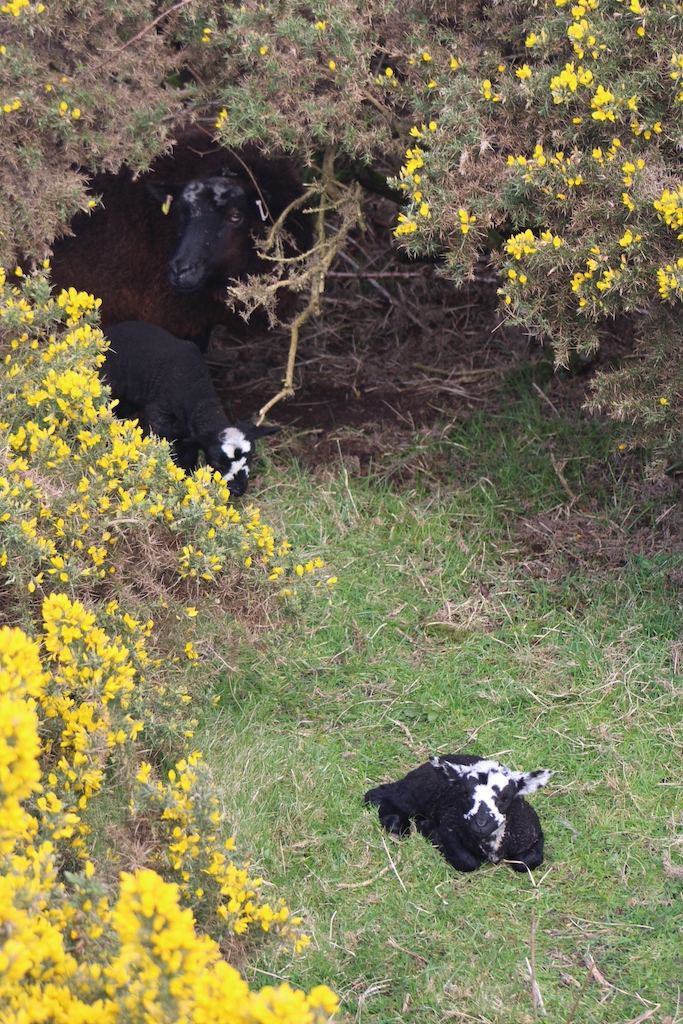
After exploring the beach, we walked back to the house and passed a newly born lamb, its sibling, and its mother carefully hidden in some gorse bushes. It was a good spot because young lambs are easy prey to birds like crows, ravens and rooks that will peck out their eyes. A woman was standing by and she explained that it was from her flock and that she was checking up in it. the birth had been the night before.
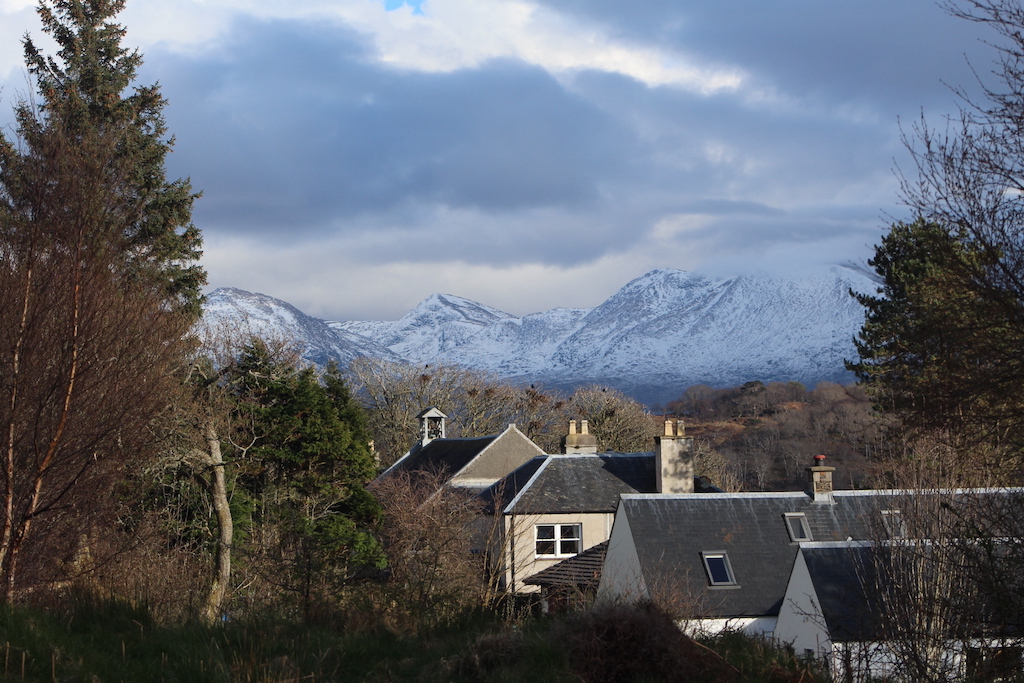
On return to Arisaig, Gordon took a couple of photos of the view from the garden at our house and a picture of the house itself,
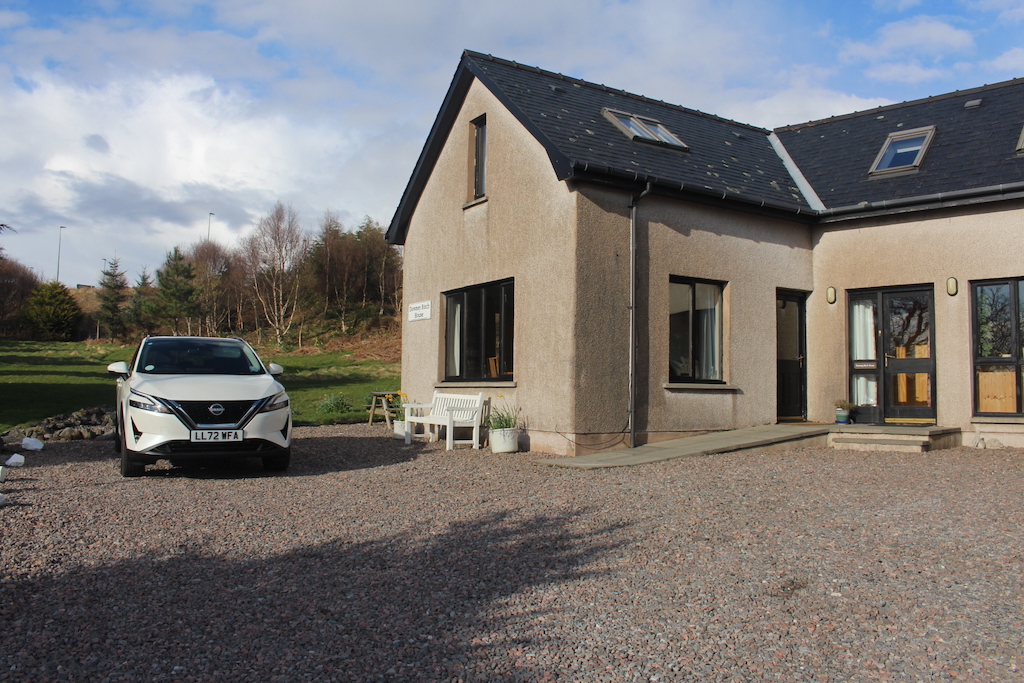
Our accommodation was in the left wing of the house. The owners were in the other part. We had the upstairs attic, Tom and Tim Vandenberg had the downstairs bedroom. The dining area and kitchen were downstairs.
Our rented car can be seen here. It was a Nissan Qashqai. An SUV and larger than we had ordered. We had been persuaded to upgrade by the Avis representative at Manchester airport. It was fine and the gadgets were very good especially the backup camera with drone view and various warning sounds, but it was far more than we needed and cost more than we planned, but we enjoyed it and it was comfortable for long journeys. Next time we will be less willing to be pushed into spending extra money.
That evening we were on waiter and dish washing duty. A big task for 39 people with no dishwasher. Tom did sterling of the sink work while others dried and put things away.
Friday 14 April. Our last day. A big mountain was out of the question, so we followed the example of another group and used the out and back path to Peanmeanach village (actually a bothy and not much else) and beach. A nice rolling walk, but very wet with uneven rock underfoot. Diligence was needed for the whole walk including crossing a burn on what were supposed to be stepping stones, but because of the recent rain this was more like a ford.
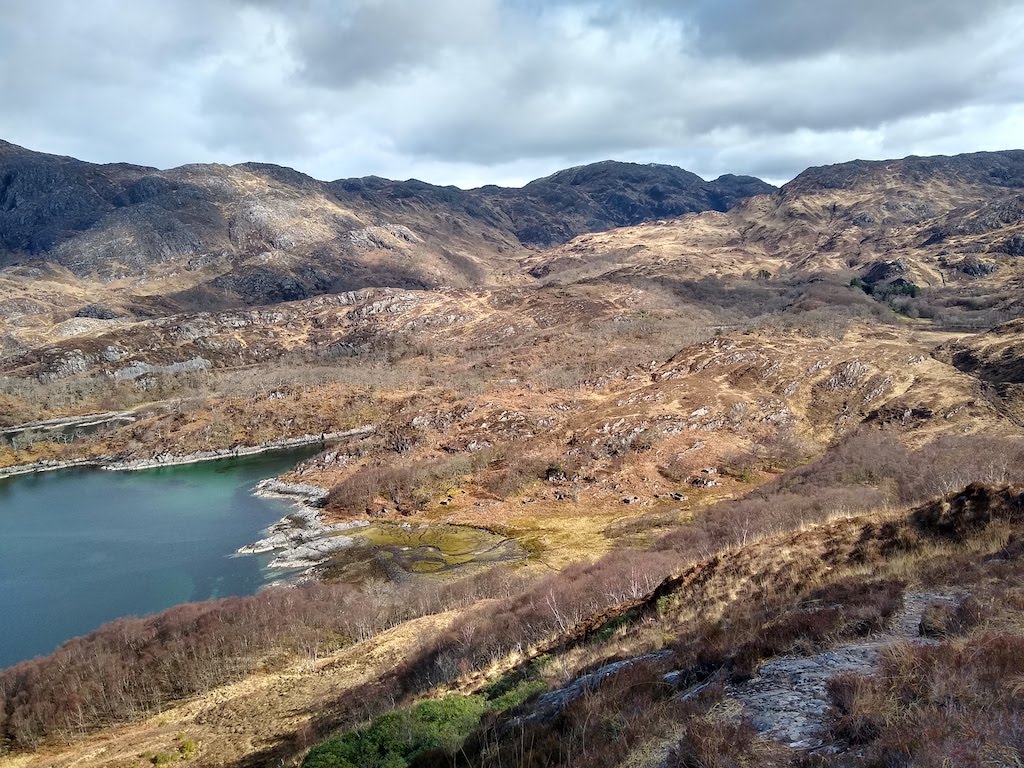
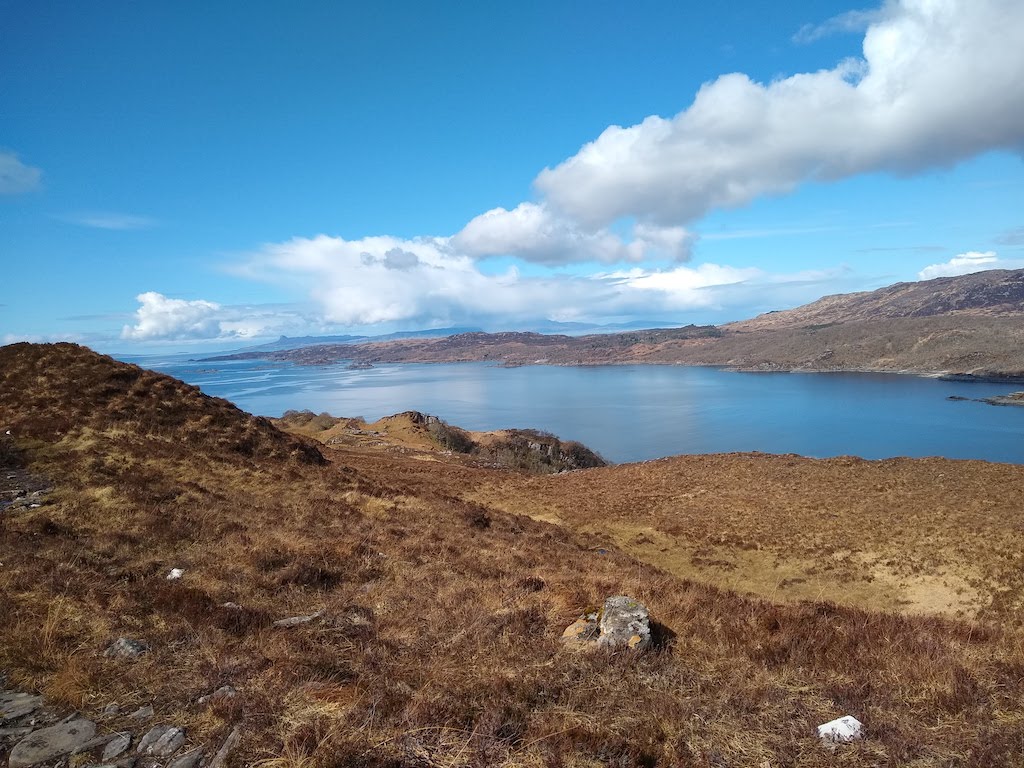
View across Loch Beag and out towards Loch Nan Uamh and the sea.
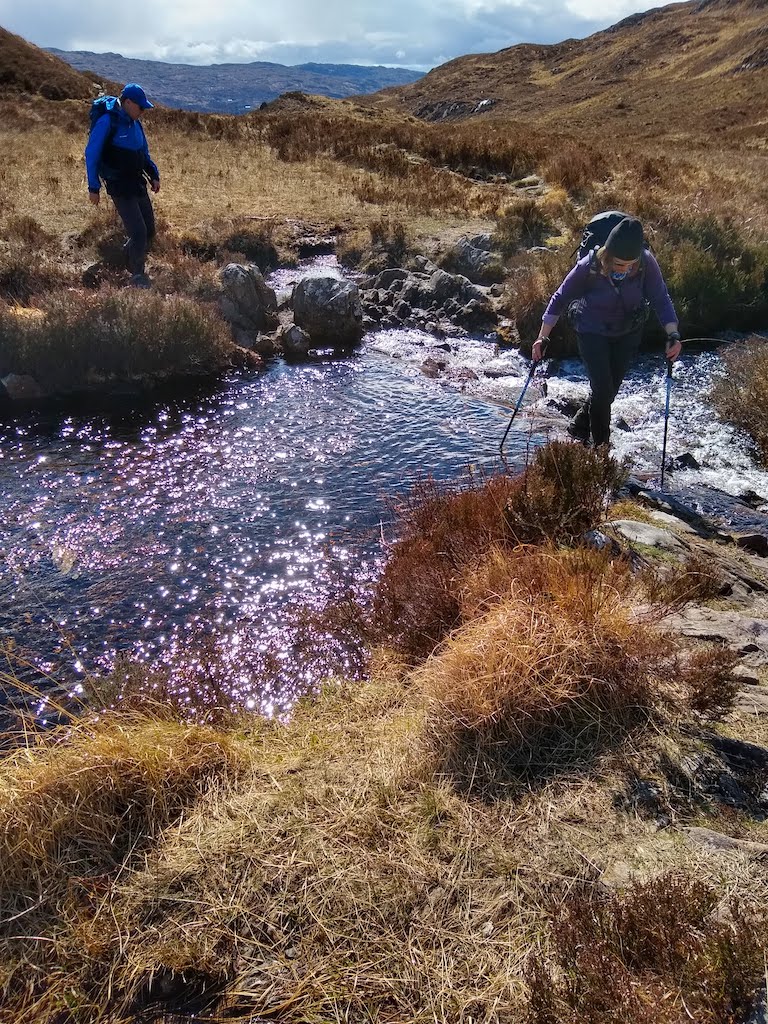
Crossing the burn.
The final part of the walk out was across a very flat area of reeds. There was a track that was obviously man-made and avoided the marshy terrain on both sides, but there were some wet sections.
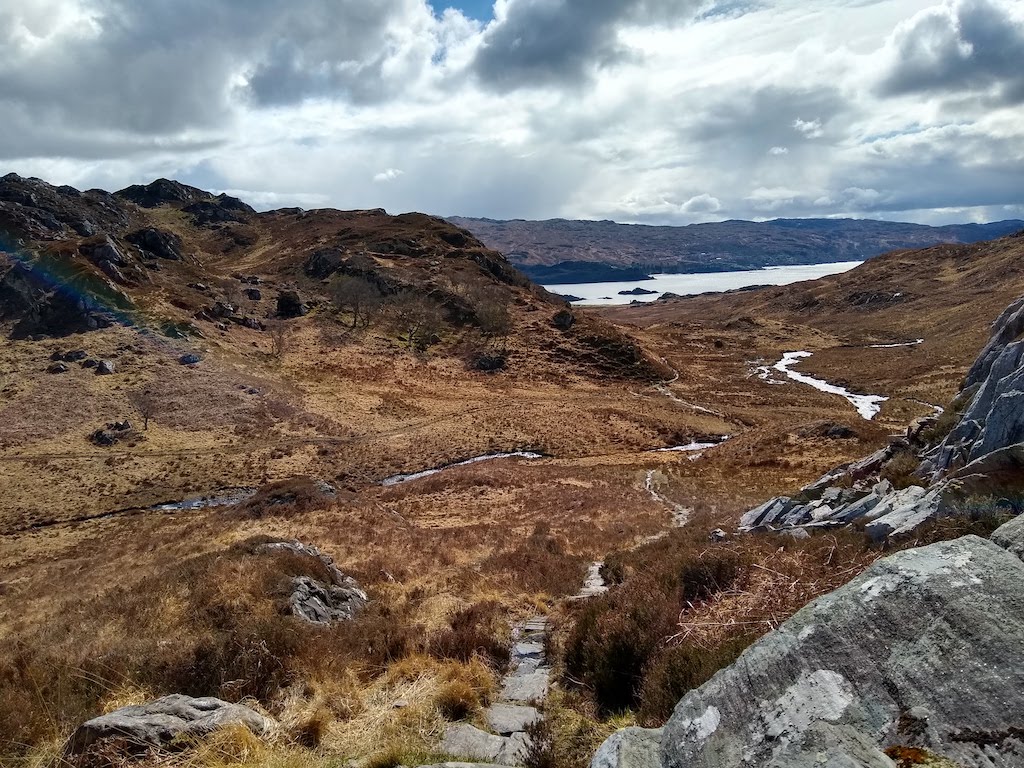
A look back – Loch Ailort is visible and the bothy is on the beach.
All went well on this 8 mile out and back hike until about half way on the return, Gordon’s back started to bend sideways to the right and gave terrible pain. He tried adjustments to the backpack, lengthening his right walking pole, adjusting walking stye, but nothing helped. This slowed the walk a lot and threw a damper on what would otherwise have been an excellent day. The back improved after resting, eating and drinking. It was back to normal the following day. There seems to be no explanation for this. Maybe it was some sort of cramp, maybe dehydration, who knows?
Saturday 15 April. We had a nice breakfast at the tea shop in Arisaig with Jesper and Bob I before moving on south. We had arranged accommodation in Ayr at the Horizon Hotel because we intended to visit Culzean Castle, the ancestral home of the Scottish Kennedys. Betsy being a Scottish Kennedy and never have been there this was an important side trip.
Sunday 16 April. Ayr, Culzean and on to Keswick.
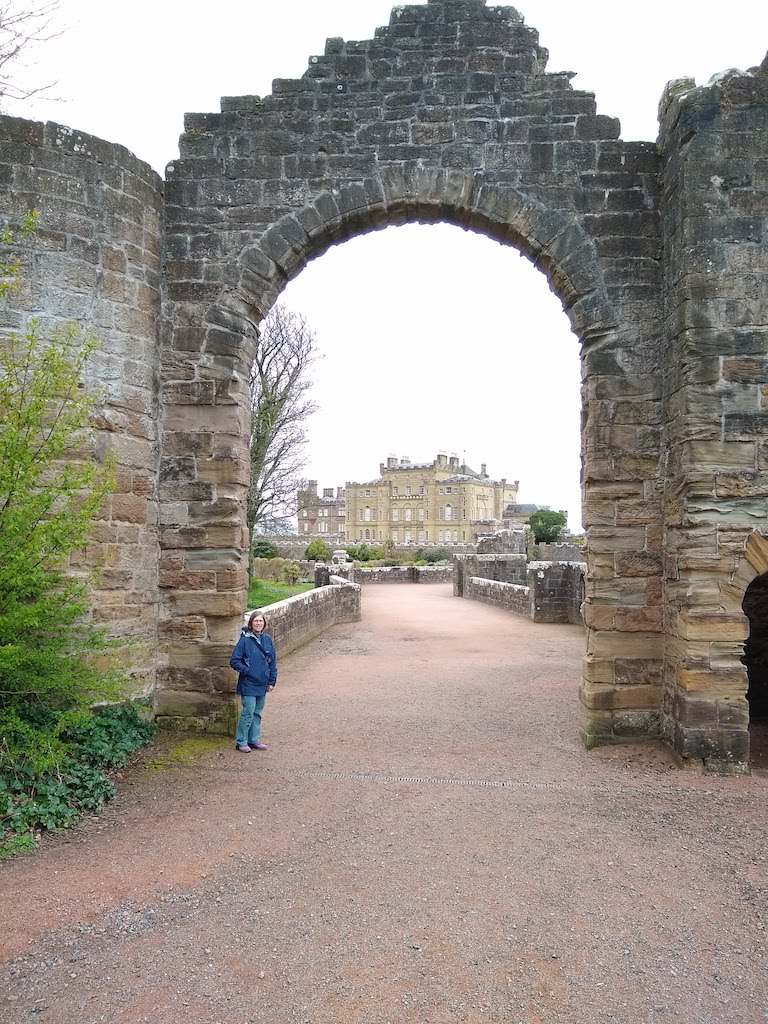
Betsy posed at an entrance to the family estate!
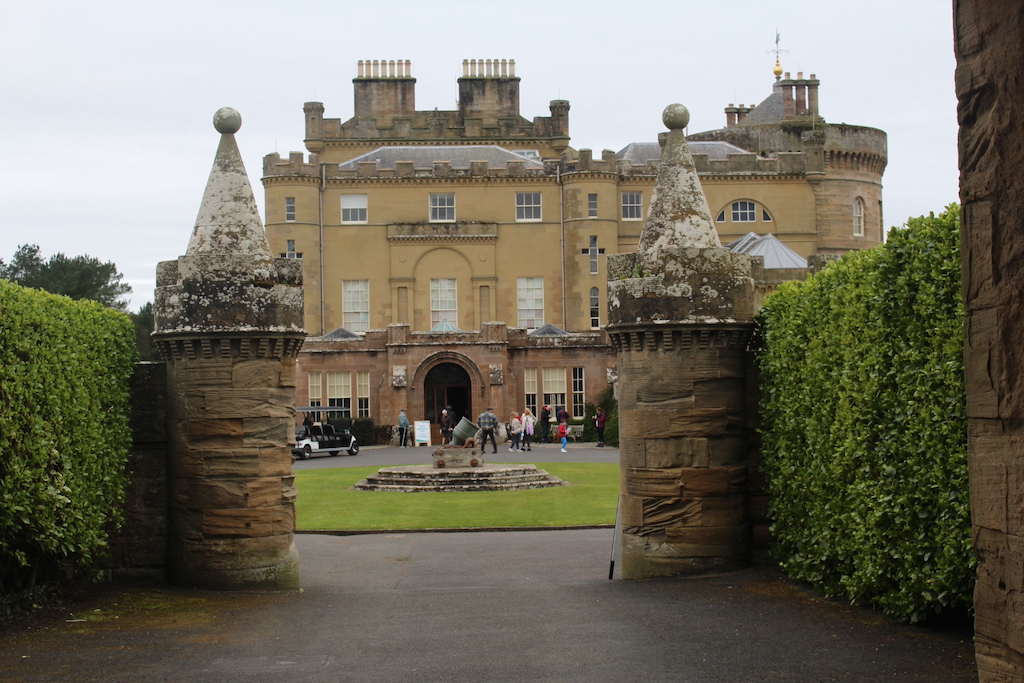
Apparently the clan chief does not live here any more. He has a more modest place in a town nearby.
This was the first property acquired by the National Trust for Scotland after WW II. There is a suite on the top floor that was supplied to General Eisenhower in gratitude for his leadership in the Normandy landings.
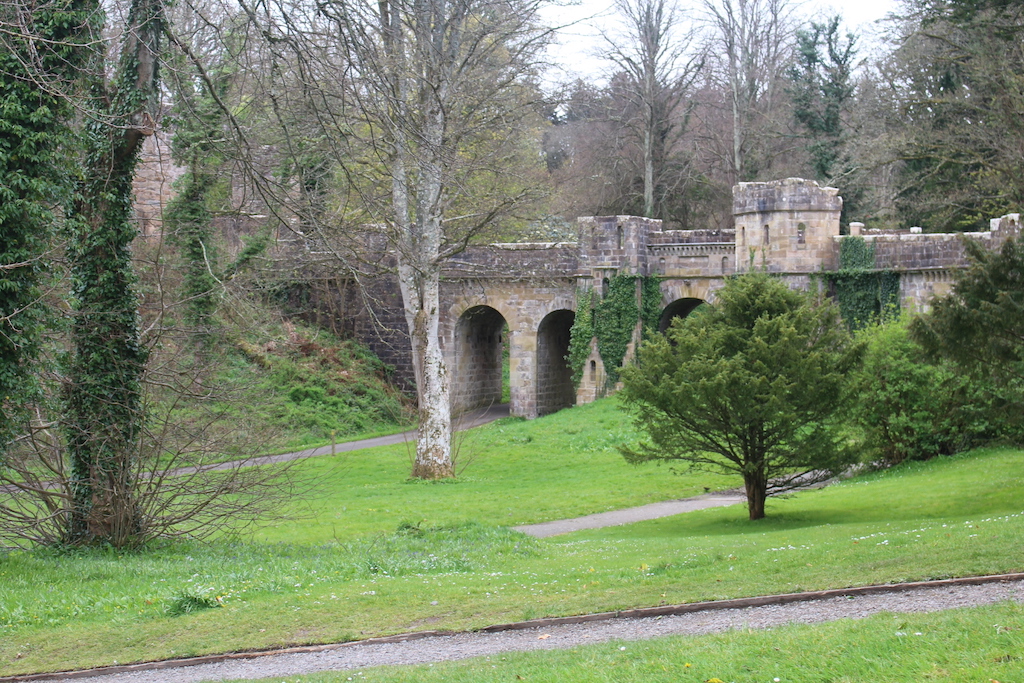
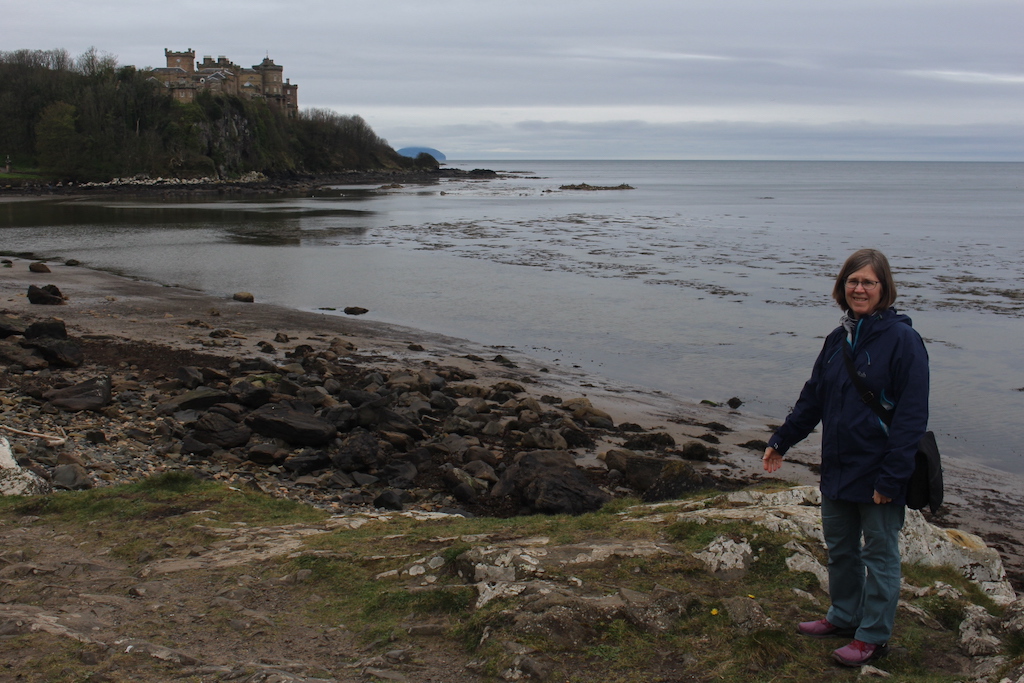
A dramatic location. Ailsa Craig is just visible in the background. The Kennedy Clan Chief’s formal title is Marquess of Ailsa.
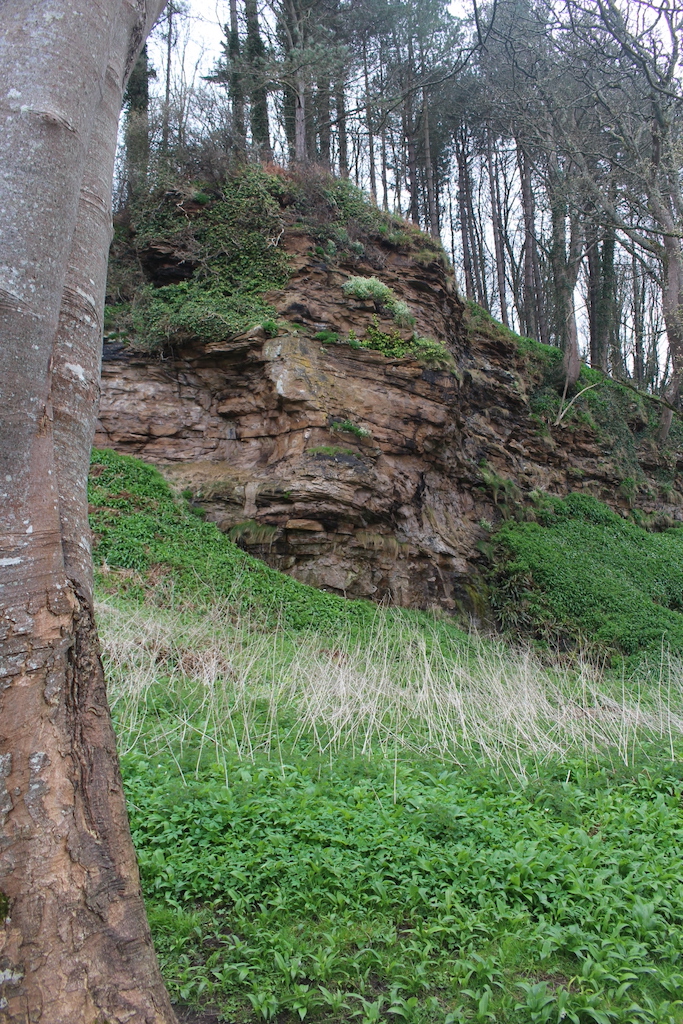
The grounds are vast, we just took the walk along the coast. There was a steep set of steps to the top of this cliff. Also nearby are some cottages that can be rented by the general public.
After visiting Culzean, we set a course South for three nights in Keswick, Cumbria and some reminiscing by Gordon. Many happy times had been spent there as a base for hiking and other adventures. It’s a pity we could not spare more time. Probably we will be back there again soon.
We were made very welcome at Brookfield Guest House on the road to Penrith. Excellent breakfasts including Manx kippers and black pudding. We also had some first class meals in Keswick’s restaurants. Including and Italian place (Casa Bella) and what we think was a Contemporary/North African/Middle Eastern establishment (Merienda).
On the 17 April, we took a walk through the town and checked up on some sights. including a hike up Friars Crag and a look at Fisher’s outdoor shop for old time’s sake. We also we stopped in at Mickledore’s office. These were the people that had organised some of our long distance walks like Coast to Coast and North Cornwall Coast.
Later we walked to the stone circle at Castlerigg. In the 1960s Gordon had camped fairly close to there at Dale Bottom Farm in St. John’s in the Vale with the 4th Chadderton Boy Scout troop.
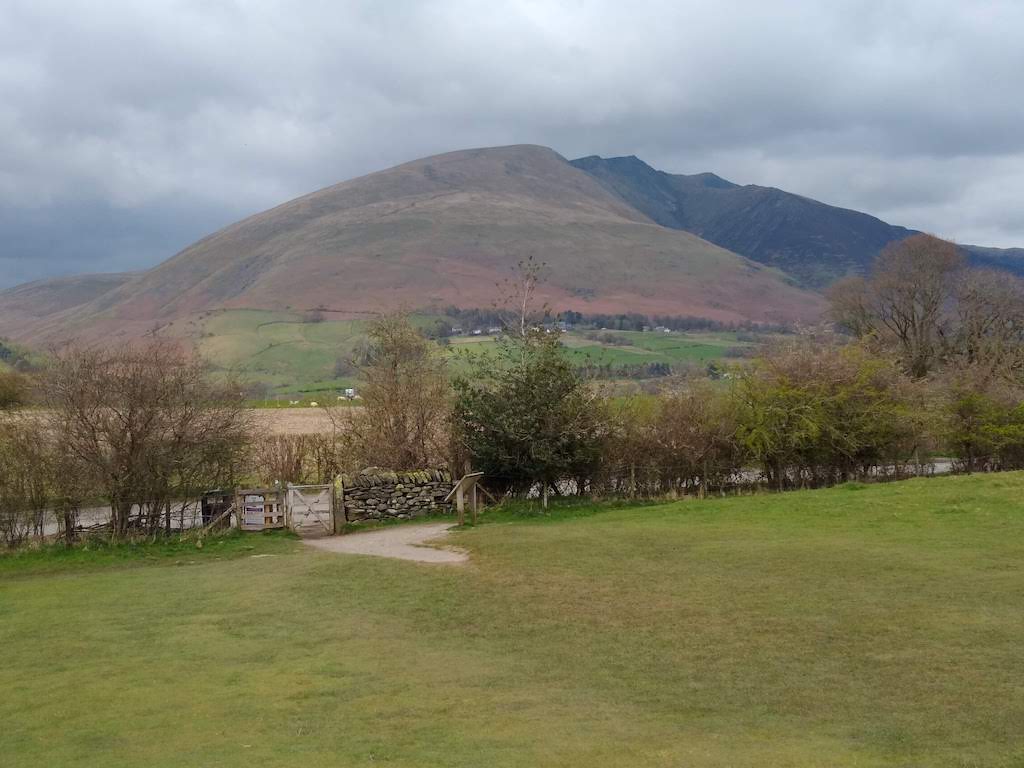
Classic view of Blencathra from Castlerigg. Gordon has climbed it many times in the 1960s and 1970s including dragging his father over Sharp Edge in 1973, sliding down Halls Fell on cardboard in the early 1960s, taking a group of colleagues up it while at ICL in the early 1980s..
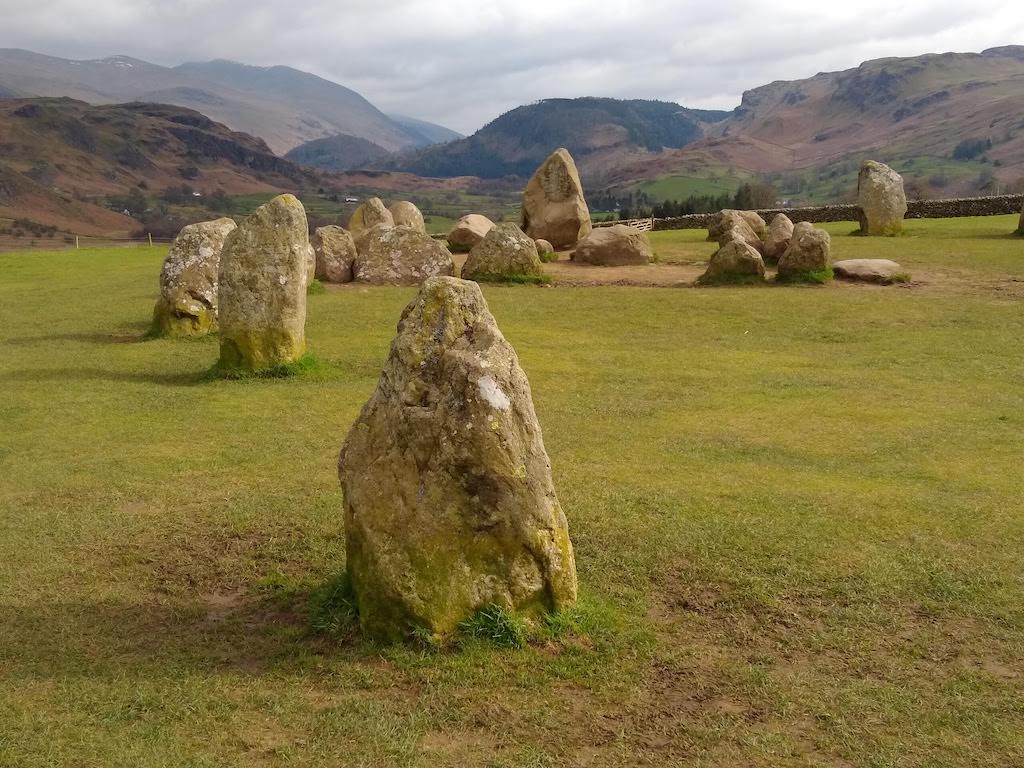
You can see why ancient Britons liked this spot. There are many theories about the positioning of the stones.
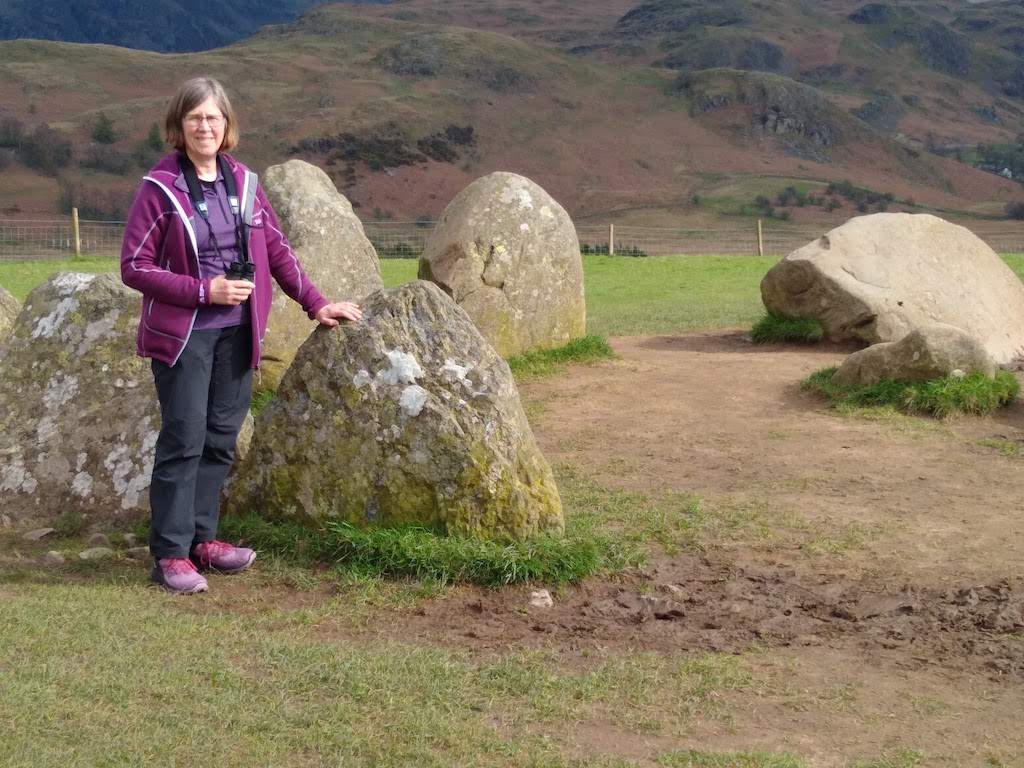
Rick Steves visited here on one of his trips to England for his TV show on PBS. The last time we were here (maybe in 2009) some hippies had decorated the stones and some of them were still there (smoking something).
The next day, 18 April, planned to take the ferry on Derwentwater from Keswick pier to Ashness Gate and then on to Watendlath – a classic Lake District walk. First we had to navigate the painful business of using the pay and display meters at the Lakeside parking area. This a a long story and not worth mentioning here other than to say that we wasted a hour of precious time messing about. The message is clear. These town councils should not use Internet based systems unless they have a good connection. Especially when it comes to the card-operated toilets!
Anyway we were able to get the ferry, but the delay set a time constraint on our trip.
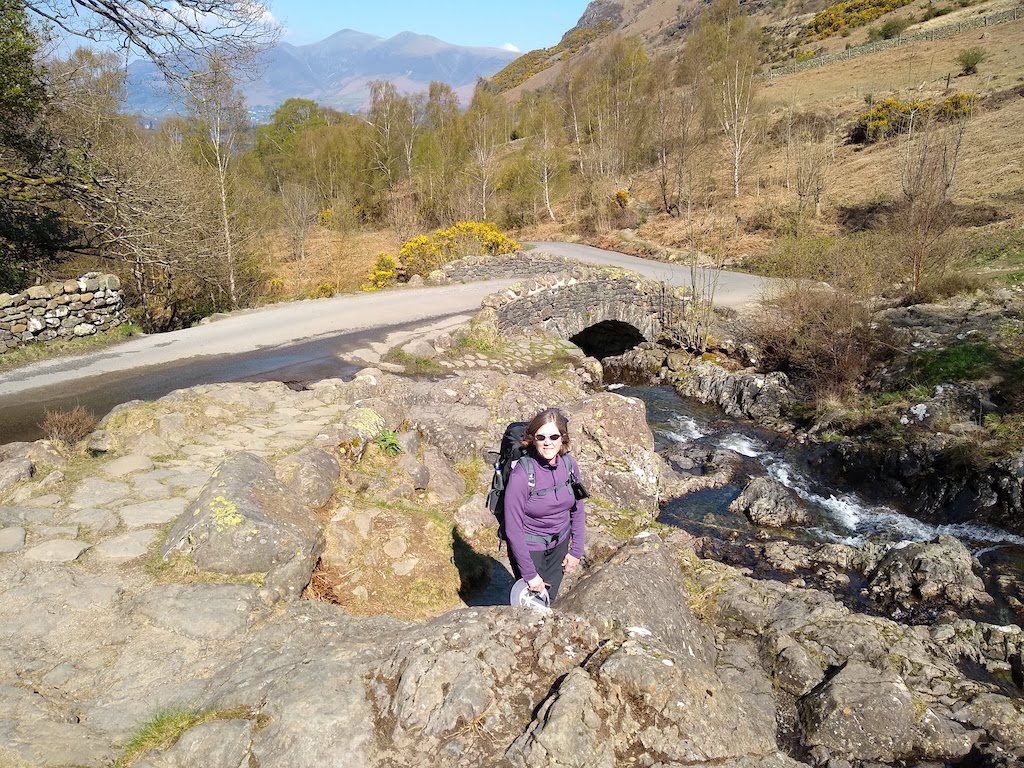
Betsy posed at the much-photographed Ashness Bridge. Seen on may chocolate box covers and calendars. Skiddaw is the the background – climbed by Gordon in about 1964 as a Boy Scout Patrol leader.
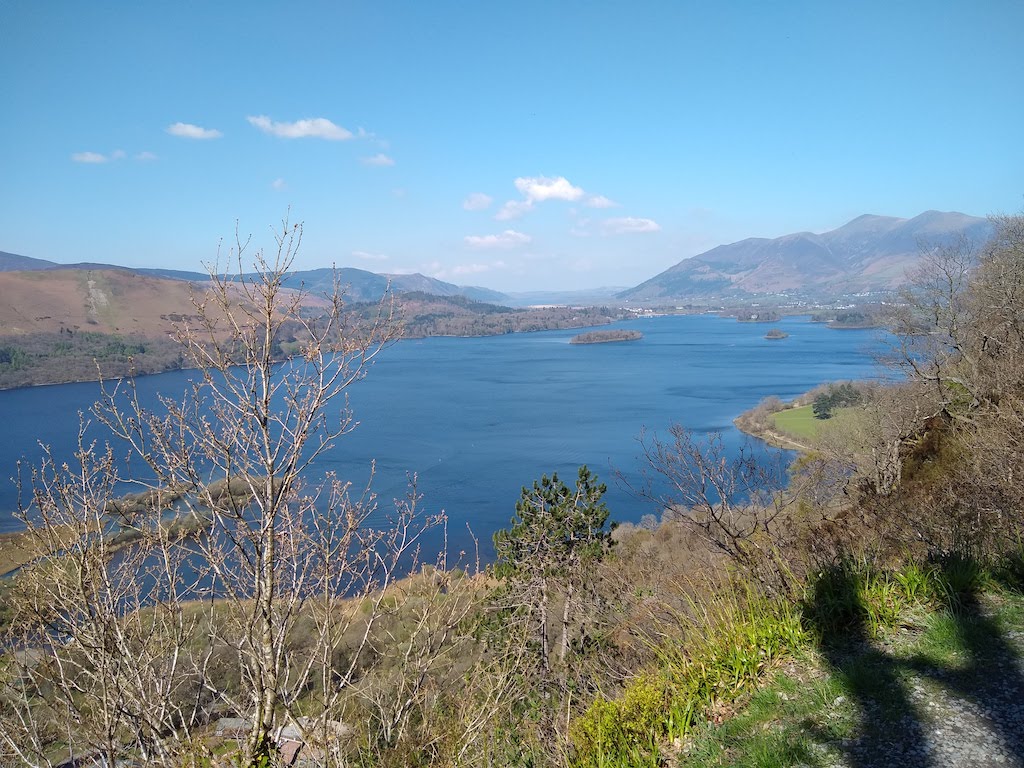
The “Surprise View” comes up quickly when following the road. Gordon has a picture of his mother at this spot in the 1960s (maybe 1965). Skiddaw dominates as usual.
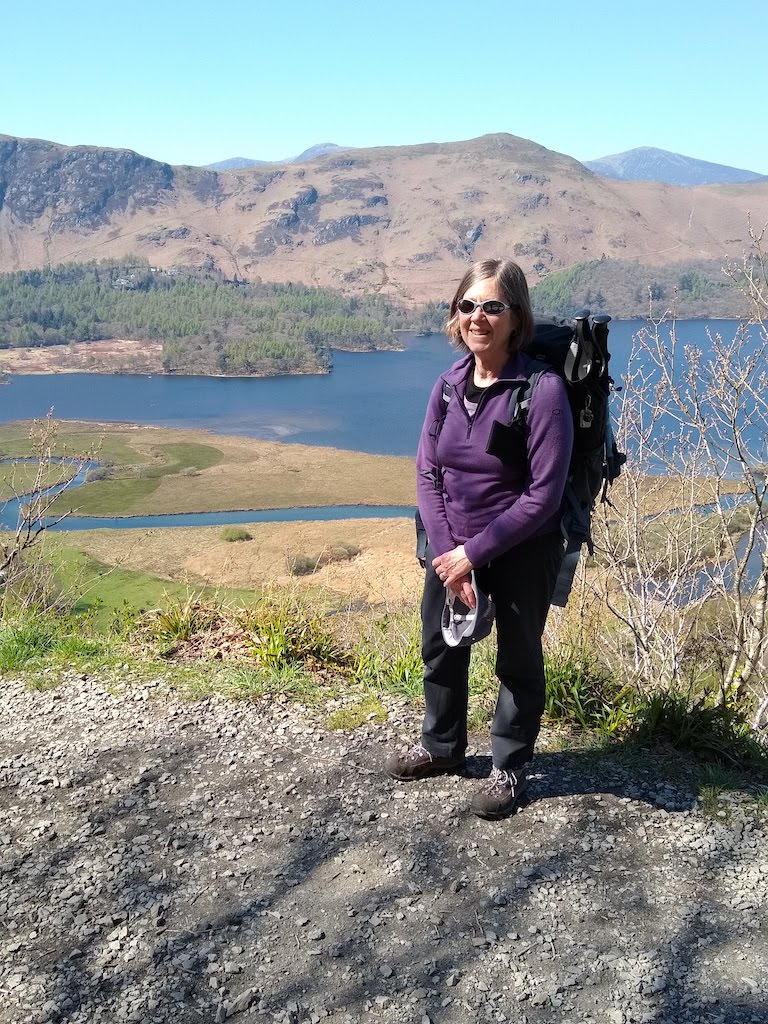
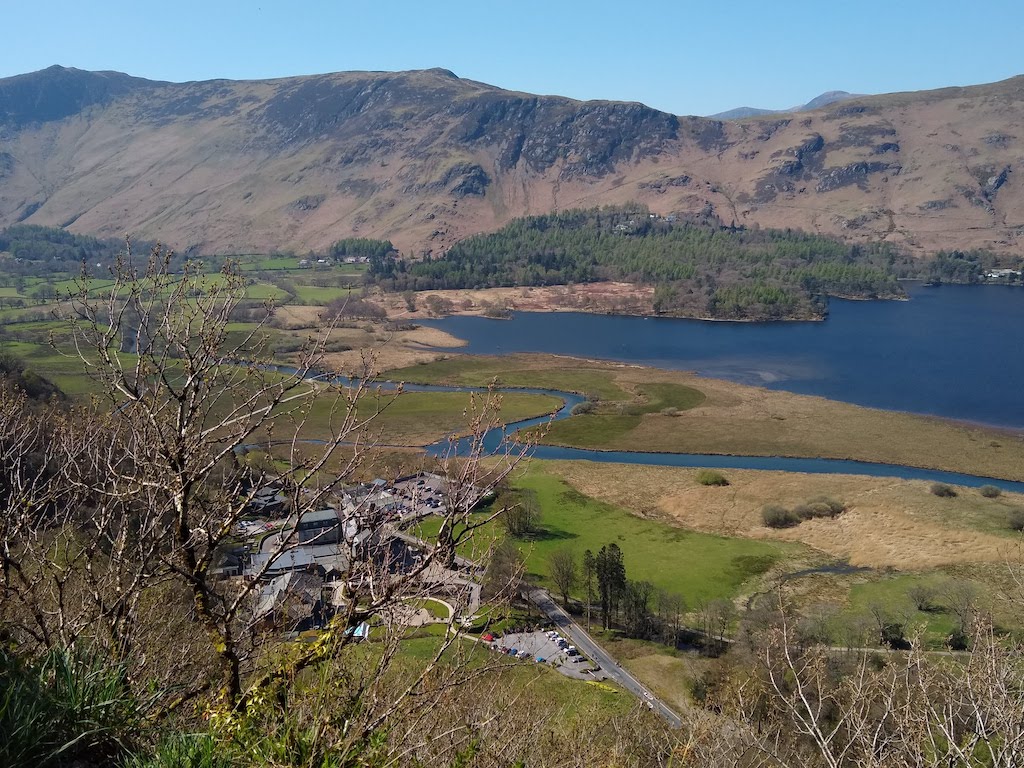
Looking down at Lodore with the Borrowdale Hotel visible. Lodore Hotel is directly below the viewpoint.
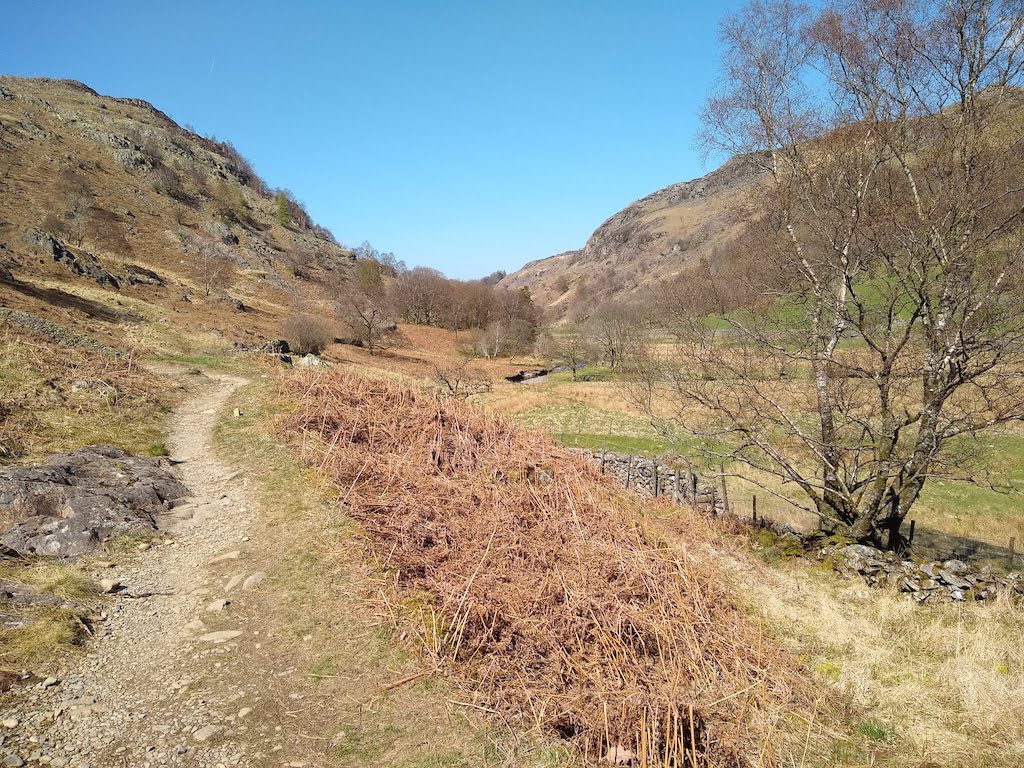
Thanks to the wasted time at the start of the day, we had to turn around before reaching Watendlath, but we were able to enjoy the valley.
On the way up we had noticed a path leading to Lodore, so we chose this as our way down. We could get the ferry back to Keswick at the Lodore Pier. The path was excellent at first and followed a brook, but the brook was in spate because of the recent rain and snow melt, so when a crossing was needed we were in trouble because anything that resembles stepping stones was underwater. We had to remove our boots and walk across the stream – not easy because it was hard to pick out good places for steps. Gordon hurt his ankle by scraping it on a sharp rock. he bandaged it with a handkerchief which worked for the day.
After the brook crossing the path became very steep with some indistinct sections and side trails, probably because walkers had taken detours to look into the gorge. The path led down to the Lodore Hotel and views back to the famed Lodore Falls. In our hurry to get to the ferry and hopefully avoid a parking fine, we were not able to spend much time admiring views.
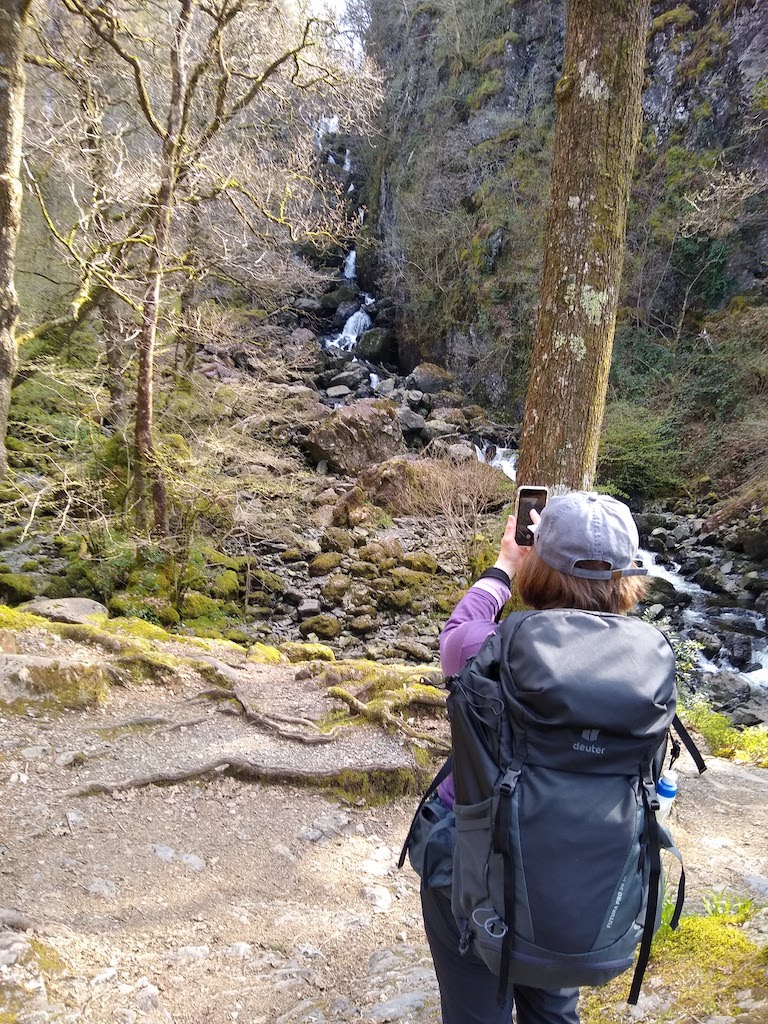
We did take some pictures though and we did miss the next ferry which would have got us to the parking area before the time ran out. We waited 25 mins for the next boat and luckily the meter attendant had not been around to see that our time had expired.
That night we had a pub meal at a place on Lake Road – not bad.
19 April we set out for Lancaster and two nights staying with Heather and David. On the way we visited Langdale, another place full of memories for Gordon from his days in the Boy Scouts. He led a group over Harrison Stickle and Pike of Stickle sometime in the 1960s including an ascent of Jack’s Rake. We had lunch at the New Dungeon Ghyll Hotel.
Some roadworks in Lancaster confused us when following Heather’s directions, but the satnav saved the day and we arrived safely. Heather and David live in a splendid place. we had a nice walk around followed by appetizers and beer in the sun house.
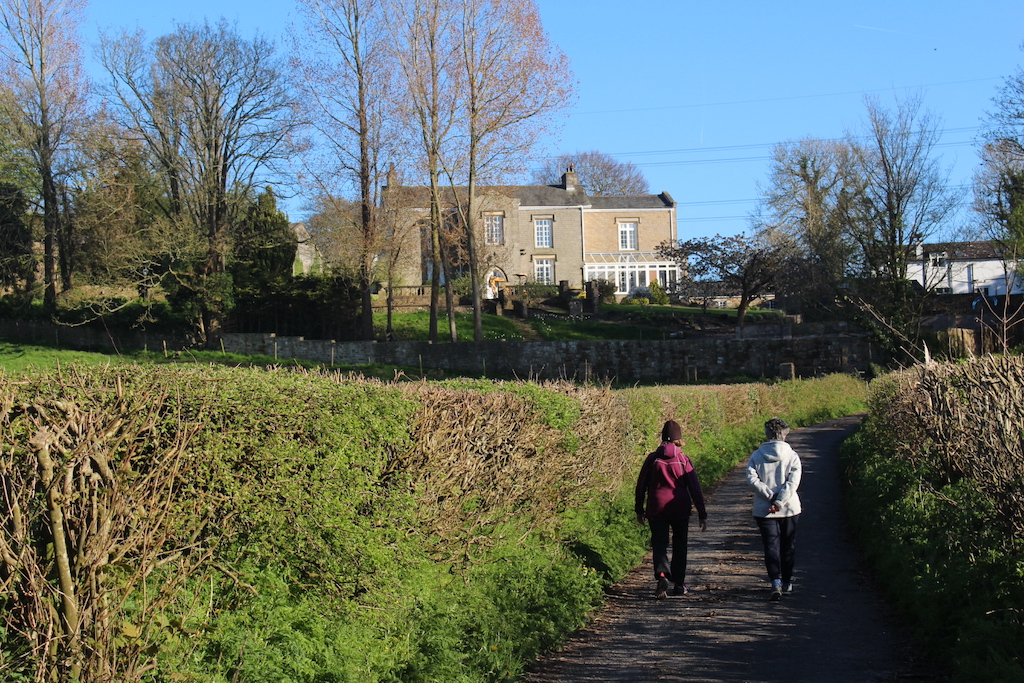
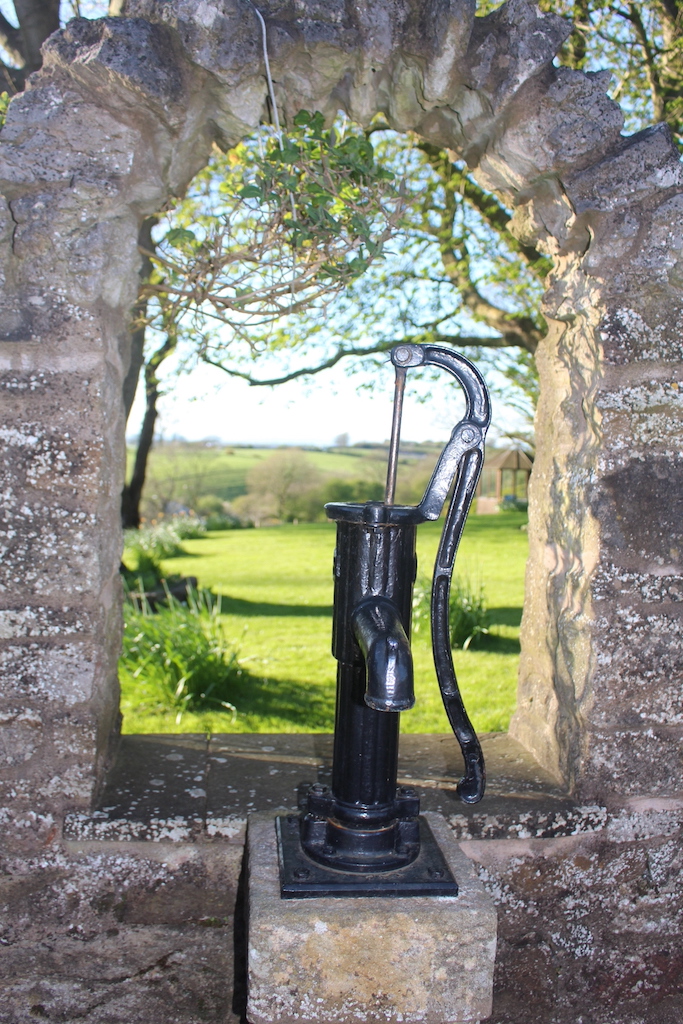
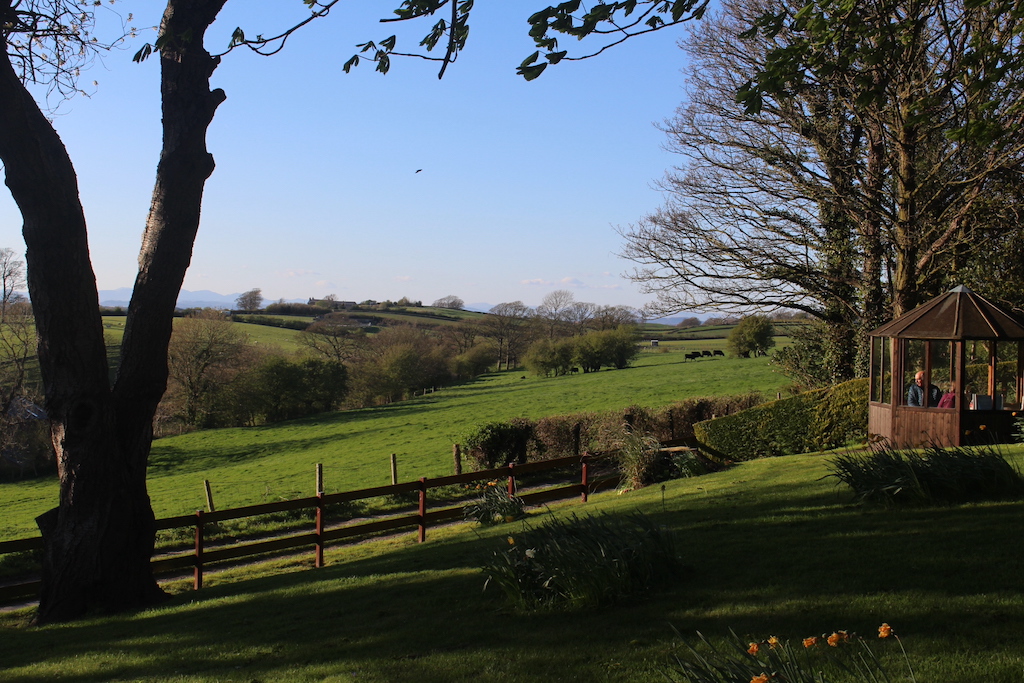
The 20th of April was originally planned to be a visit to Wasdale for another one of Gordon’s reminiscences, but this is a long drive from Lancaster so David offered to take us on a tour that went to some more of Gordon’s favourite places remembered from his youth – Central Lancashire by going via the Trough of Bowland.
The day started with a visit to Lancaster and a walk around the Castle, which until very recently had still been used as a prison. It’s famous for many reasons including the Pendle witch trials and executions.
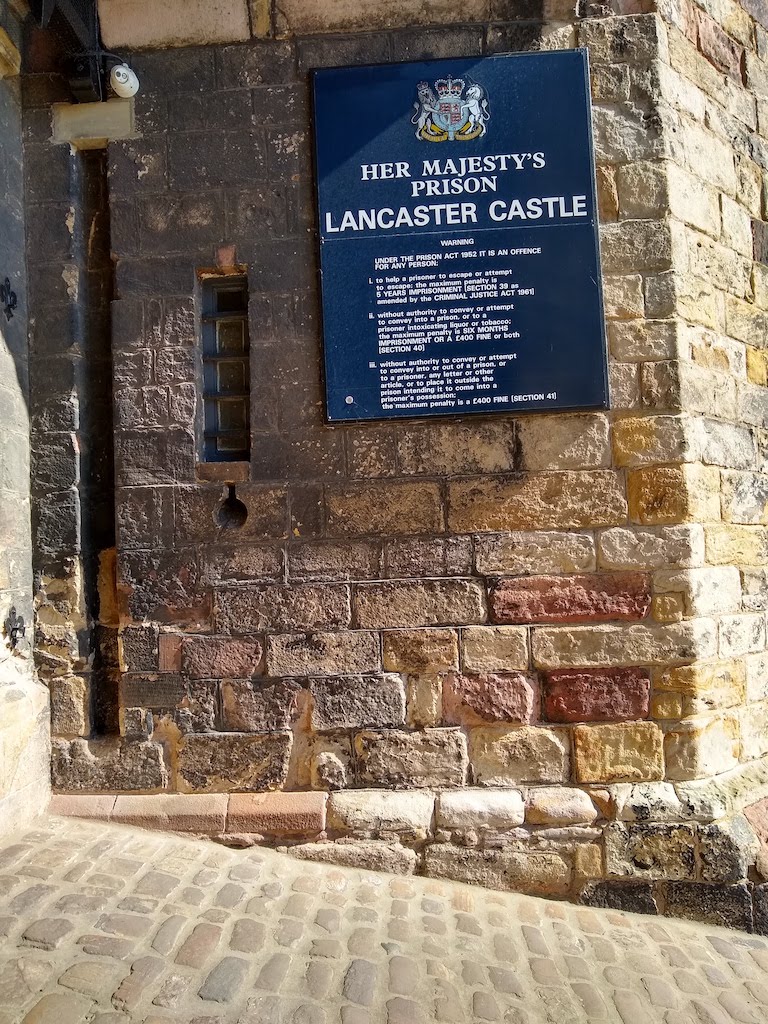
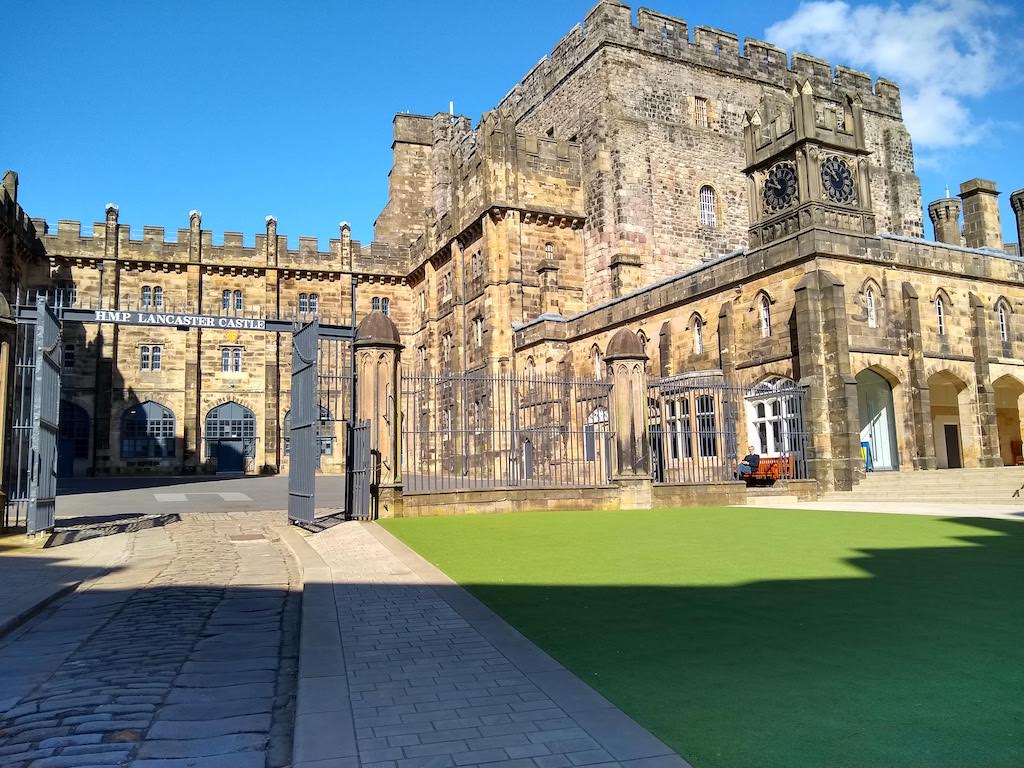
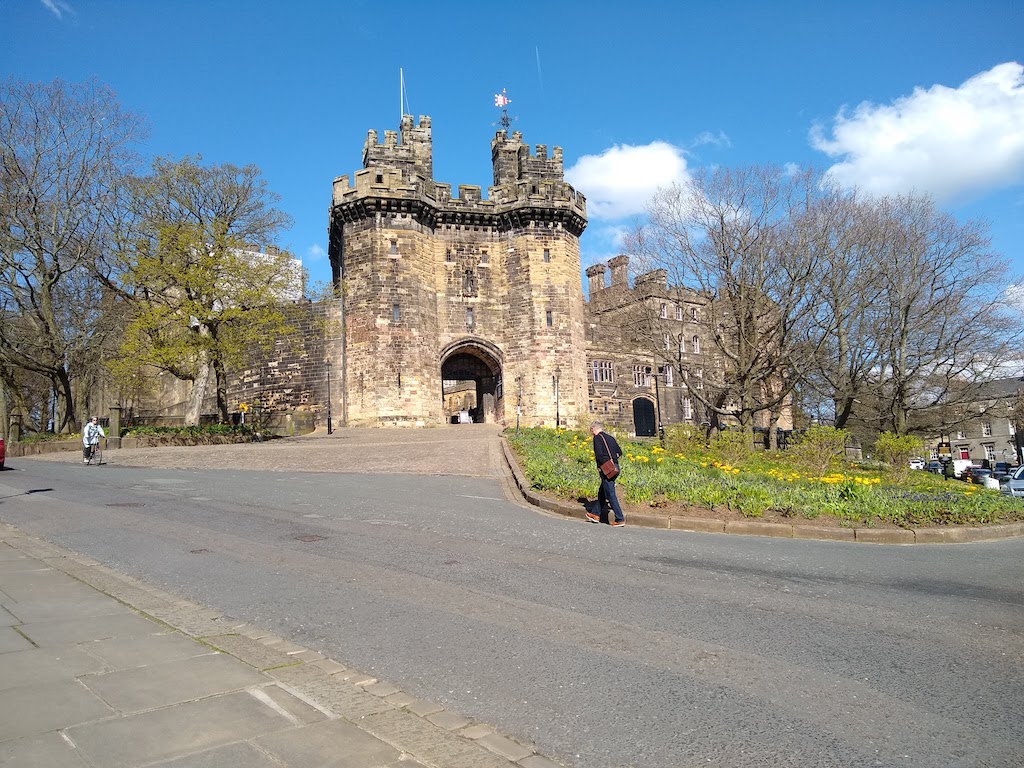
After Lancaster we drove via the Trough of Bowland to Clitheroe, but we did stop for a snack at Dunsop Bridge. All of these names bring back memories and emotions to Gordon. We used to have bicycle rides from Gordon’s parents’ home to this area in the 1960s. On one occasion Gordon’s father rode this way to Carnforth and stayed at a friends caravan overnight before riding back the following day.
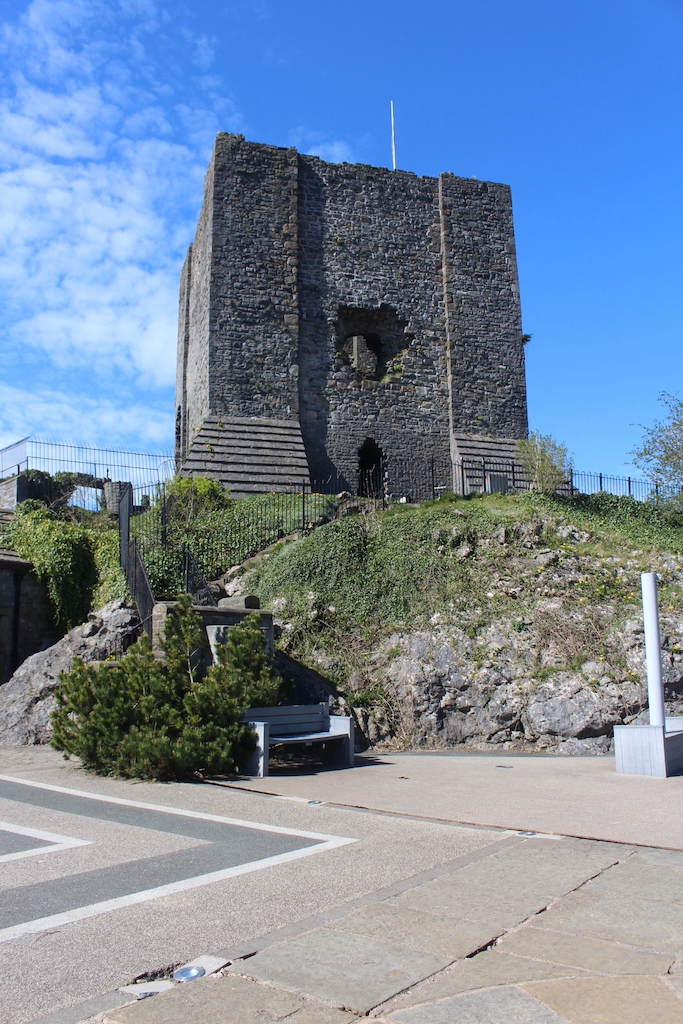
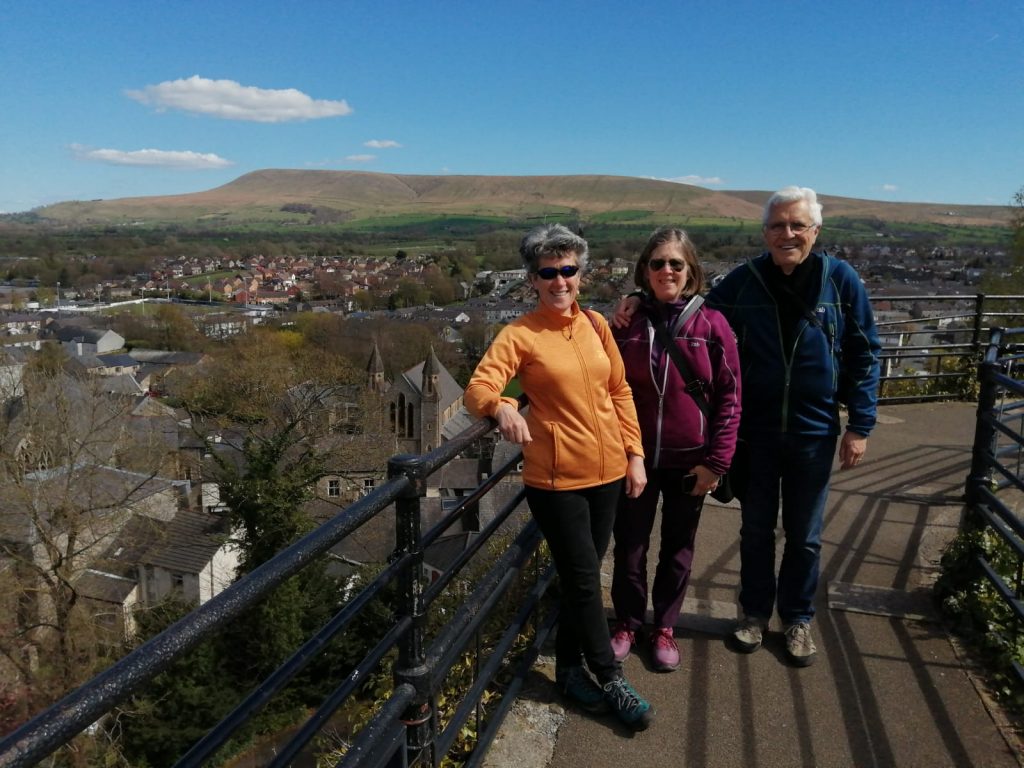
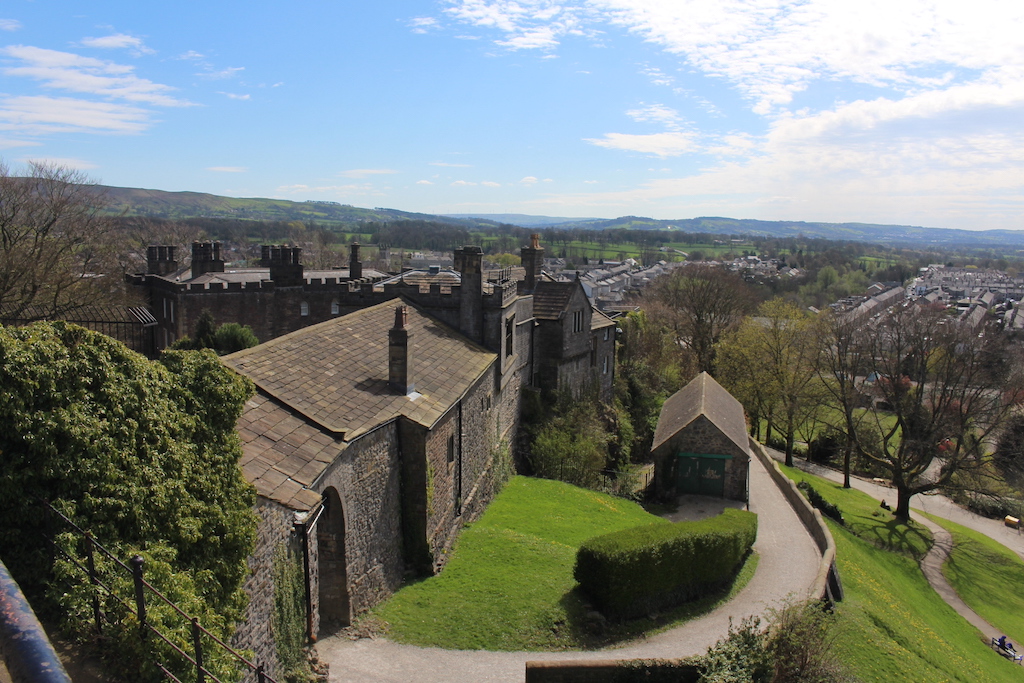
Clitheroe is dominated by is castle and the fine views of Pendle and Longridge, some of the buildings are still used for municipal purposes. Pendle Hill is noted because of its connections to the witch hunts of the sixteenth century and also because it’s where George Fox had is revelations that led him to found the Quakers.
After Clitheroe, we moved on to yet another place full of memories for Gordon of Boy Scouts camping – Higher Hodder Bridge. In about 1963, the 4th Chadderton Boy Scouts’ Summer Camp was held in a field near this place. It still looks the same, but the trees are higher and there is still fly fishing in the river.
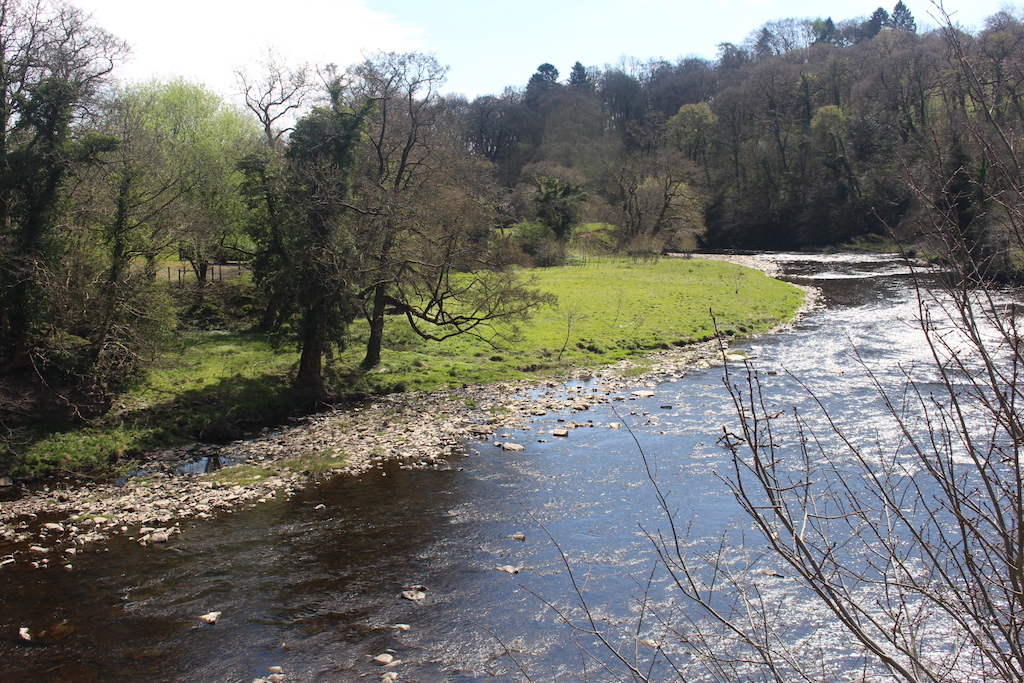
The camp was held in the green area in the centre of the picture, which was taken from Hodder Bridge.
The next stop was the picturesque village of Downham. Occasionally it has been voted the prettiest in England and has been used in numerous films. The public toilets (of all things) are a point of interest because they are built into the stalls of an old cow barn and were the winner of the inaugural “Loo of the Year” award in 1991. The last time we visited Downham was on a tour of England and Wales with Betsy’s parents in the Summer of 2000.
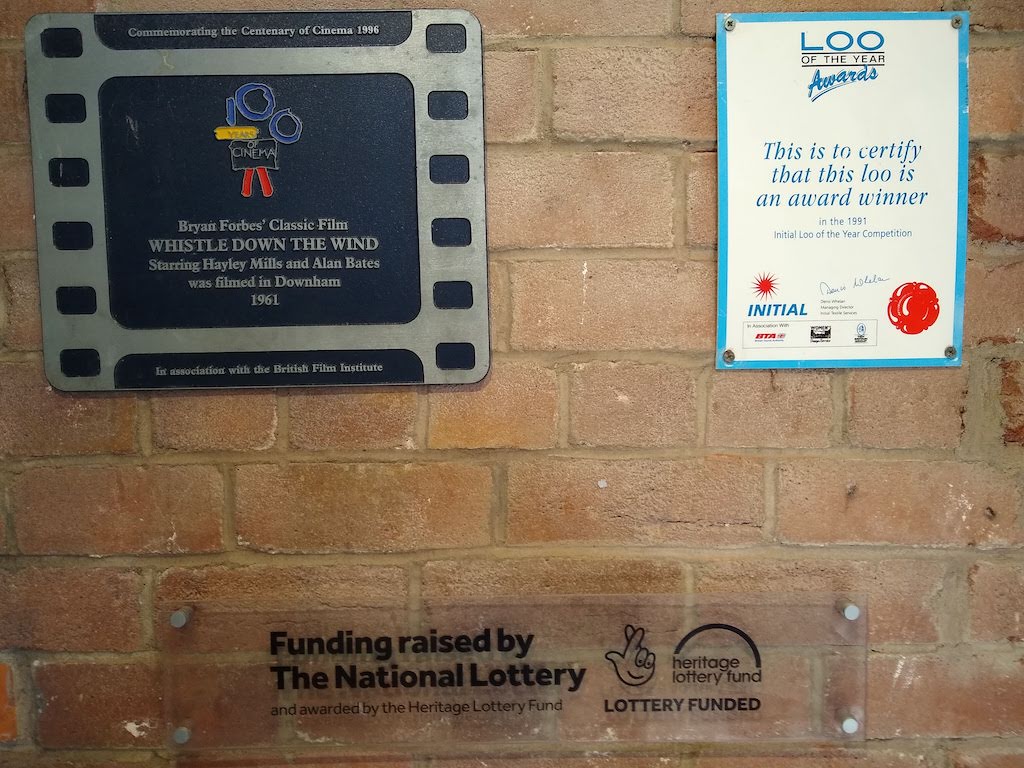
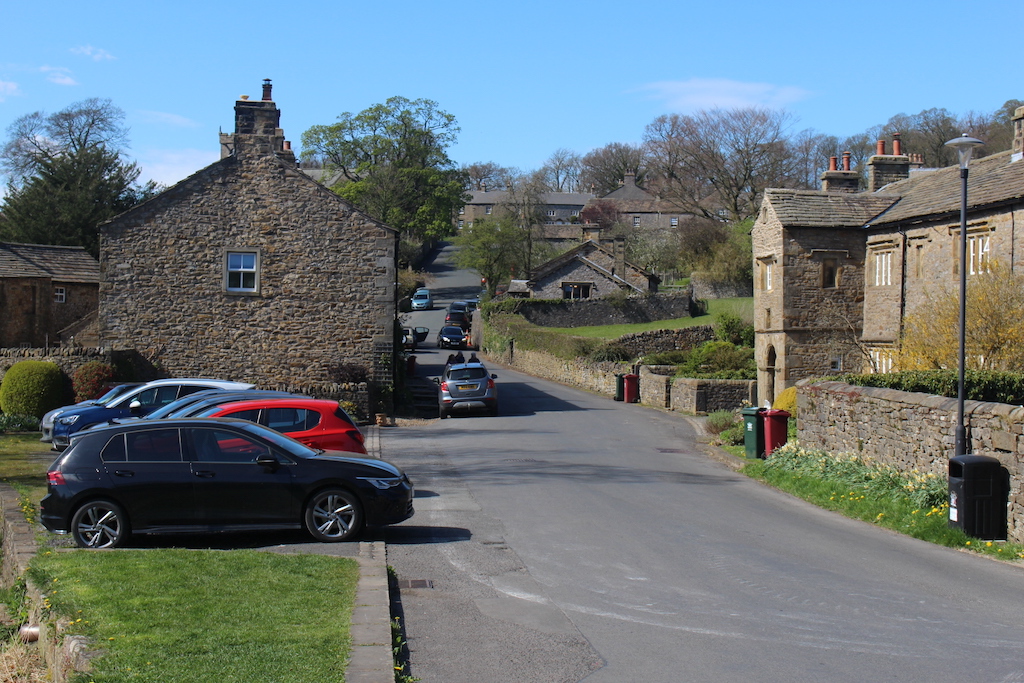
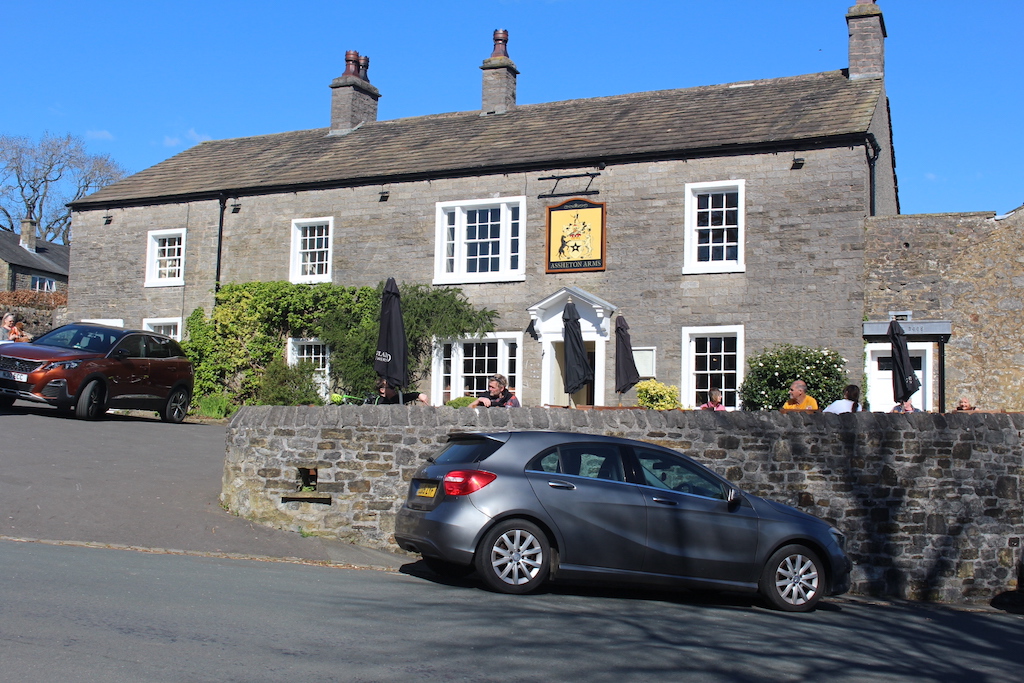
The pub in Downham is supposed to be where George Fox related the story of his revelation to others and the Quaker movement was founded. Some people say that he and he landlord were rather lubricated at the time.
The next stop was another place of significance to Gordon – Ribchester. As the name suggests it was the site of a Roman Fort. There are some relics of the buildings, especially the bath house. Ribchester was the objective of a hike that Gordon did from the camp at Hodder Bridge. It was for the Second Class Scout test. There were two scouts on the hike.
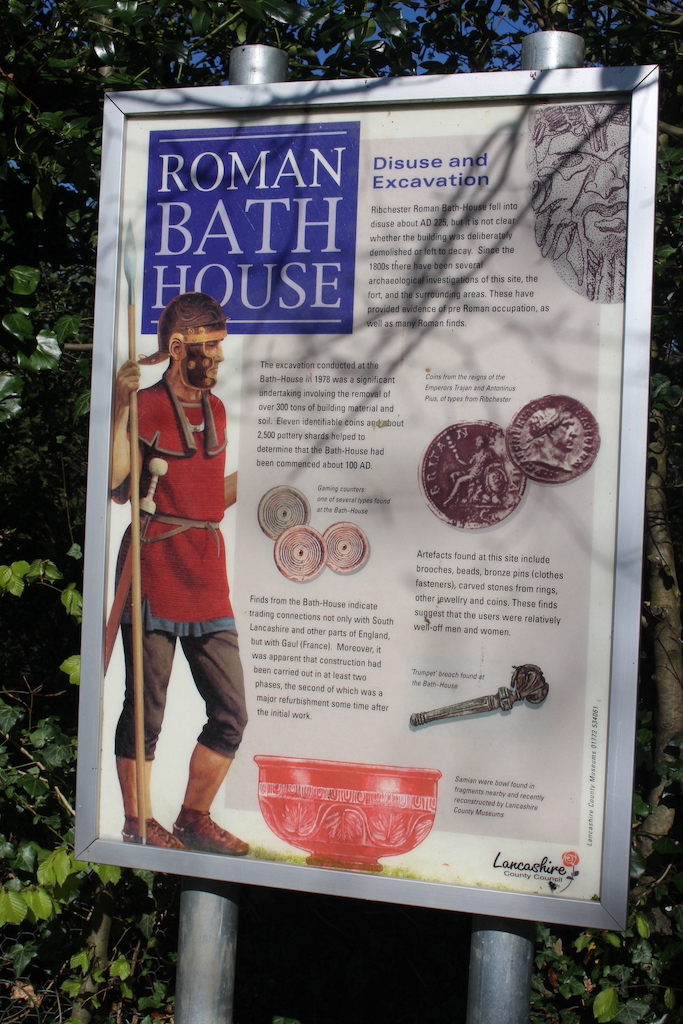
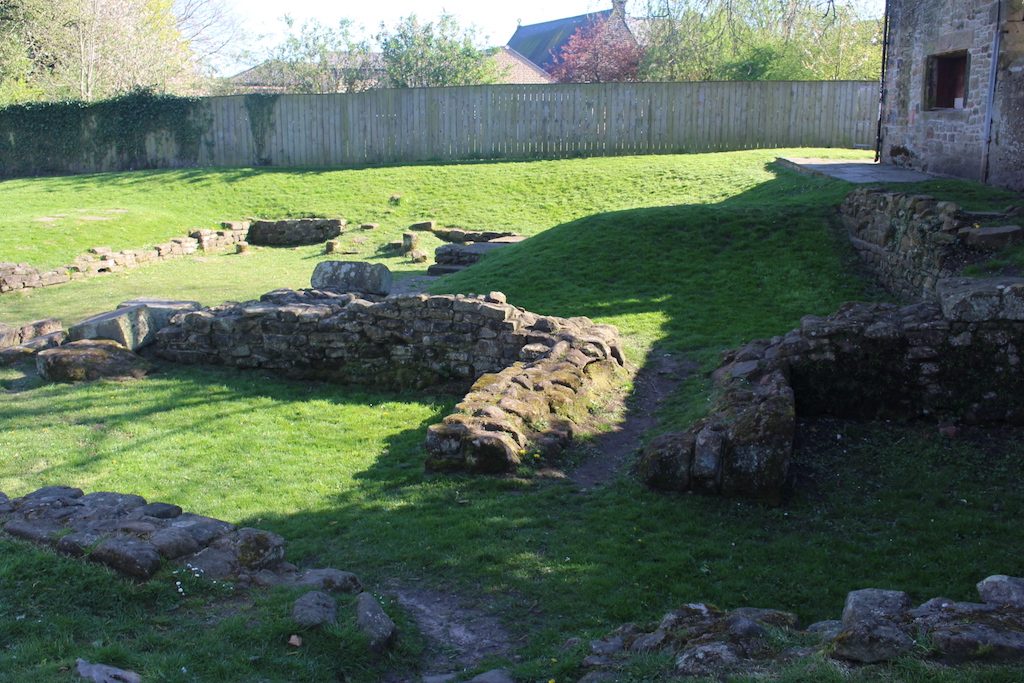
Ribchester gets its name from the River Ribble where Watling Street crossed.
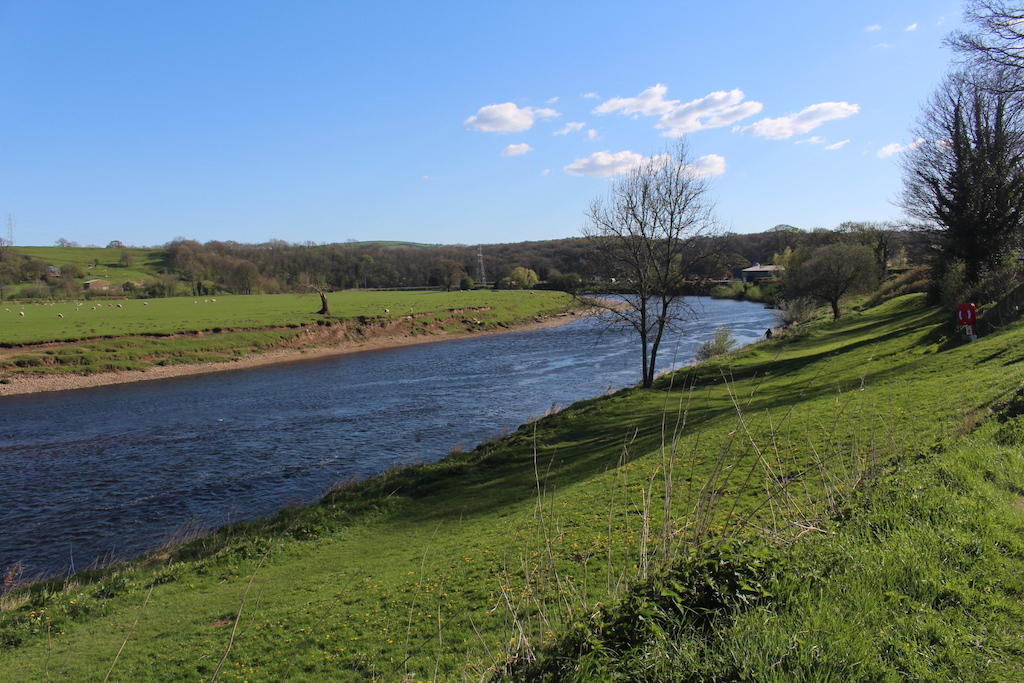
An objective after the hike was to make a report on points of interest. One was the Old White Bull pub in Ribchester with it’s distinctive wooden sign and entrance. The pub was built in 1707 in the old part of the town. It hasn’t changed since the 1960s except for new paint.
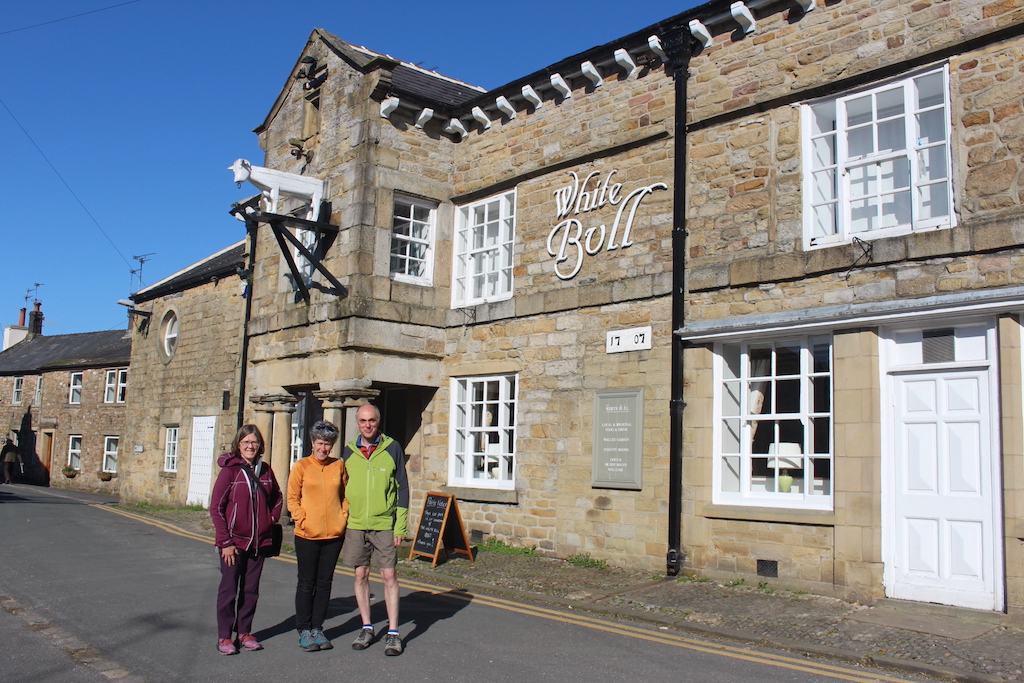
Another point of interest on that hike was the Almshouses at Stydd, which is just outside Ribchester. Built in 1728 they have a very distinct architecture. On the hike, we approached from the track to the right of this photo.
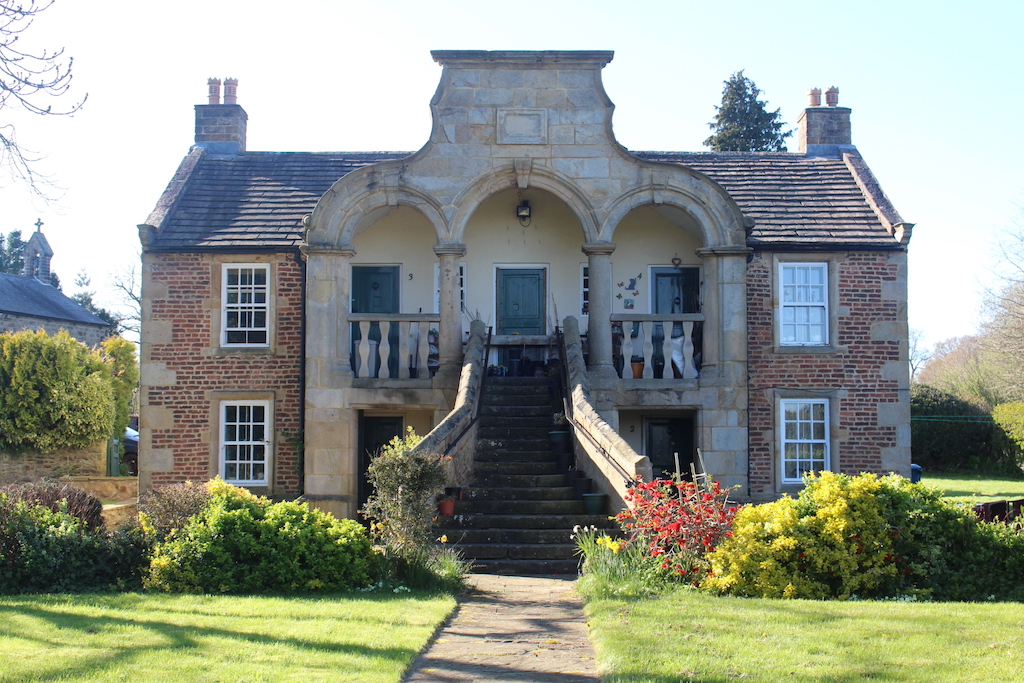
The next day was 21 April – Betsy’s birthday. David and Heather proposed that to celebrate, we have coffee at the Midland Hotel in Morecambe. This is a listed art deco structure that has featured on period TV programmes such as Poirot. It was derelict for some time, but some aspects were tidied up for TV and eventually it was renovated and reopened in the early 2000s. Beforehand we walked along the promenade at Morecambe to take a look at what was left of this formerly wealthy seaside town.
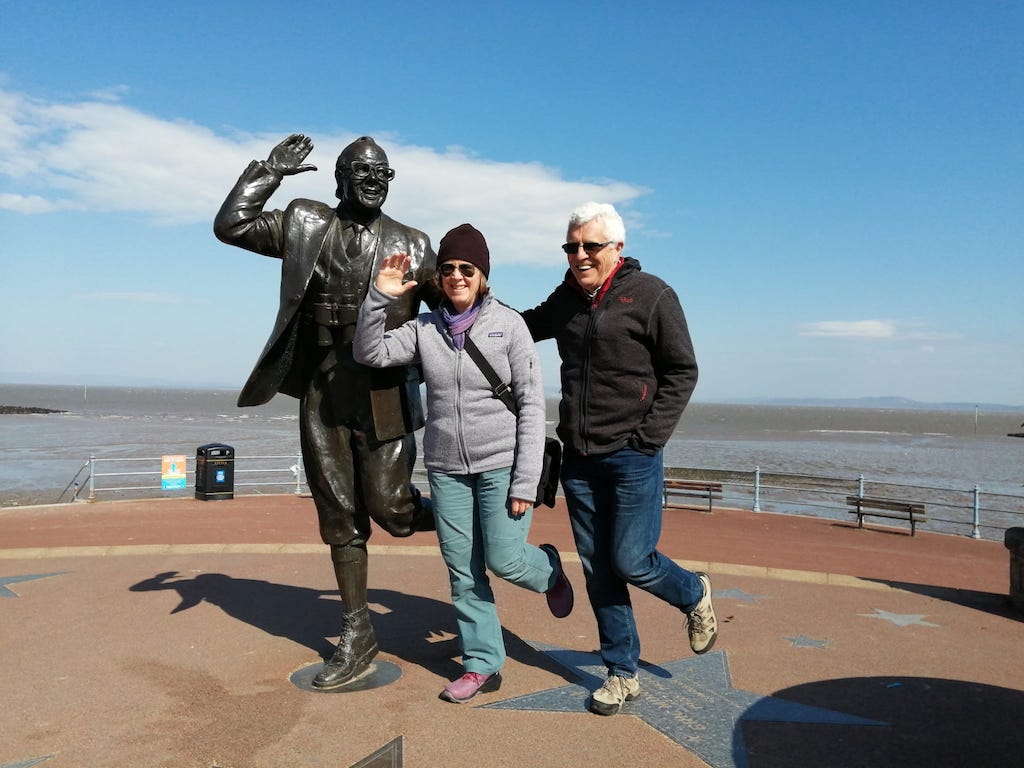
Like all visitors to Morecambe we could not resist being silly at the Eric Morecambe statue. Of course our American friends would have no connection with the Morecambe and Wise shows on the BBC in the 1970s and early 1980s.
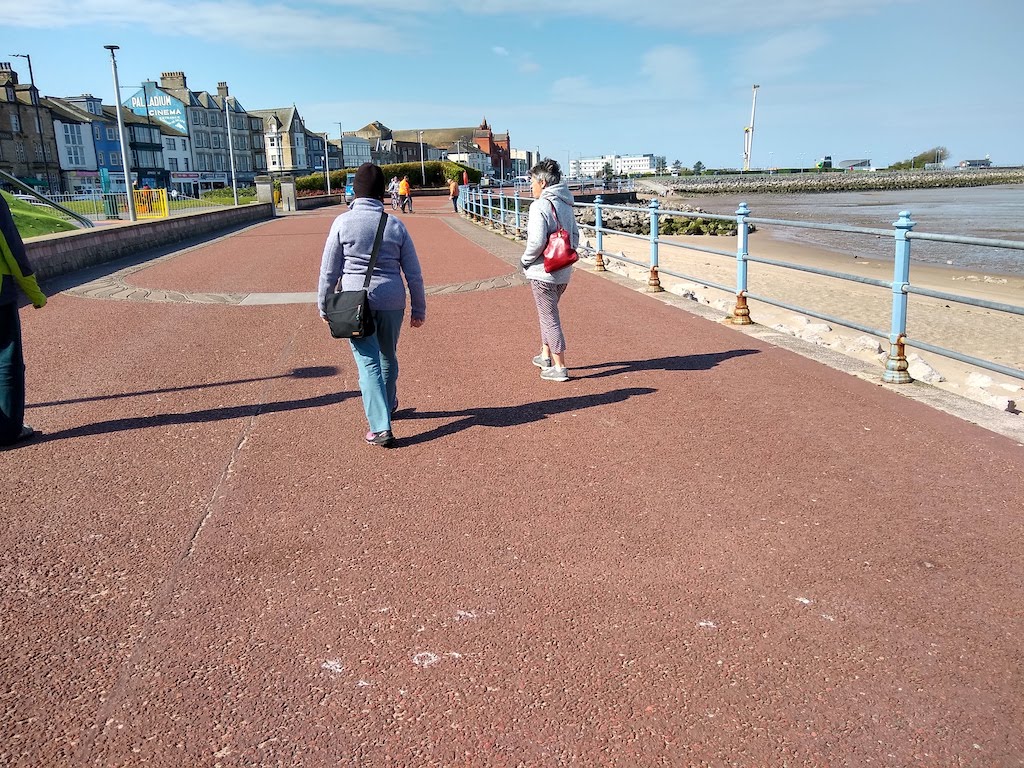
A walk along the prom. The Midland hotel is the white building in the distance.
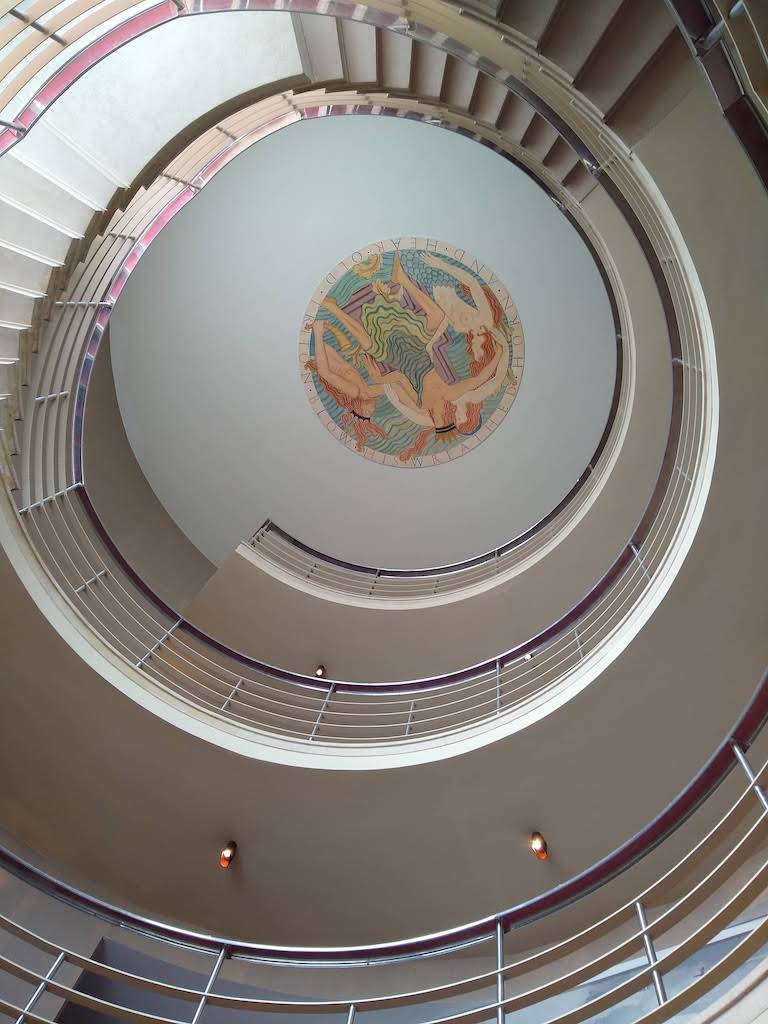
The spectacular art deco staircase.
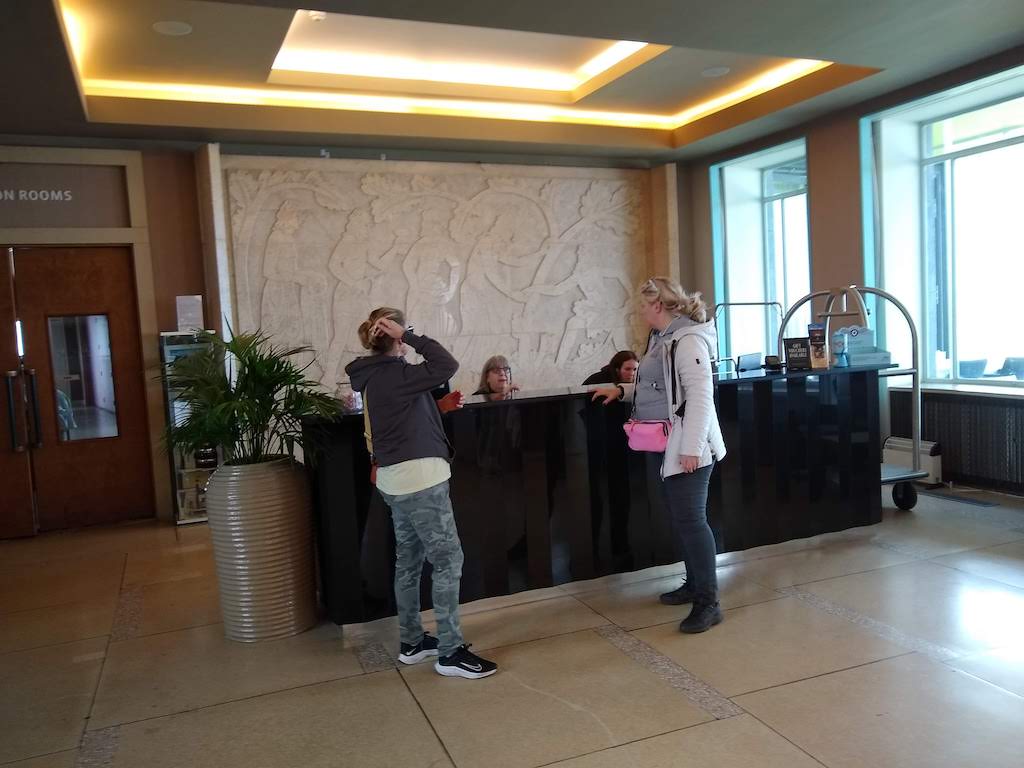
The reception desk had been refurbished originally for the Poirot TV series.
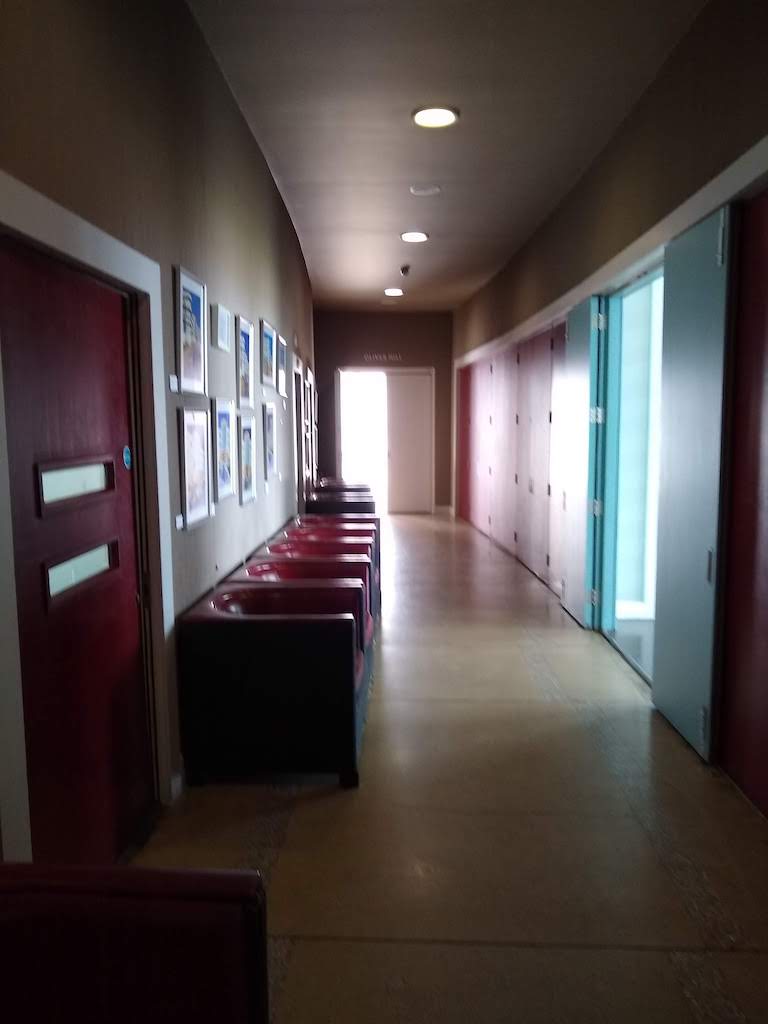
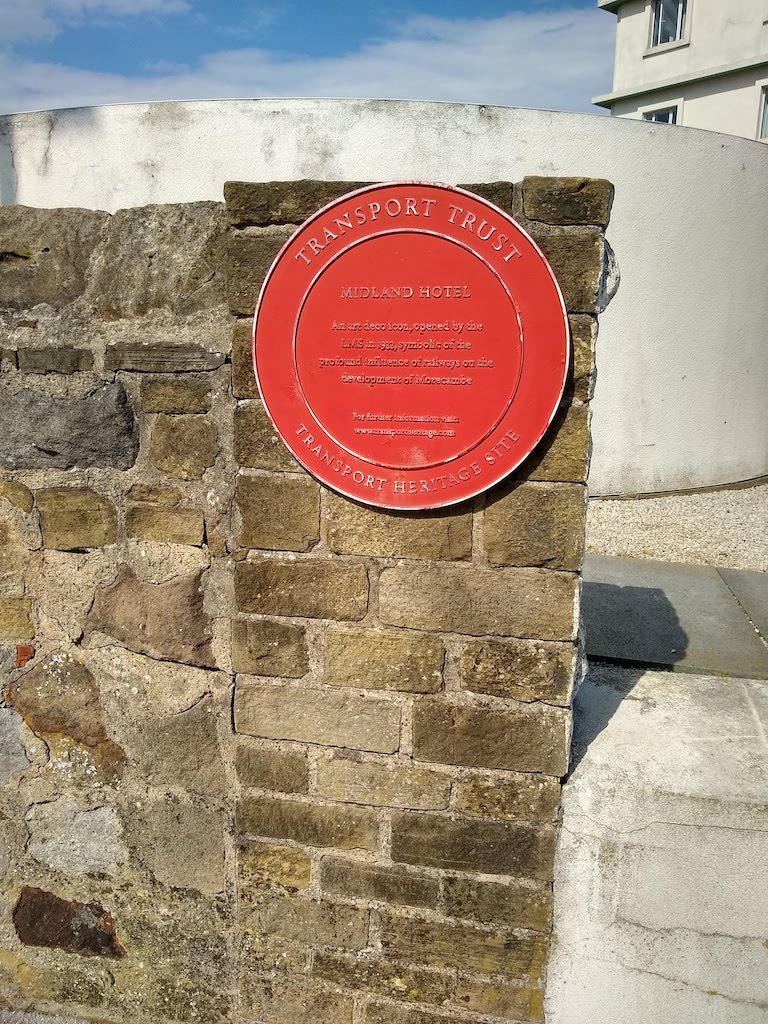
The hotel had been built by the Railway Company. It’s now a grade II listed building. When the Eden Project comes to Morecambe in a few years it will probably have a lot of business.
In the afternoon we set out for York for three nights with Gordon’s old college friend, Gail Vickers – widow of his good compatriot at Royal Holloway, Steve Vickers. The traffic on the M62 around Manchester was terrible as usual, but we arrived at a reasonable time. Gail had a birthday cake for Betsy and we had a Zoom call with Betsy’s mother and sister.
Betsy had always wanted to visit Castle Howard so on Saturday 22 April we visited this huge stately home made famous in the 1980s by the TV adaptation of Brideshead Revisited.
The photos don’t need much explanation, but it was raining so we took the little tractor train from the car park to the house. This is a vast estate.
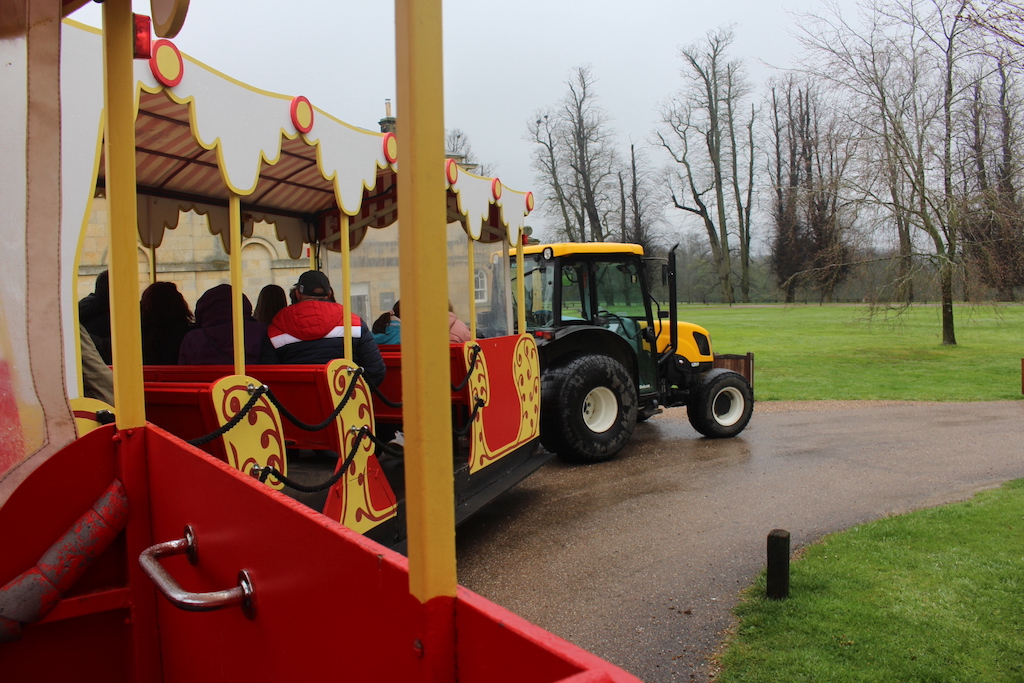
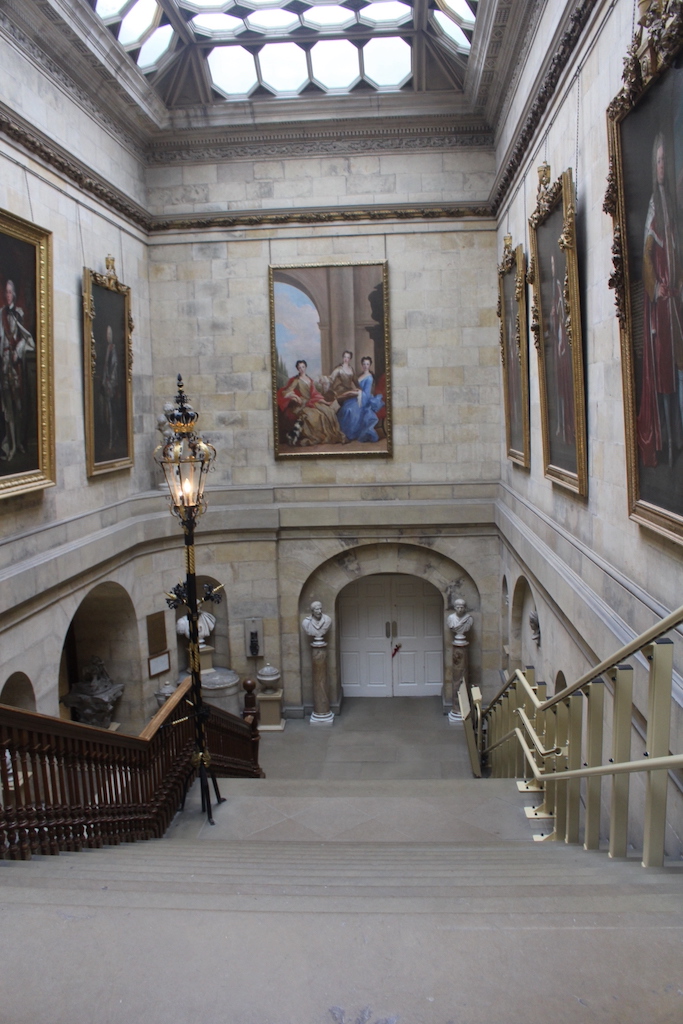
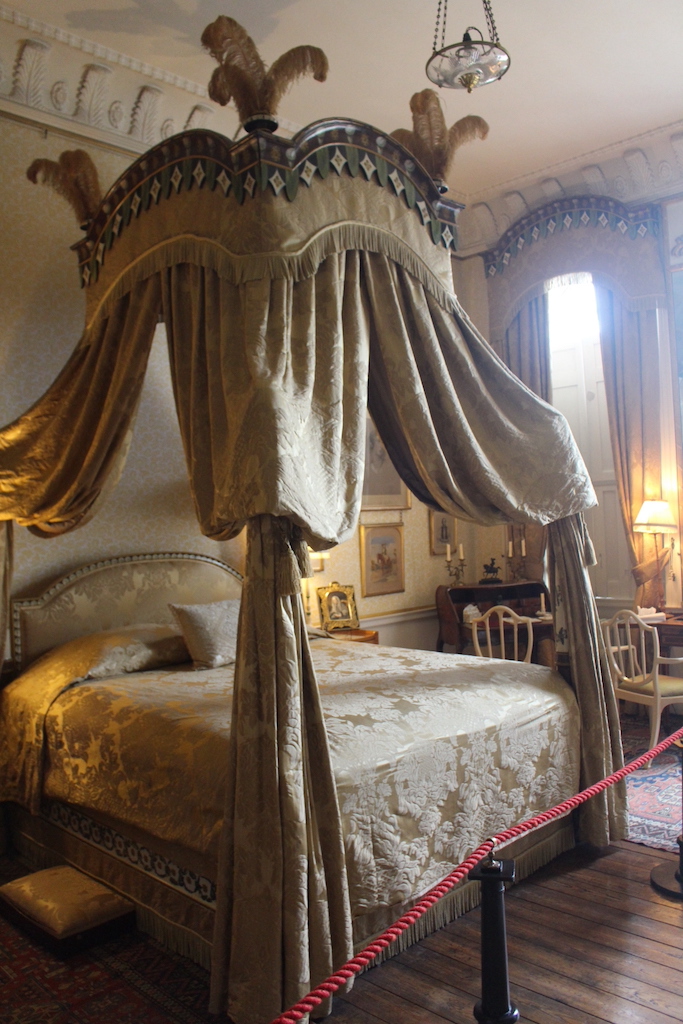
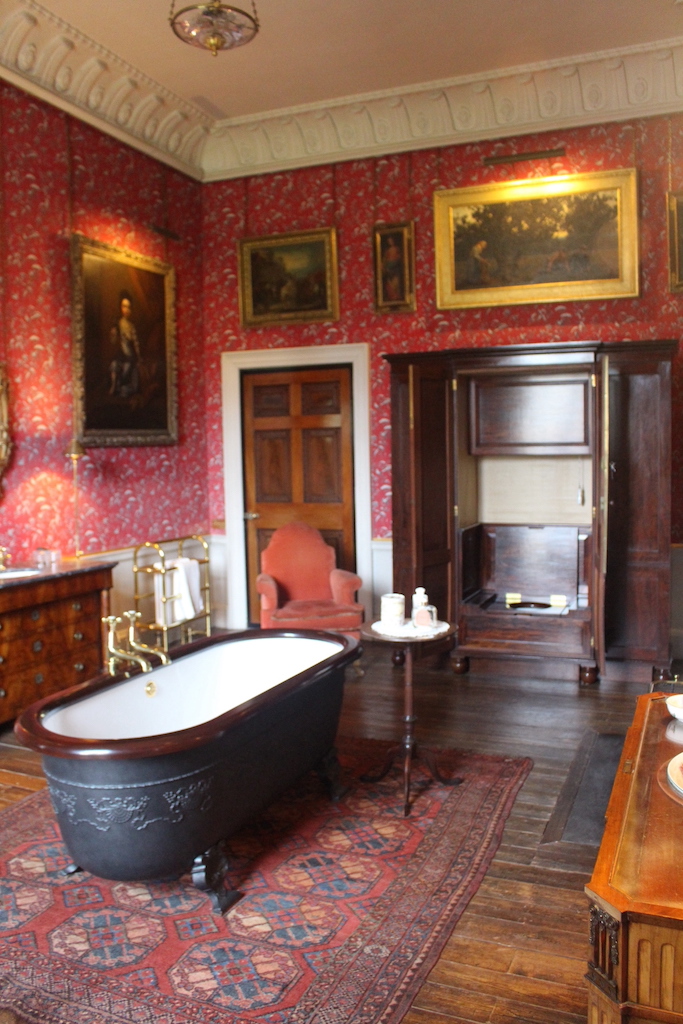
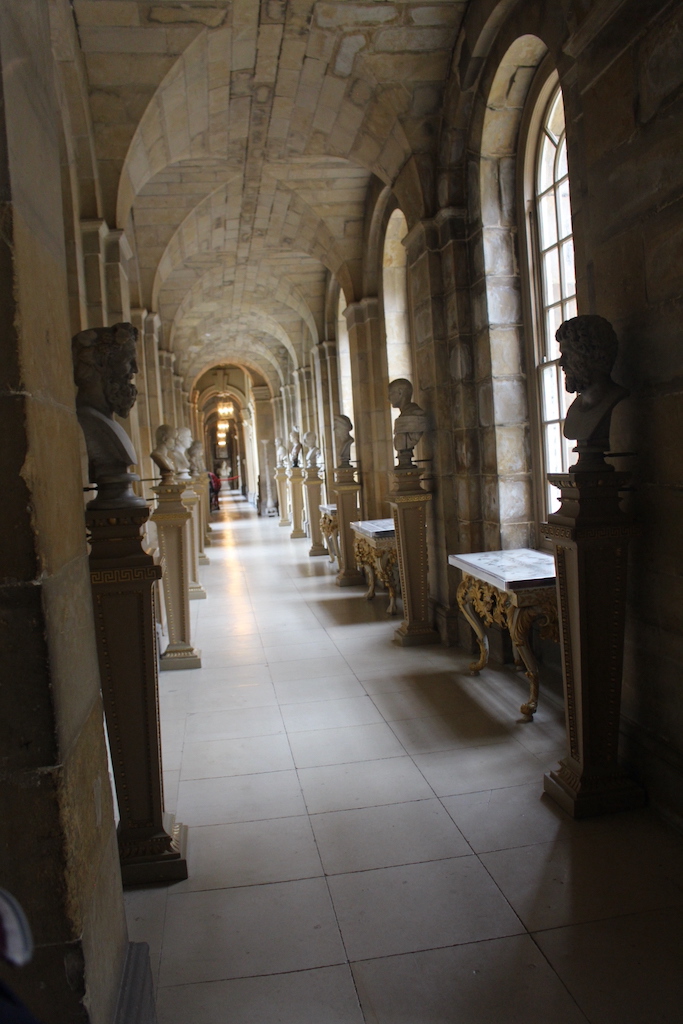
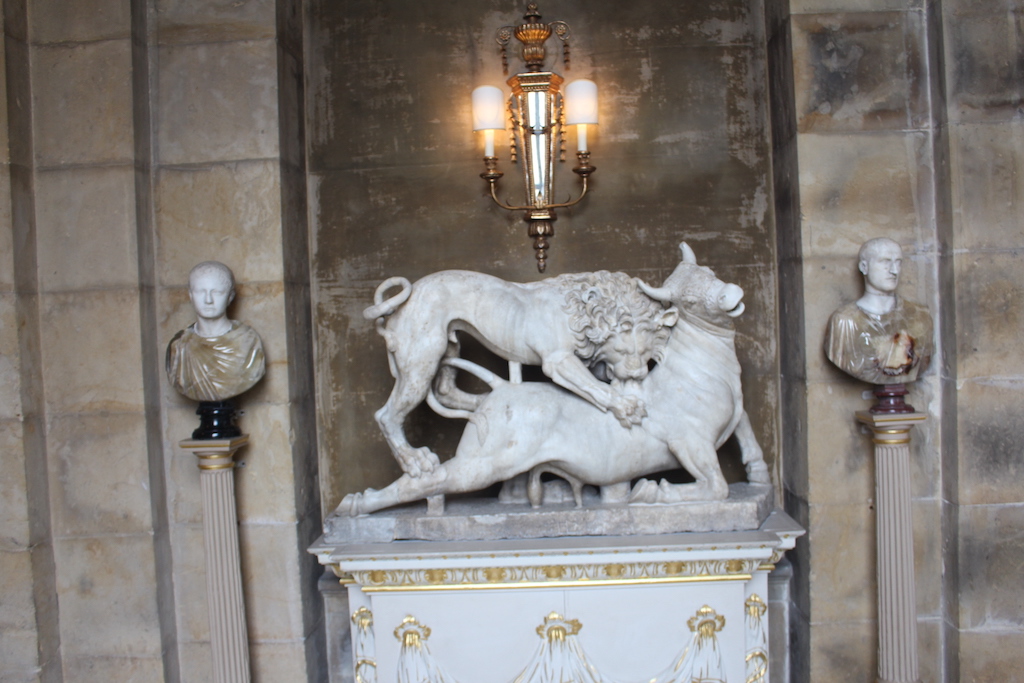
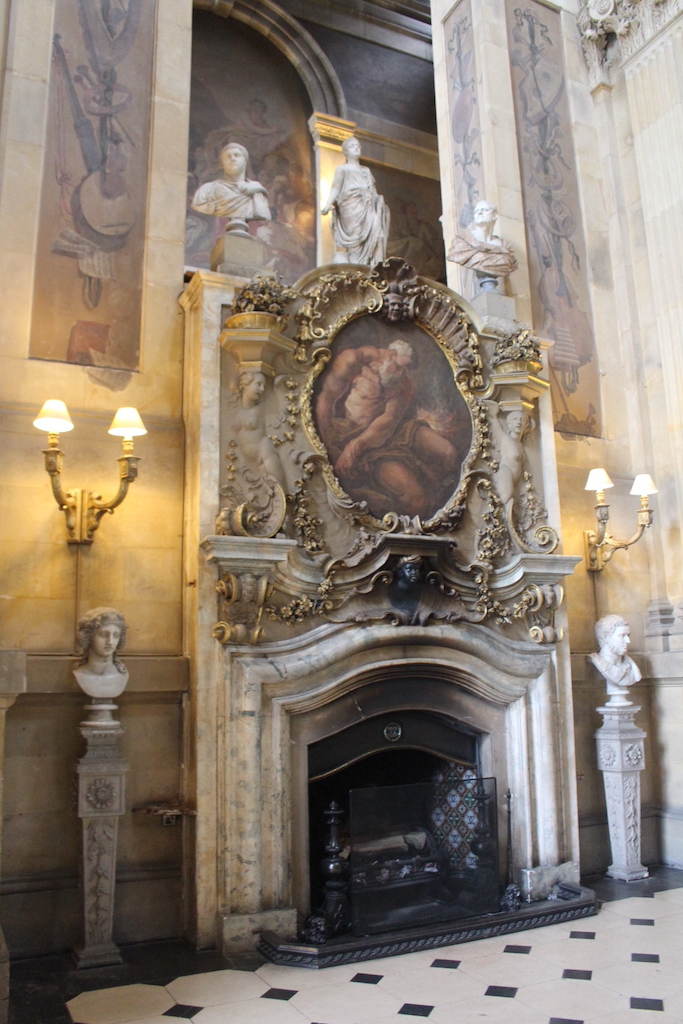
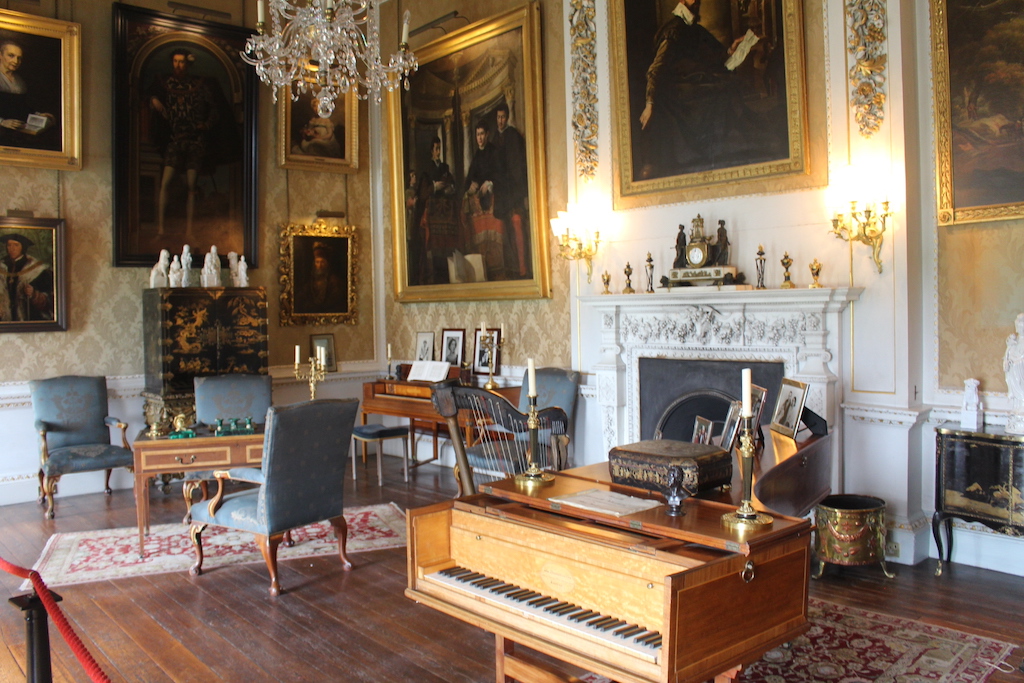
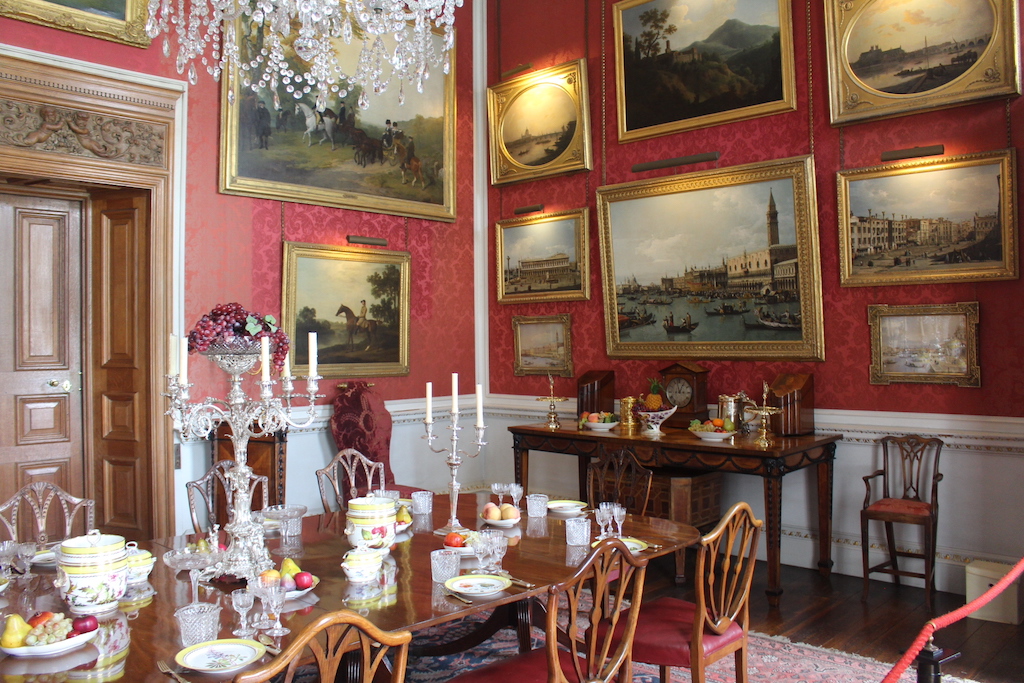
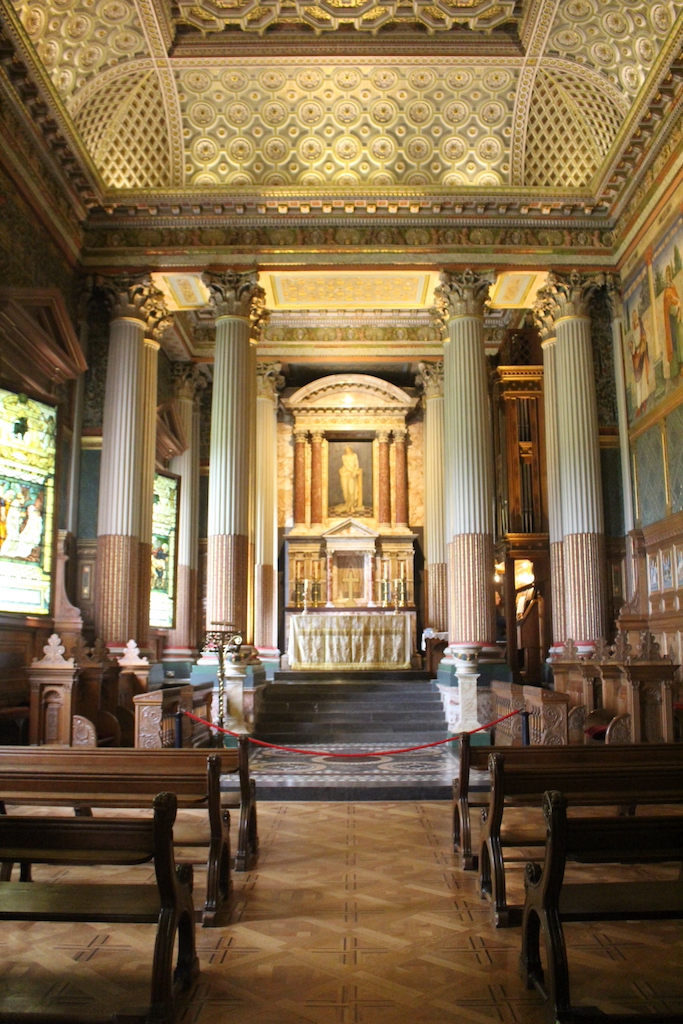
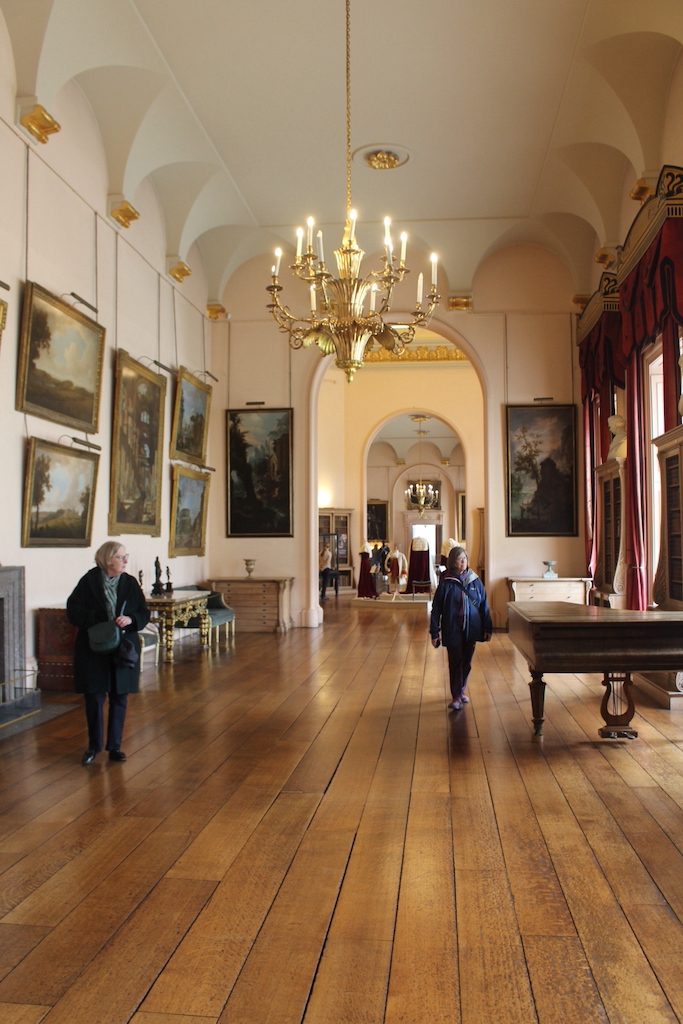
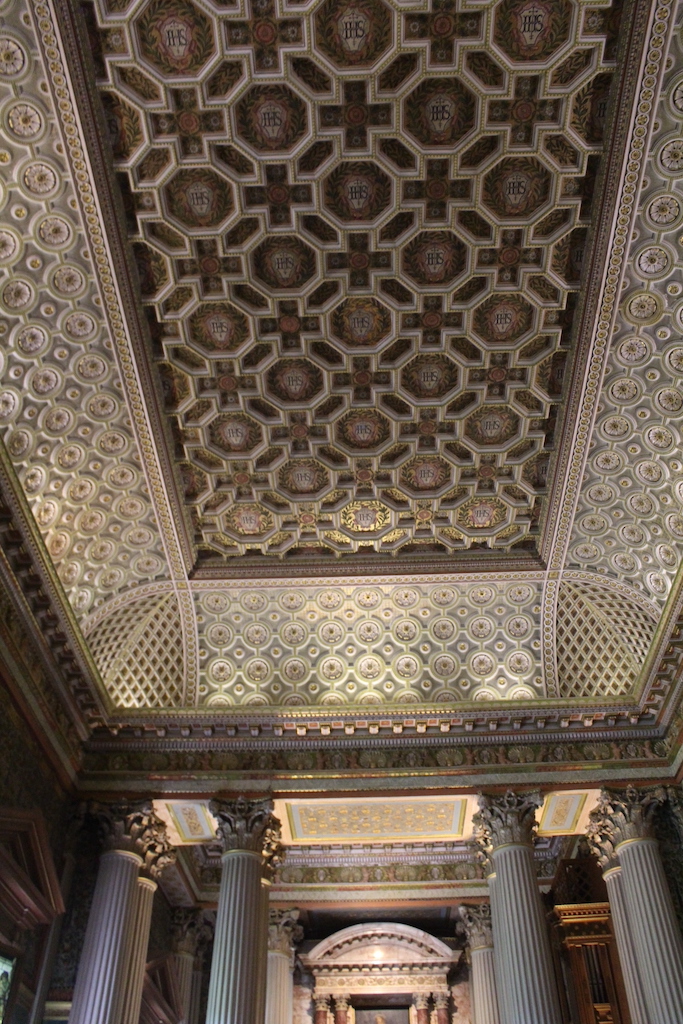
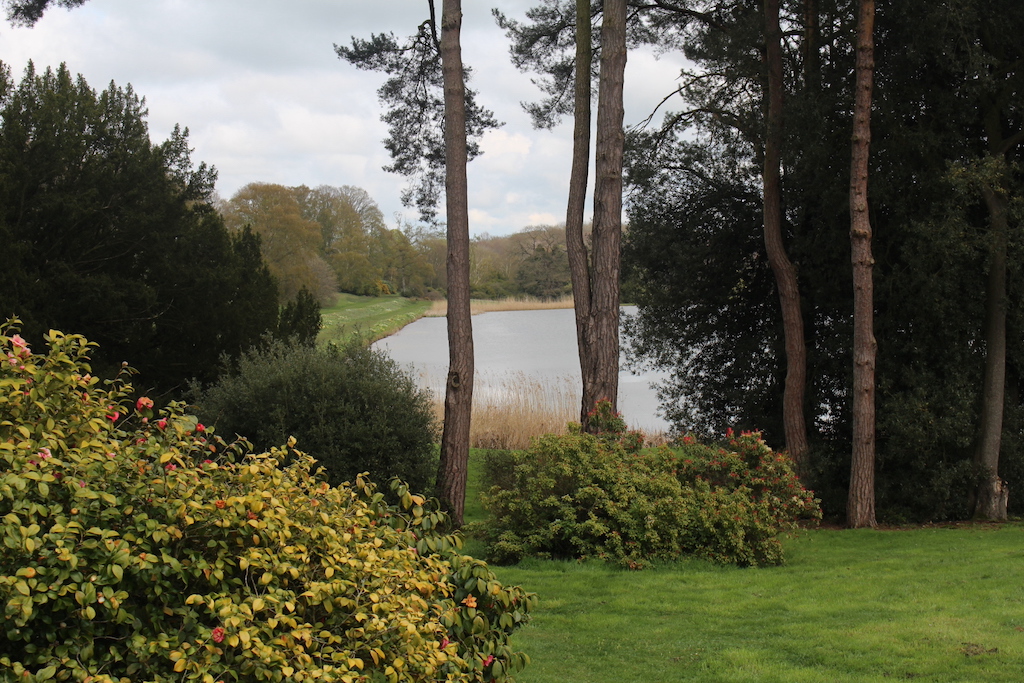
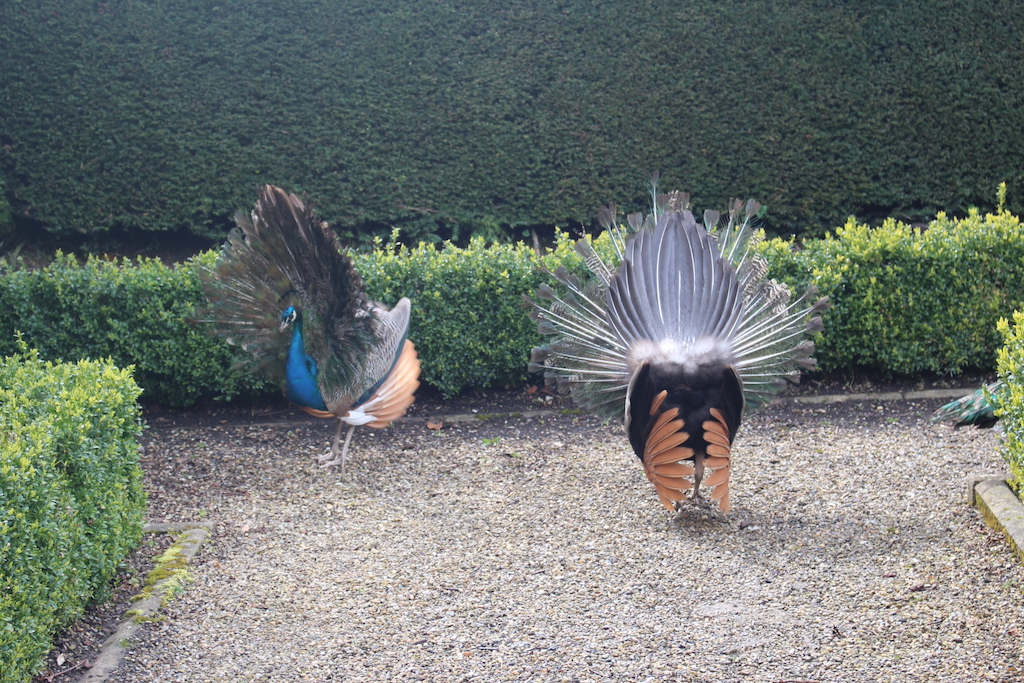
The peacocks were entertaining as we walked through the enclosed garden.
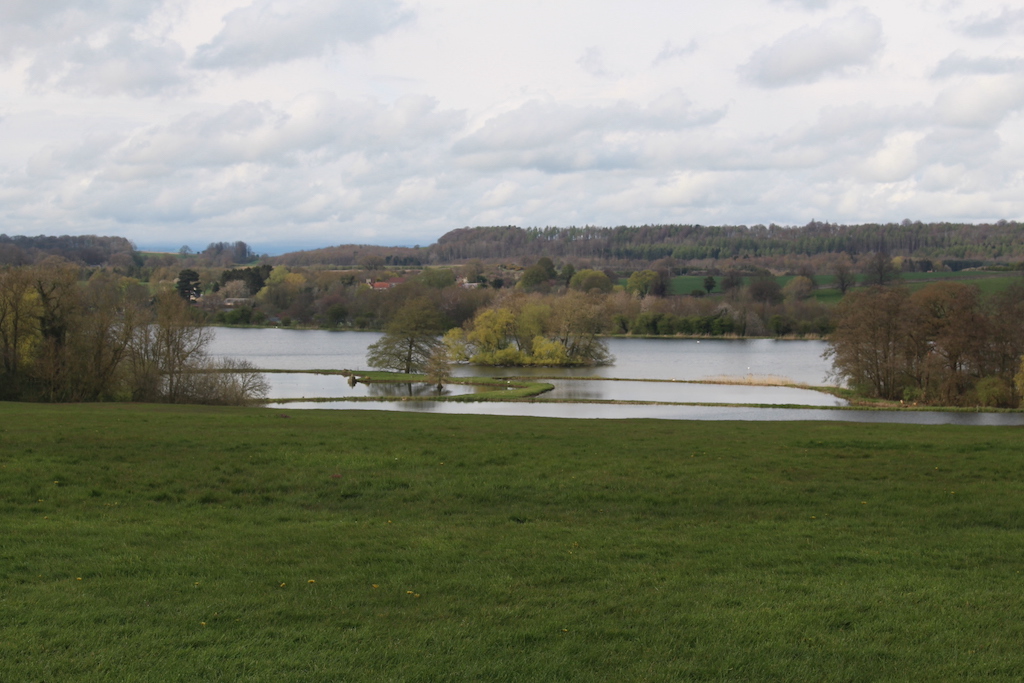
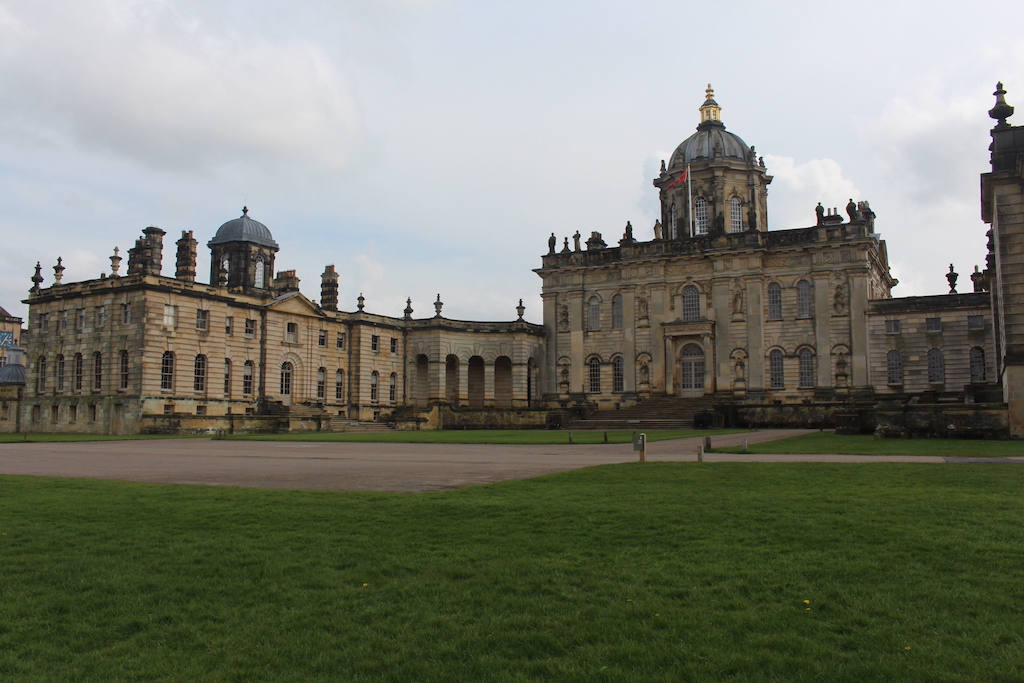
The final full day with Gail was 23 April so we went into in York we took a walk around the city and visited the museum. There is a lot to see. The highlight though, was traditional Sunday lunch at an excellent restaurant – Cafe No.8 Bistro. Blossoms were showing in the gardens.
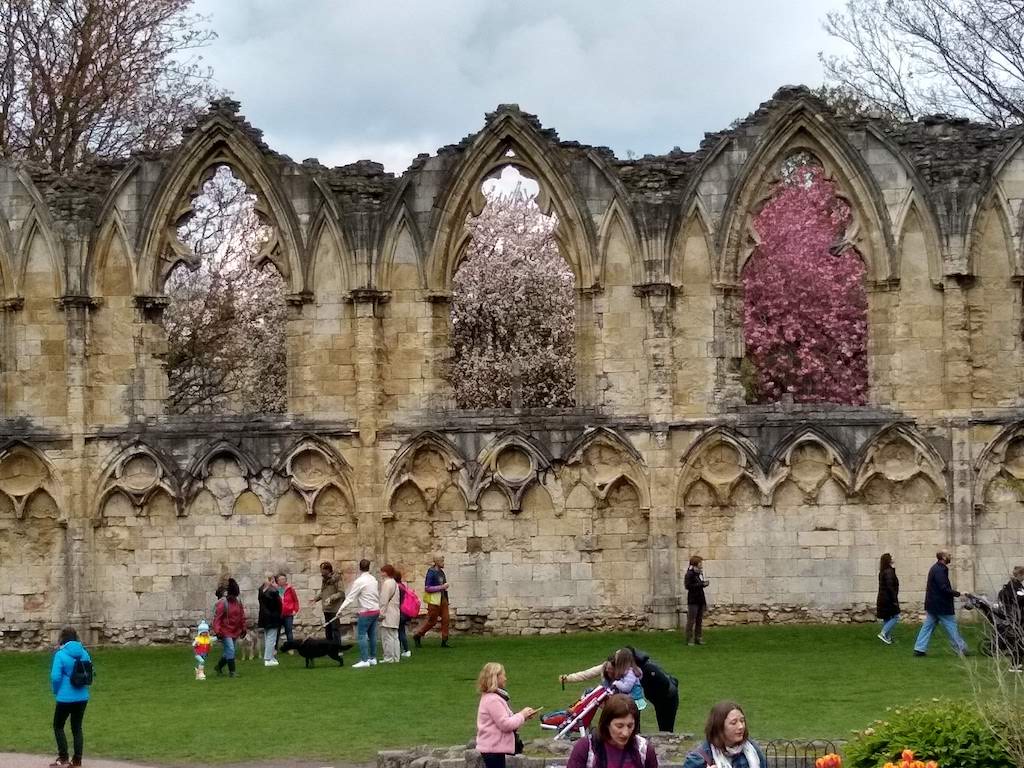
We visited Betty’s Tea room to purchase some traditional gifts. As usual it the were queues for the sit down area, but we just wanted loose tea and other things. Gail bought some biscuits for us to take home. Inevitably, the upcoming Coronation dominated the window display.
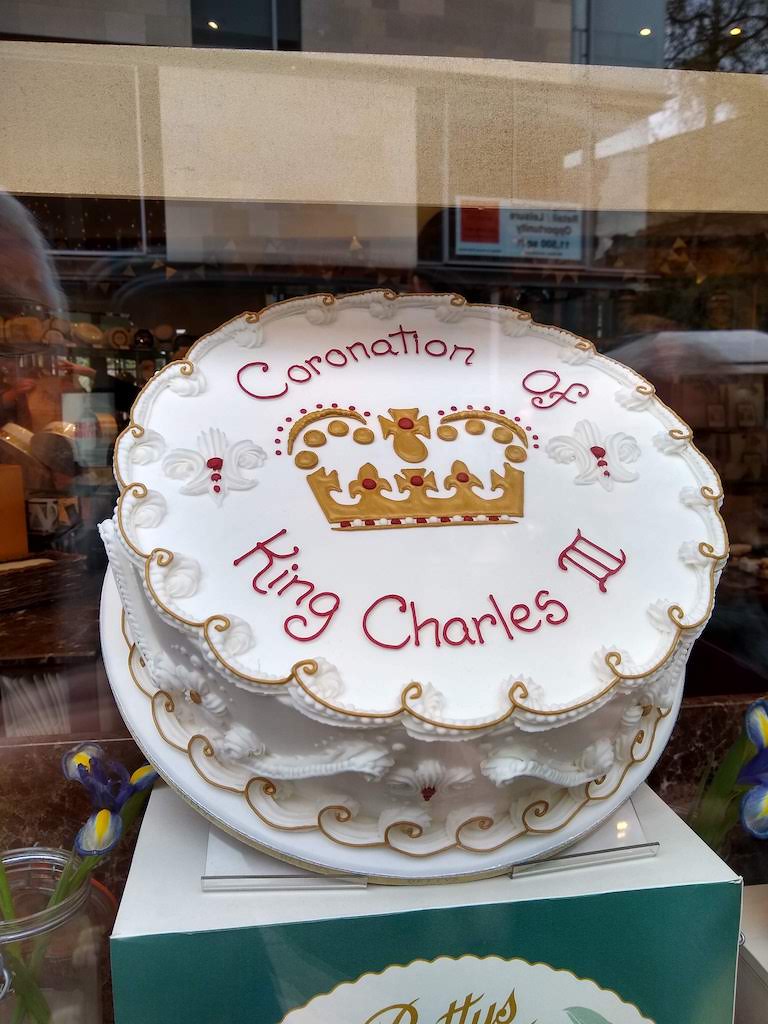
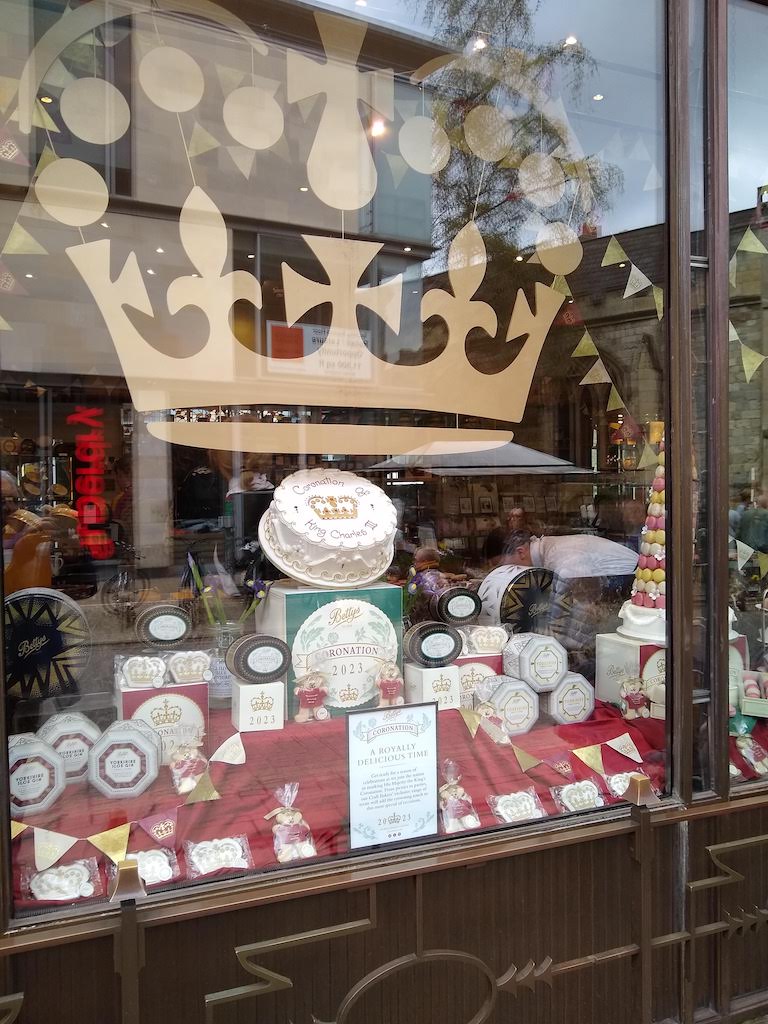
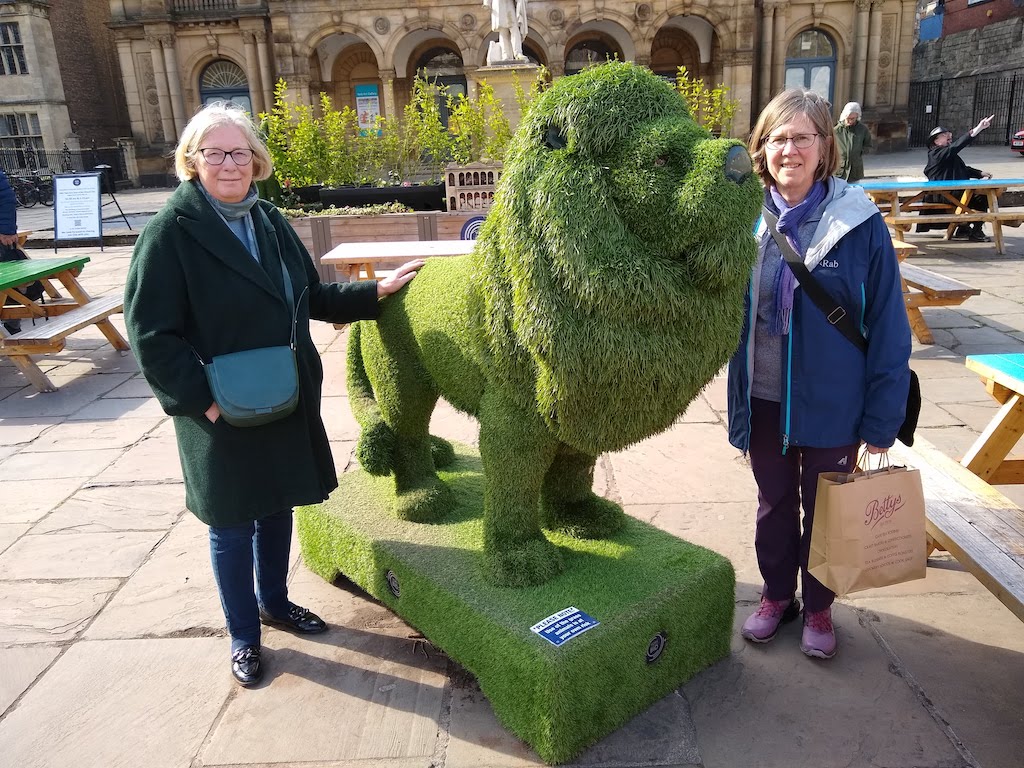
Gail and Betsy posed by this green lion.
24 April saw us braving the traffic once again for the journey back to Bolton and two nights with Phil again before our flight home.
On the way we stopped in Bury to meet up with another of Gordon’s widowed college friends – Pam Haughey. Pam is preparing to emigrate to New Zealand where her daughters live.
That evening Peter Humphries arranged for us to meet a former regular (in the 1980s) member of the Easter Scotland group, Jeff Alsebrook. It was good to see him again and reminisce after about 30 years.
The following day we took the train from Bromley Cross to Rochdale to have lunch with one of Gordon’s distant cousins and her husband, Janet and John Mitchell. the excellent public transport in the greater Manchester area always makes us American residents jealous.
We broke the journey on the way back to take pictures of Betsy posing with our local Bolton, Massachusetts, newspaper in front of sites in Bolton, England. Mainly at the Town Hall and the railway station. We also bought a copy of the local paper – the Bolton News. Bolton, England is a very different place to Bolton, Massachusetts with a population of nearly 200,000 and an industrial history.
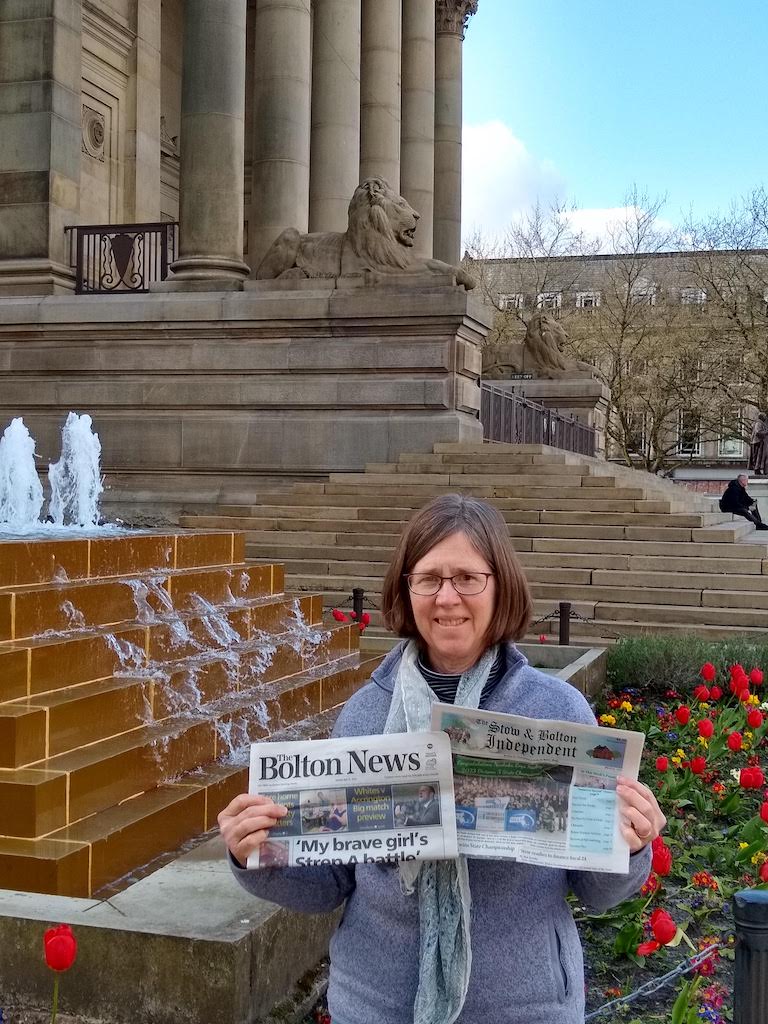
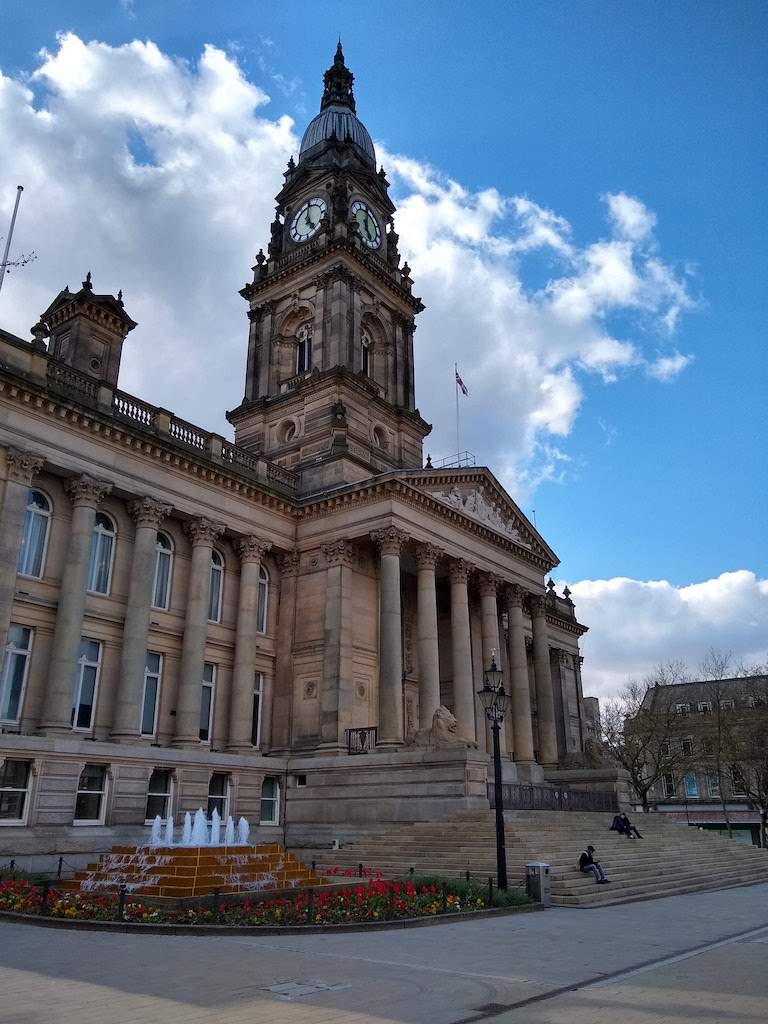
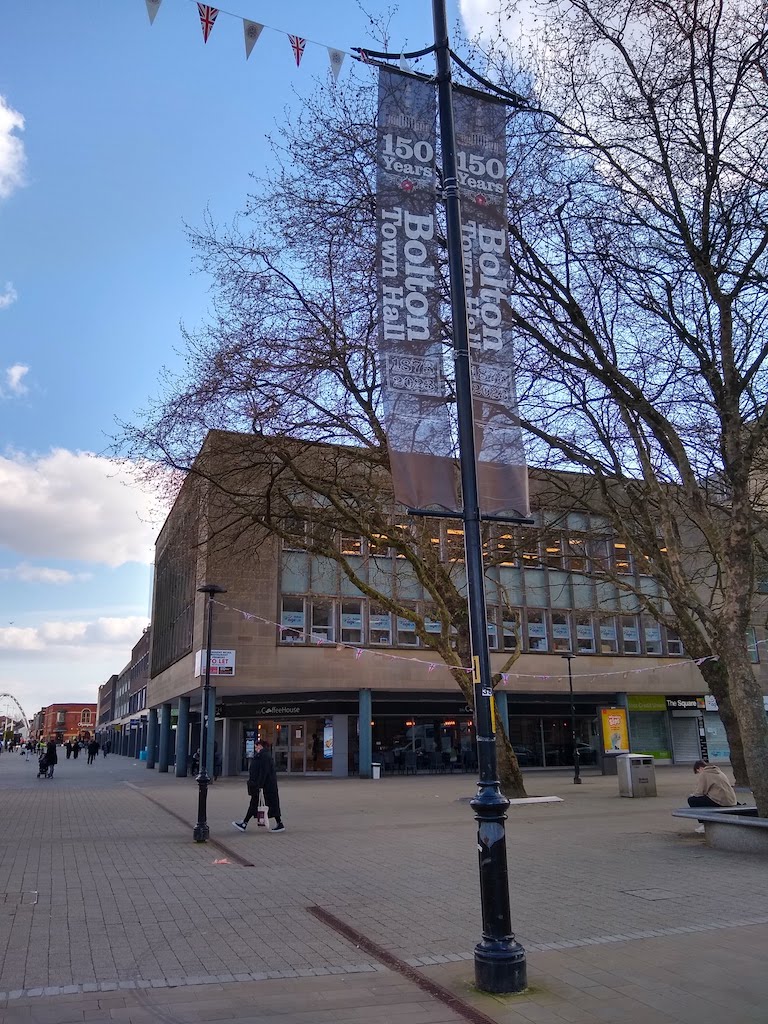
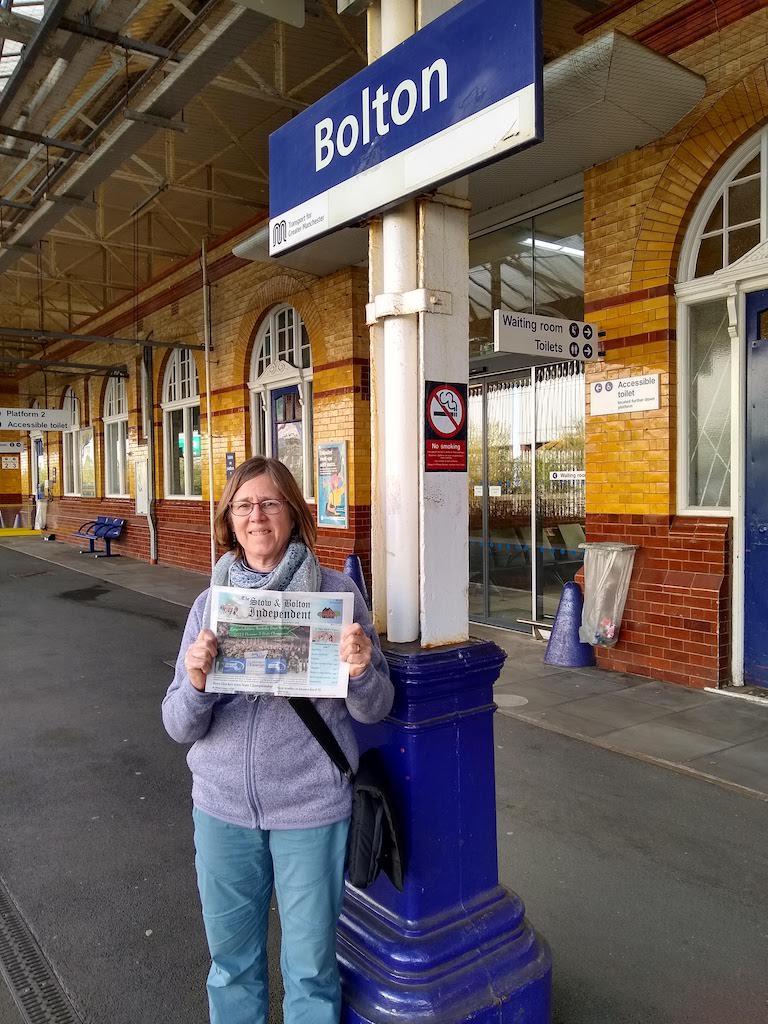
That evening we had dinner at “the Toby” with Phil.
On April 26 we were up early to finish packing, eat breakfast and head to Manchester airport for the flight home.
As always, a great trip with first class company.
